Antarctica in March
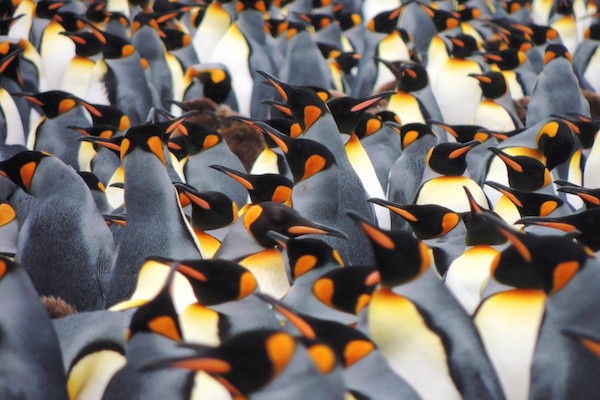
March in Antarctica is the best month for whale watching. You are guaranteed excellent encounters with these gentle giants and fewer ships in the region makes for a tranquil experience .
Temperatures become colder throughout March and the weather becomes more unpredictable, especially in the last two weeks of the season.
Weather conditions change fast in March. The sun sets 15 minutes earlier each day and temperatures rapidly decrease as the month draws to a close.
Because the sun is low on the Antarctic Peninsula in March, it creates amazing sunrises and sunsets when visible. This makes March in Antarctica particularly tempting for photographers.
March in Antarctica is a great time to watch penguin chicks swimming in shallow pools. They are also very curious at this age and many chicks will approach onlookers without fear.
March is the best time to see king penguin colonies on South Georgia . Thousands upon thousands of the brightly colored penguins fill the large bays. This is also the best time to see macaroni penguins.
By March, much of the sea ice has returned, making itineraries such as Crossing the Antarctic Circle no longer possible. Some popular beauty spots such as the Lemaire Channel may also be difficult to reach.
Because March in Antarctica is classed as the ‘Shoulder Season’, Cruise prices are relatively low compared to the high season. Therefore , if you are on a tighter budget and love watching whales, March may be the best time to visit Antarctica.
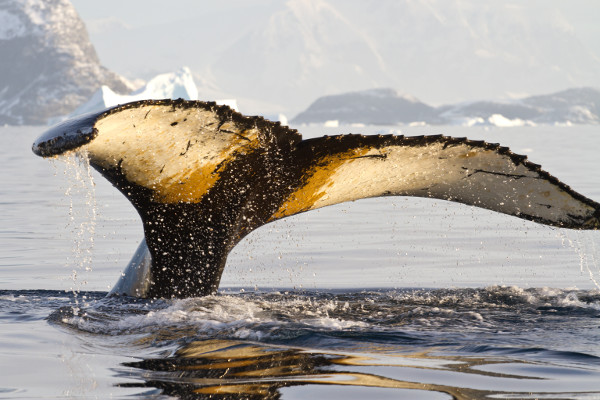

Reasons to visit Antarctica in March
- Whale encounters are at their best and most frequent in March
- The sun is low in the sky, often creating stunning sunrises and sunsets
- Penguin chicks play in the shallow waters and are very curious
- Prices are lower in March
Things to consider
- Weather is more unpredictable in March
- Temperatures rarely exceed freezing and are often well below
- Less itinerary and ship choices
Common Questions regarding Antarctica in March
Am i guaranteed good weather.
No. Weather is never guaranteed in Antarctica. This is especially true in the shoulder months such as March.
Can I fly to Antarctica in March?
The air strip on King George Island closes in mid-February. If you wish to take an express cruise to avoid the Drake Passage then you will need to travel before its closure.
What activities are on offer in March?
Kayaking is still a popular activity in March. However, due to the shorter days, camping is often not possible. Snowshoeing is sometimes possible if there has been thick enough snow fall.
Is March good for wildlife watching?
Yes, Antarctica in March is probably the best month for whale watching . The humpbacks and minkes are very curious in March having finished gorging on krill. Penguin chicks are still playing in pools and king penguin colonies are at maximum capacity in South Georgia.
Is it cheaper to travel to Antarctica in March?
March in Antarctica is known as the ‘Shoulder Season’ and cruise prices are lower because of this. Expect to pay 25% less than you would inn the high season.
Is March in February good for photographers?
Antarctica in March is a great time for photographers due to the shorter days which create mesmerizing sunsets and sunrises.
Get a Cruise Quote, Now!
Antarctica Guide do not sell tours, we simply provide impartial advice . If you would like an exact quote with our recommended specialist click Get a Quote.
If you would like to know more, please leave a comment below and we will endeavor to get back to you within 24 hours! Alternatively, please see our FAQ page here . If you would like to get a cruise quote, please use this form.
Thank you - AntarcticaGuide Team
You may also like...
What penguins will I see on my Antarctic cruise?
What have we learnt from the historic discovery of Sir Ernest Shackleton's ship - Endurance?
South Georgia Explorer: The new South Georgia focused itinerary
Understanding Citizen Science in Antarctica
A day in South Georgia: A personal account
Visiting the Falkland Islands on my Antarctic itinerary: A personal account
What will you see on an Antarctic cruise?
A typical day in Antarctica
Zodiacs in Antarctica: What to expect
If you found this article useful please share it...
* Fields are required. Expect a response within 48 hours. Check your spam / junk for your quote.
I agree that your recommended Antarctica specialist can contact me *

The Best Time To Visit Antarctica – Month By Month Breakdown
- Last Updated: December 12, 2023
Wondering when to visit Antarctica? Having personally visited the White Continent 6 times at different parts of the year, here is a month by month breakdown of what to expect and what it’s like to travel to Antarctica during the summer season of the Southern Hemisphere: November – March.
Antarctica is without a doubt, the wildest and most remote place on Earth.
We’ve been all over the world, spending 15 years travelling to 100+ countries, and we can honestly say that there is nowhere quite like here.
Only the most intrepid people make the trek down to this frozen continent at the globe’s Polar Circle. And it’s not necessarily an easy journey to make!
You shouldn’t just book a trip to Antarctica on a whim. A successful Antarctic expedition requires months and months of careful planning and preparation.
Not to mention, visiting Antarctica is expensive because it is such a rare and unique travel experience.
So if you’re going to spend your hard-earned money on this once-in-a-lifetime journey, knowing when to go is essential to your preparation as well!
Regardless of how rugged and remote the Antarctic Peninsula is, many travellers who make this trip south claim it’s the best trip of their lives.
Landscape photographers, wildlife enthusiasts, and adventure seekers flock to Antarctica for many reasons.
There are vast, untouched landscapes filled with colossal icebergs, fields of pack ice, dramatic displays of light, and icy Antarctic waters.
Penguins, whales, seals, and seabirds thrive in the Southern Ocean and down to the Antarctic Circle.
READ MORE: Discover everything else there is to know about the white continent in our detailed travel to Antarctica guide!
This continent is one of the best places in the world to see whales breaching, fluffy penguin chicks hatching, and seal pups frolicking.
If you’re ready to start planning a trip to the pristine snowy landscapes of Antarctica, it’s important to consider which month you’ll be visiting.
We’ve been at all the usual times – early season, peak season and late season – and know what to expect.
We also get hundreds of emails every year from people wanting to know the best time to go, so we’ve finally put this article together.
This article will serve as an ultimate guide to the best time to visit Antarctica! So read on for a month by month breakdown of the wildlife happenings and weather conditions of Antarctica!
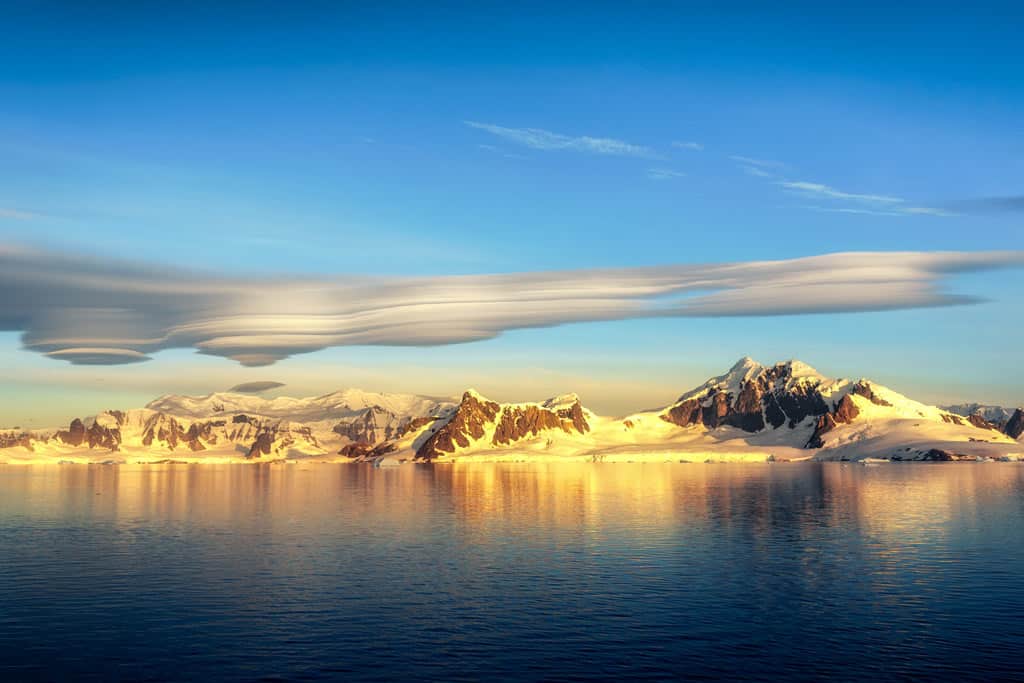
Table of Contents
When is the Best Time to Visit Antarctica?
Best time to visit antarctica conclusions, what is the best month to go to antarctica, when should i visit antarctica.
It’s super important to research the best time to visit Antarctica before you book a trip down to the Polar Circle, so well done for finding your way to this article!
Tourists can only visit during the summer months, and it is recommended to start planning your trip at least 12 months in advance so you can figure out the best time and itinerary to go.
From November to March, Antarctica expedition cruises run frequently. But each month offers something a bit different!
After our very successful tour to Antarctica this season, we are going to be running another exclusive adventure down to the Peninsula in 2025, this time crossing the Antarctic Circle! Check out the Crossing the Antarctic Circle photography tour page if you’d like to learn more.
The best months for whale watching may not be the best months for seeing baby penguins for example.
Cooler temperatures mean massive icebergs, but warmer temperatures mean less sea ice and therefore further exploration into the Antarctic Circle.
Be sure to check out our list of what to do in Antarctica to help you prepare for your trip!
We will give a detailed explanation of each month in Antarctica and what that means for wildlife movements, trip costs, and landscapes!
Some Antarctica trips also include visits to nearby islands like South Georgia and the Falkland Islands, so we’ll mention some of the important happenings there as well.
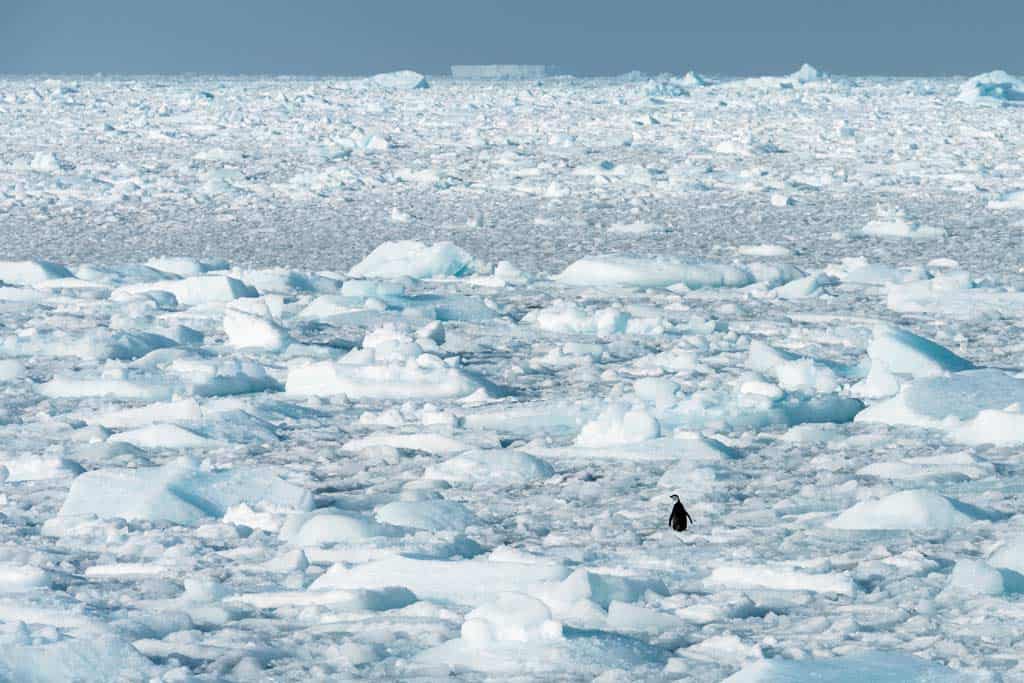
Antarctic Summer Season – Month by Month Breakdown
This guide to the best time to visit Antarctica will only cover the ‘summer months’: November to March.
Some Antarctic cruises may begin in late October, but it’s pretty rare. And the ones that do are usually on a mission into the Weddell Sea to visit the emperor penguin colony at Snow Hill, which is a very different and costly expedition.
We would recommend visiting Antarctica no earlier than November.
Many people also wonder about crossing the Drake Passage , and whether this notoriously rough patch of ocean is calmer at certain times of the year.
Unfortunately, the infamous Drake Passage can be turbulent at any time of year, so you’ll just have to conquer that obstacle regardless.
Trust us though, it’s part of the experience and despite potentially being seasick for a few days, it’s a badge of honour you can always wear proudly.
With today’s modern ships (unlike Shackleton’s Endurance ) and sophisticated safety measures, crossing the Drake Passage isn’t necessarily dangerous, it’s just a bit rocky.
Just pop some motion sickness pills, relax, and enjoy the ride! You’ll be in Antarctica in no time!
Here is what you can expect when you arrive, depending on which month you visit.
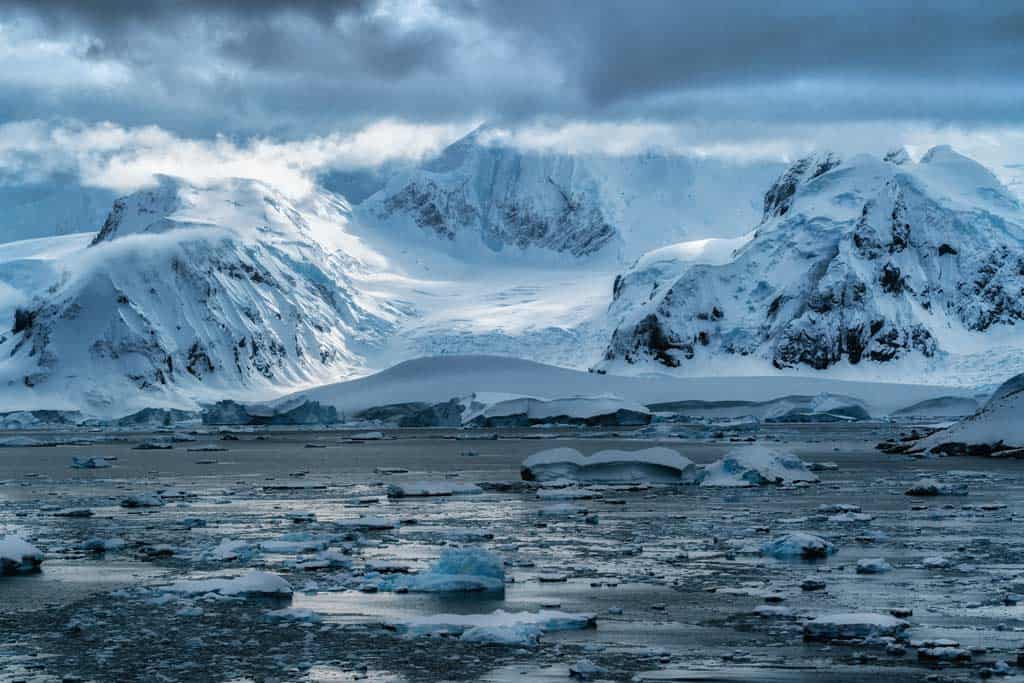
November marks the start of the tourist season in Antarctica. That means relatively low prices and fewer tourists on the continent.
Cruise ships are just starting to arrive, and the wildlife is only just starting to become more active after a harsh winter.
Temperatures are still below freezing, snow levels are high, and icebergs are huge.
The plus side of these cold temperatures?
In November Antarctica’s landscape remains very much pure and untouched, with blankets of snow everywhere.
In a usual year, this is the only time to see significant blocks of sea ice before they start to melt over the summer.
The November sun is still quite low in the sky, which makes for spectacular sunsets.
Because of all these facts, our personal thoughts are, and many would agree that, November is the best time to visit Antarctica for landscape photographers!
In terms of wildlife, mating season is beginning for many species. Penguins begin mating and laying eggs.
You may even see some females waddling around with their eggs balanced on their feet.
In South Georgia, you’ll get to see elephant seals courting, which is a special, dramatic and confronting scene.
READ MORE: Want to see the huge king penguin colonies in South Georgia? Check out our expert guide on the best time to visit South Georgia !
And in the Falkland Islands, November is a great time to see wildflowers and active seabirds.
In late November, prices rise and tourism ramps up as the weather starts to get warmer!
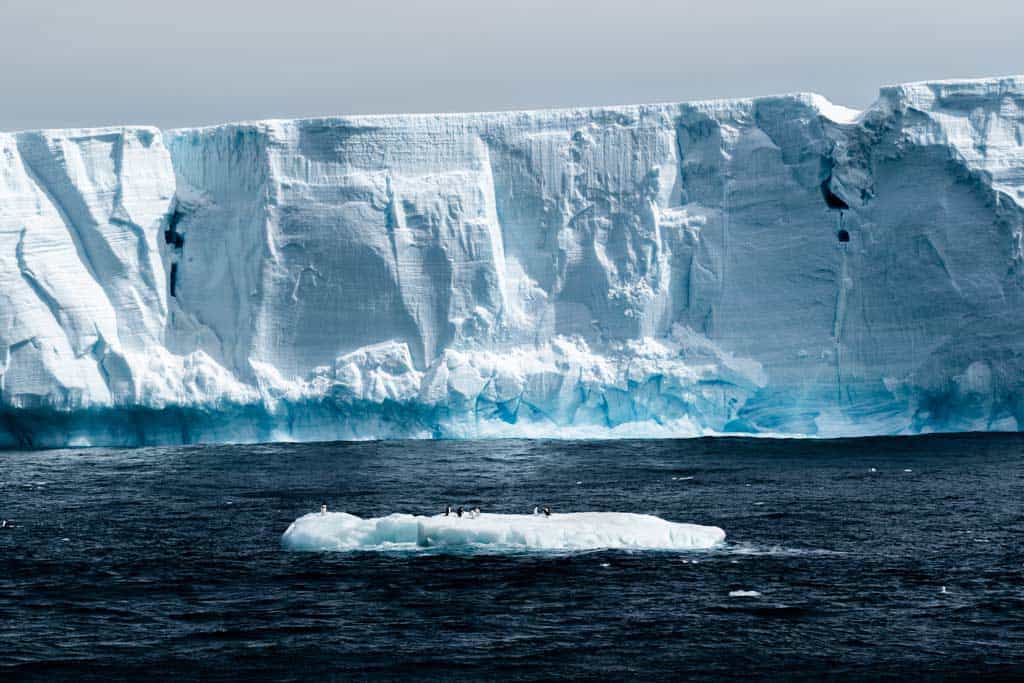
If you had to pick the absolute best month for visiting Antarctica, December might be it.
Temperatures warm up to around 0 degrees Celsius! Yet because the summer has only just begun, you can still see some large icebergs lingering from winter.
By late December, the summer sun is in full swing. The sun rises and barely sets, leaving around 20-22 hours of daylight the further south you get.
Warmer weather and longer days mean ample time for exploring Antarctica. It also means that wildlife becomes extremely active, so get your cameras ready !
Migrating whales begin to pass through the Antarctic waters, ready to feed on nutrient-rich organisms in the cold ocean.
Humpback whales are starting to become more common, having finished their migration south from the tropics.
Penguin chicks are also starting to hatch! You can see baby penguins in early December on the Falkland Islands, though the chicks are more frequent towards the end of the month on the Antarctic Peninsula.
In South Georgia, elephant seal pups are born and courtship rituals for seabirds are common.
There is also an airstrip on King George Island that opens up in December if you’d rather fly to Antarctica than sail through the tumultuous Drake Passage.
A fair warning though – weather is unpredictable and flights aren’t 100% guaranteed, so you do run a risk that your trip may be shortened if the planes can’t land.
So in our personal opinion, December is arguably the best time to visit Antarctica, due to the warm weather, long days, and active wildlife. Keep in mind, this is also one of the most expensive times to visit Antarctica!
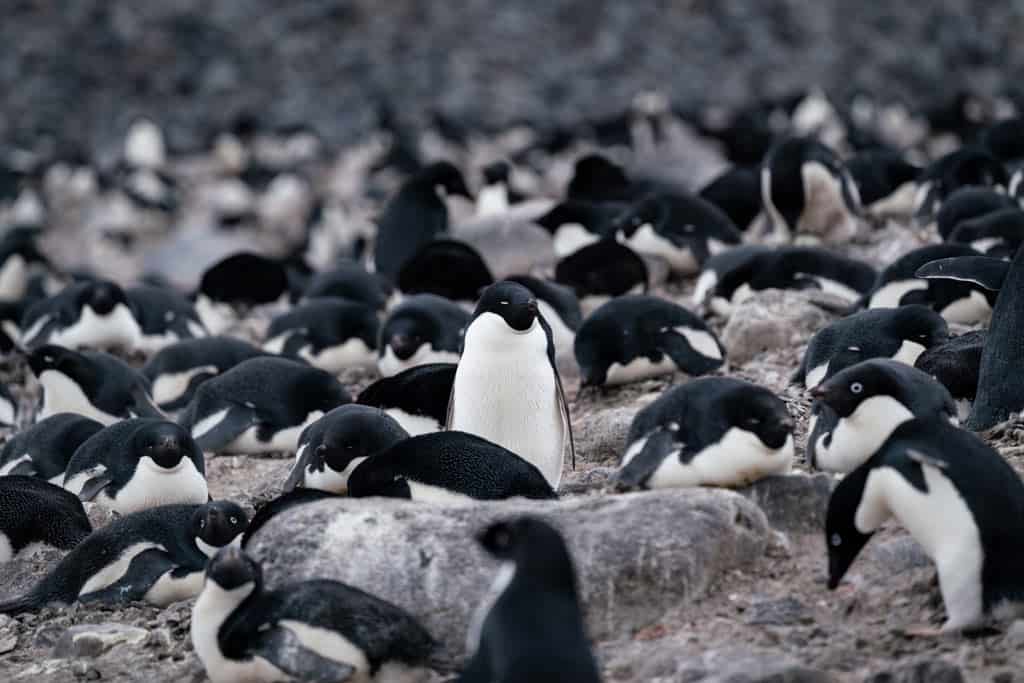
January is also considered peak season for travelling to Antarctica.
With almost 24 hours of daylight and temperatures around 10 degrees Celsius, many would consider January to be the best time to visit Antarctica.
This is the best time for land expeditions, as the snow and ice have receded, opening up more landing opportunities, and warm temperatures make hiking, Antarctica camping , and exploring more comfortable.
January means that sea ice breaks around the Antarctic Peninsula as well. So cruise ships can venture further into the continent, and the Ross Sea opens up for access.
Cruises into the Ross Sea are very exclusive. They are rare and expensive, but those who make the journey into the elusive Ross Sea can see the historic huts of previous explorers like Scott.
January is also the best time to see newborn penguin chicks on the Peninsula! These adorable critters are at their fluffiest in January, and the adult penguins are introducing their babies to the world.
You can also see penguin chicks in South Georgia. King penguins, gentoo penguins, macaroni penguins, and chinstrap penguins are common species to see on the island.
Seals and seal pups are also very active in both Antarctica and South Georgia. Fur seals are in the breeding season in South Georgia and therefore can be quite aggressive, so many operators struggle to make landings to ensure visitors keep their distance.
Whale sightings are also likely in January. Fin whales, minke whales, and orca whales make frequent appearances, though humpback whales are the most common ocean giants at this time.
READ MORE: Check out our list of the most interesting Antarctica facts we’ve learned!
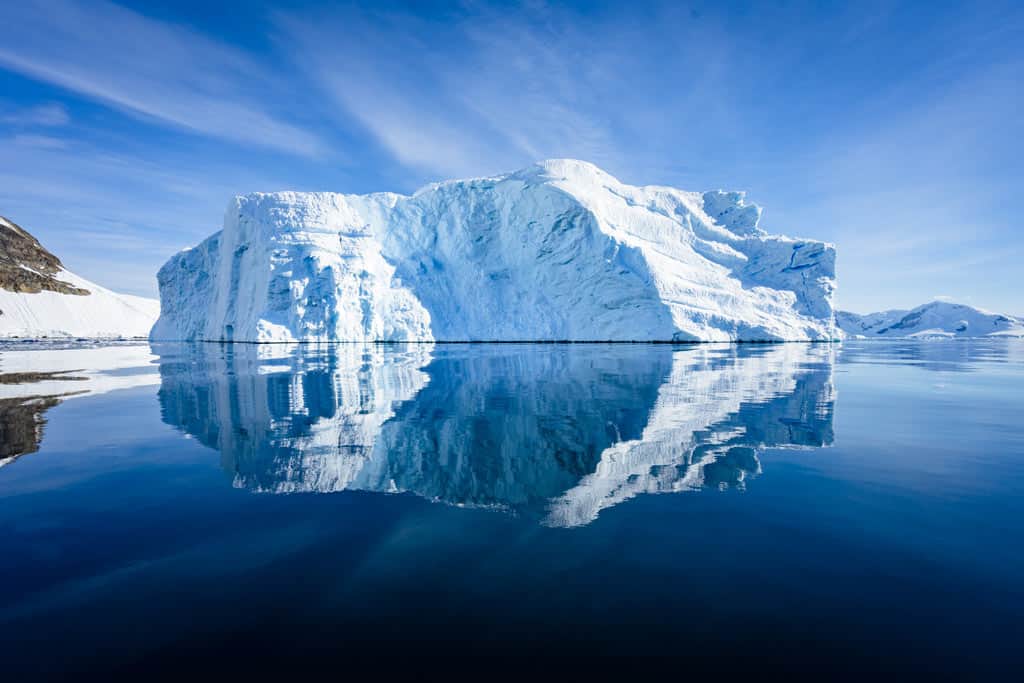
As February approaches in Antarctica, summer is nearing its end. But temperatures are still quite high and sea ice and snow continues to shrink.
Sea ice is actually at its lowest in February. That means cruise ships can cross the Antarctic Circle with relative ease, and the Ross Sea is still open for access.
Penguin chicks are a bit older, meaning they’re more active and more inquisitive! You’ll often see parent penguins diving in and out of the water to find food for their growing chicks.
Active penguins also mean active predators. Orcas and leopard seals are easier to spot in February, as are fur seals and elephant seals.
February also offers amazing whale watching. Minke, sperm, southern right, and humpback whales are frolicking through the Antarctic waters, and blue whales might even make an appearance.
Seabirds are also playful in the late Antarctic summer. In South Georgia, you can even visit exclusive albatross nesting sites.
February offers great conditions for sailing and water activities like kayaking , though temperatures begin to drop later in the month.
One thing to consider though is that as there has been warmer temperatures and very little snow over the summer, many of the main landing sites will now be quite rocky and muddy.
They’ve also had thousands of people walk there before you, so the pristine feel is starting to fade and from a photographer’s perspective it’s not quite so unspoilt.
That’s not to say February is a bad time to go. The extra wildlife activity more than makes up for it.
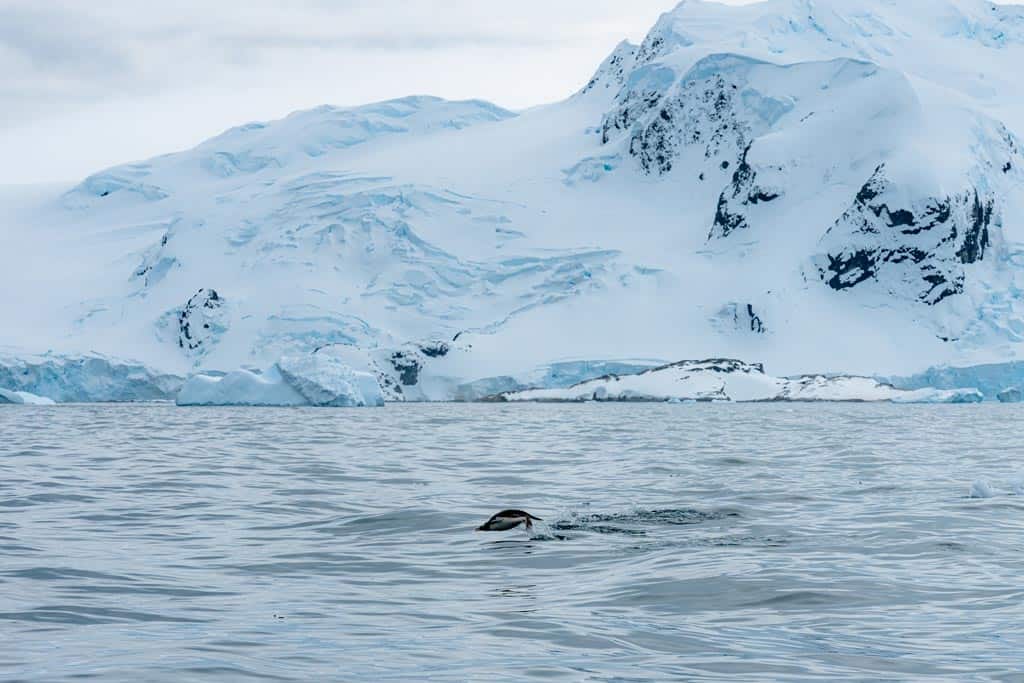
March marks the end of the tourist season in the Antarctic Peninsula.
Temperatures start to get colder, daylight hours shrink creating epic sunrises and sunsets, and the weather starts to shift.
That also means there are fewer ships in Antarctica, and tour prices drop significantly.
By March, penguin chicks are a bit older and more curious. They’re often not afraid to walk right up to humans, so wildlife photographers will have a blast.
Baby penguins are molting as well, meaning they shed their grey fluff. Because snow cover is at its lowest since November, the landscapes aren’t as pristine in March as they were earlier in the season.
But March is by far the best time for whale watching in Antarctica!
Whales will have been feeding heavily for a couple of months now, so by March they become more playful and less focused on food.
It’s common to see whales breaching, and sometimes whales will even come right up to boats and kayaks to investigate what’s happening on the surface.
Fur seals and leopard seals are also still visible in March.
Sunrises and sunsets are more colourful as well because the sun is dropping lower in the sky again.
Don’t let the late season deter you – March is still a great time to visit Antarctica.
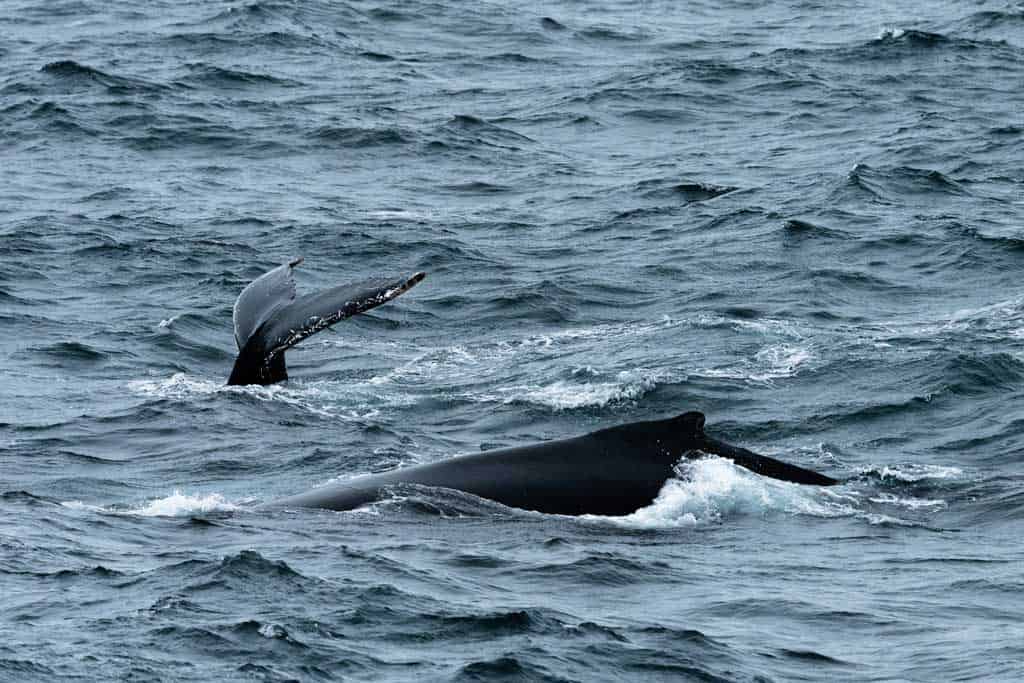
Can Tourists Visit the Antarctic Peninsula in Winter?
Though it’s not actually prohibited, tourists can’t really visit Antarctica in the winter.
During winter in the Southern Ocean, conditions are just not suitable for tourists to visit. The hours of daylight decrease rapidly.
By the peak of winter, the sun doesn’t rise at all, leaving the continent in complete darkness.
Temperatures are often -50 degrees Celsius, and snow and ice storms are common. Sea ice covers all the normal points of entry for ships as well.
You won’t find any Antarctica cruises running until late October, and this isn’t really a place where normal public transport exists! So tourists don’t have any reason to visit Antarctica in winter.
Many would consider late December or early January to be the best months to visit Antarctica.
Weather conditions are at their most favorable, with warm temperatures, low levels of pack ice, and long daylight hours. Wildlife is also very active, both in Antarctica and on neighbouring islands like South Georgia .
However, the early season and late season both have much to offer as well.
November is the best season for landscape photographers. The icebergs are still mighty, the snowy landscapes are still preserved, and the low sun makes glorious colors at sunrise and sunset.
February and March are the best months for whale watching! If you visit in the cooler months, just make sure you pack appropriately so you can stay warm.
So no matter which month you visit, you will find something special in Antarctica.
The best month to go to Antarctica depends on what you are looking for. November is great for pristine landscapes, December and January is perfect for stable weather and penguin chicks, and February and March are the best time for whale watching.
In our opinion based on multiple trips at all times of the summer, you should visit Antarctica based on what you want to see – Unspoiled landscapes in November, abundant wildlife in December and January, and whales in February and March.
Alesha and Jarryd
Hi, We’re Alesha and Jarryd!

We’ve been traveling the world together since 2008, searching for the planet’s best destinations and adventures.
Love Travel?
Sign up for our free weekly newsletter for the best travel tips, ideas and deals!
We respect your privacy. Unsubscribe at any time.
READ MORE...
Our 15 Best Travel Tips from 15 Years on the Road
Best Antarctica Cruise – Ultimate Guide to Who & How [2024]
17 Awesome Things to Do in Antarctica (2024 Guide)
Related Posts
Guide to buying a motorbike in southeast asia, discovering sustainability at ecocamp in torres del paine, back to nature – phong nha’s eco conservation tour, gear review – pacsafe v9 camera bag, 1 thought on “the best time to visit antarctica – month by month breakdown”.
Great information! Thank you. Can you offer an educated, experienced opinion on the percentage success rate of crossing the 66 in March? In some places, I read that ice is reforming as temperature drops, and it gets colder as we sail south. Is it like 80% success rate in January, but drops to 60% in March?
Leave a comment Cancel reply
Save my name, email, and website in this browser for the next time I comment.
Best Time to Visit Antarctica

So, you want to travel to Antarctica, but you are wondering when to go. The Antarctic travel season coincides with the austral summer beginning in October and running through March. Many travelers ask us “When is the best time to visit Antarctica?” or “What is the weather like in Antarctica in January?”
The best time to visit Antarctica is from mid-December through mid-February. The best month to take an Antarctic cruise is January. Of course, there is much more to it than that. The Antarctic travel season is short. Weather, wildlife, sunlight and sea conditions vary greatly between spring, summer and fall.
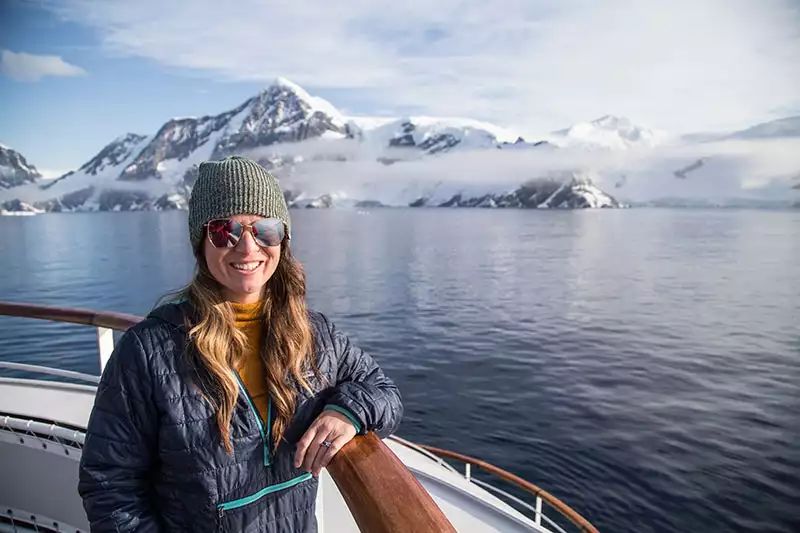
IN THE KNOW ON WHEN TO GO
Expert insights, delivered to your inbox.
IN THIS POST – Best Time to Visit Antarctica: Antarctica Seasons Month By Month: – Oct , Nov , Dec , Jan , Feb , Mar Best Time for: – Drake Passage & Cruising – Penguins & Whales Why Latitude Matters Antarctica Climate Tables What Is the Best Month in Antarctica? More Resources
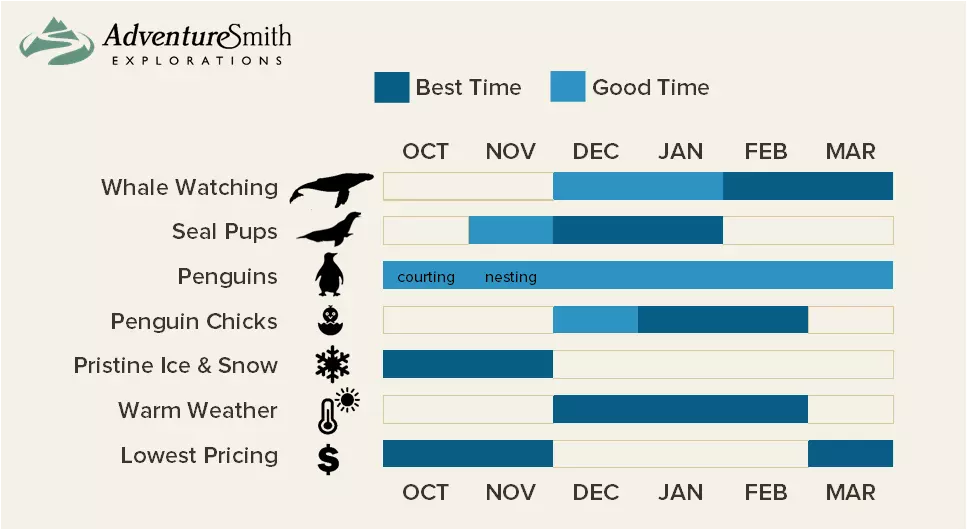
Antarctica Seasons: When to go & Why
Below we outline best seasons for Antarctica and what to expect during each Antarctic season. Remember that in the Southern hemisphere the seasons are opposite of those in North American and Europe. Winter in the northern hemisphere is summer in Antarctica.
Antarctic Spring
Spring in Antarctica begins in late October and runs through November. Antarctica in spring is characterized by cold temperatures, snow and frozen sea ice. Sea ice is at its maximum, an average of 22 million square miles, which can restrict where ships are able to go.
In the early Antarctic spring, most wildlife has not yet emerged, except for Emperor Penguins, which have overwintered on the ice. Specialty trips to view Emperor penguin colonies are sometimes offered in November.
The season to visit Antarctica begins in earnest in November. Mid to late Spring in Antarctica is characterized by the icy landscape awakening. Days are getting longer and temperatures are warming. Sea ice is common, and penguins are starting to arrive to build nests.
Antarctic spring is the best time to go to Antarctica for skiers, snowboarders and photographers set on massive icebergs and icy, white landscapes.
Antarctica Summer
Antarctica in the summer is spectacular and this is the peak of the travel season. Summer in Antarctica begins in December and runs through January. The temperature in Antarctica in the summer is surprisingly mild with highs in the 50’s F and lows in the 20’s F.
Sea ice is melting and gone by the end of Antarctic summer. This opens bays, inlets and passages south to the Arctic circle. Spring storms abate and summer in Antarctica offers a better chance of calm seas while crossing the Drake Passage.
Penguins and wildlife are most active during the Antarctic summer. Depending on latitude, (more on why latitude matters below) penguins lay their eggs in early summer and chick are born in mid-summer. Seabirds are feasting on the ocean’s bounty. Seals have come ashore to give birth to pups. Whales begin to arrive to feed on rich seas.
Antarctica Fall
Autumn in Antarctica begins in March and ends by April. Days are getting shorter, temperatures are falling and the travel season winds down by late March. Sea ice is greatly reduced from 22 million miles of sea ice in September to only 5.4 million square miles of sea ice in September. This means more bays and inlets are available for ships and the polar circle is more easily reached in the fall.
Fall in Antarctica is the best time to view whales. Ice free waters, enriched by the summer sun, provide a bounty of krill and small fish which by now have attracted large pods of migrating whales. Penguin parents have left for the open sea and chicks are ready to follow. Seal pups are also heading into the ocean and can be a target for Orca whales.
Photographers seeking spectacular sunsets love the fall Antarctic season. Visitors may also catch a glimpse of the aurora australis or southern lights during dark nights.

Antarctica Weather & Wildlife by Month
What follows are detailed insights into Antarctica weather and wildlife by month for the entire travel season. Our expert compile their advice to help you determine the best time to visit Antarctica. Antarctica temperature listed below in Fahrenheit.
Antarctica In October
Be among the first to witness Antarctica as it awakens from the long winter. Antarctica in October is pristine, cold and a skier’s dream with white-capped peaks. We consider this the best time to go to Antarctica for skiers, snowboarders and photographers set on those icy, white landscapes. Specialty trips to view emperor penguins are sometimes available in October.

Antarctica Weather in October
- Average temperature in Antarctica in October: 22-29 degrees & 14 hours of daylight
- South Shetland Islands Temperature in October: 17-25 degrees & 15 hours of daylight
- South Georgia Island Temperature in October: 28-41 degrees & 14 hours of daylight
Benefits Visiting Antarctica in October
- Abundant sea ice, dynamic ice floes, large icebergs, all excellent for photography
- Wintering scientists look forward to visitors, make enthusiastic hosts at research stations
- Specialty trips to view Emperor penguins
- Feels like Antarctica! On cold days you’ll dress like you’re at the South Pole
Antarctica Wildlife in October
- Seabirds including skuas, albatross and petrels begin breeding activities
- Adelie, gentoo and chinstrap penguins begin the breeding cycle with courtship rituals
- Emperor penguin rookeries in the Weddell Sea may become accessible
- Crabeater seals are born
Antarctica in November
If you choose to visit Antarctica in November, you can enjoy more activities like kayaking and camping. You’ll witness nest-building behaviors from penguins. Availability starts to really ramp up with more ships making the voyage across the Drake Passage. November is the best month to go to Antarctica for active travelers. Skiing, snowboarding and snowshoeing are available only in November. Kayaking, mountaineering and camping become available as well.

Weather in Antarctica in November
- Average temperature in Antarctica in November: 25-32 degrees & 15.5 hours of daylight
- South Shetland Islands temperature in November: 21-26 degrees & 18 hours of daylight
- South Georgia Island Temperature in November: 30-44 degrees & 16 hours of daylight
Benefits of Visiting Antarctica in November
- Pack ice begins to melt, opening up the 7 million square miles of the frozen Southern Ocean
- Longer days and lots of ice mean November is best time for landscape photographers
- Camping options begin and continue through February (select departures)
- Kayaking options begin and continue the rest of the Antarctic season (select departures)
- Early season prices are often the lowest of the year
Antarctica Wildlife in November
- Adelie, chinstrap & gentoo penguins find mate, build nests and lay eggs
- King penguins on South Georgia Island lay eggs & incubate on their feet by late November
- Albatrosses are spotted in the skies in Antarctica in November
- Spring wildflowers bloom in the Falkland Islands
- Elephant seals begin courting on South Georgia Island
- Ships are sometimes able to park on the sea ice, allowing guests to walk the frozen sea
- Fur seals mate & establish breeding territories. Aggressive mating rituals can be observed
Antarctica in December
Antarctica weather in December really heats up (well, relatively) thanks to more daylight around the solstice. The weather in Drake Passage in December also offers an increased chance for calmer seas. December is the best time for family Antarctica travel. December in Antarctica coincides with school holidays and offers great daylight and warmer temperatures with great penguin activity. December is the busiest travel month in Antarctica, so it is best to book early. Holiday cruises can sell out nearly one year in advance.
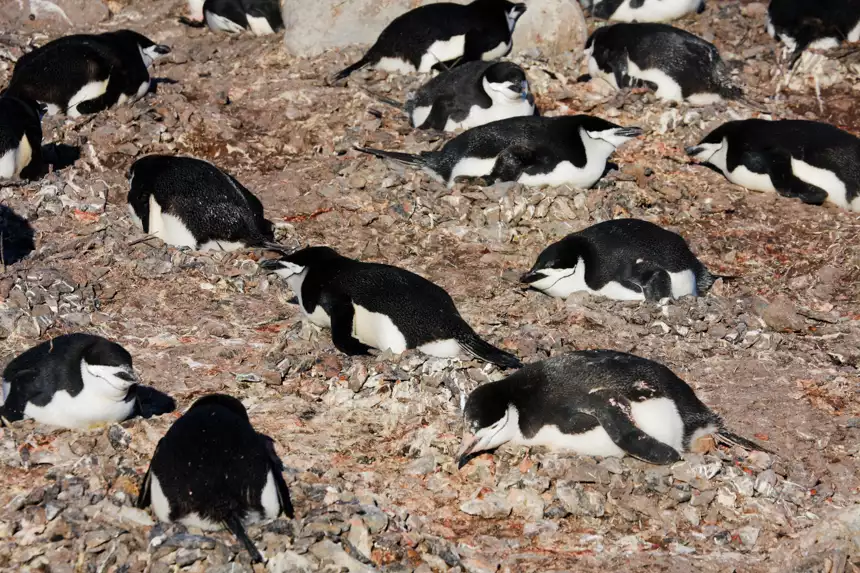
Antarctica Weather in December
- Average temperature in Antarctica in December: 29-34 degrees & 16.5 hours of daylight
- South Shetland Islands temperature in December: 23-27 degrees & 20 hours of daylight
- South Georgia Island temperature in December: 32-46 degrees & 17 hours of daylight
Benefits of Visiting Antarctica in December
- Good chance for calmer seas crossing the Drake Passage
- Warmest months and nicest weather of the Antarctica seasons begins
- Glaciers are actively calving as temperatures rise
- Research and station visits peak in Antarctica beginning in December
- Long days with midnight sun create more opportunities for exploration & wildlife viewing
- Whales are beginning to arrive in Antarctica
- Spring wildflowers bloom on South Georgia Island
- Historic whaling village of Grytviken & Shackleton grave accessible on South Georgia Island
Antarctica Wildlife in December
- Whales starting to arrive to Antarctica in December
- Leopard, Crabeater, Weddell & Elephant seal pups are commonly seen on ice floes
- Penguins, petrels and cormorants are laying eggs and sitting on their nests
- Penguin chicks begin to hatch in late December in Antarctica
- Penguin chicks begin to hatch in early December in the Falkland Islands.
- Fuzzy brown King penguin chicks are hatching on South Georgia Island
- Wandering albatross return to lay eggs on South Georgia Island
Antarctica in January
Being the height of the travel season with cruises in full swing, travelers often ask “What is the weather like in Antarctica in January.” The weather in Antarctica in January is excellent, with average temperatures reaching their highest of the year. Undoubtedly January is the warmest month in Antarctica. January is the best time to go to Antarctica because of calm weather, calm seas and abundant wildlife.
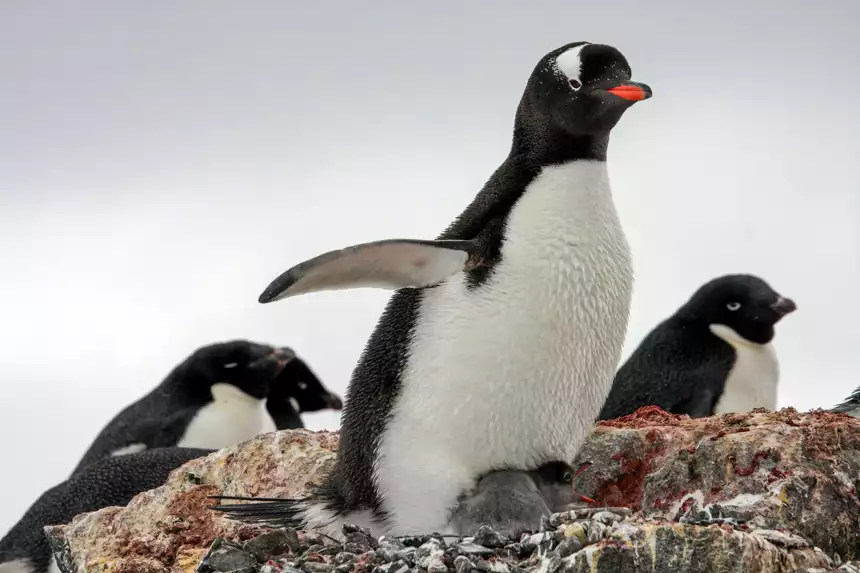
Weather in Antarctica in January
- Average temperature in Antarctica in January: 33-36 degrees & 16 hours of daylight
- South Shetland Islands temperature in January: 25-29 degrees & 19 hours of daylight
- South Georgia Island temperature in January: 32-46 degrees & 16.5 hours of daylight
Benefits of Visiting Antarctica in January
- January is the warmest month in Antarctica with average high of 36 degrees
- Zodiac cruises are intriguing with melting icebergs, shaped by the sun
- Sea ice opens allowing for visits to more landing sites and wildlife
- Certain itineraries start attempting to reach the Antarctic circle
- Historical huts of Shackleton and Scott in the Ross Sea are accessible
Antarctica Wildlife in January
- Hatching or newly hatched penguins are abundant
- Penguin feeding frenzies begin as parents bring their young food from the sea
- Baby Antarctic terns are hatching
- Baby seals are lounging about with their parents
- Whale sightings are increasing
- Population of King penguins on South Georgia Island is highest
Antarctica in February
February is the best time to see whales in Antarctica. If you like whale watching, this is your month. It’s the best time to visit Antarctica for predictable whale watching, penguin chick activity ashore, and the shorter days lend themselves to excellent sunrises and sunsets punctuated by those whale tails. The weather in Antarctica in February is begging to cool and days are getting shorter. Fall is fast approaching.

Weather in Antarctica in February
- Average temperature in Antarctica in February: 28-34 degrees & 14.5 hours of daylight
- South Shetland Islands temperature in February: 25-33 degrees & 16 hours of daylight
- South Georgia Island temperature in February: 35-48 degrees & 15 hours of daylight
Benefits of Visiting Antarctica in February
- Best time to view whales. Long days generate plankton blooms, a buffet for feeding whales
- This is the best time to visit Antarctica for orca, minke and humpback whale watching
- Receding ice opens up and allows for even more exploration
- Epic sunrises and sunsets as days get shorter
Antarctica Wildlife in February
- Molting penguin chicks are running about
- Adult penguins are busy swimming after krill to feed their chicks
- Playful fur seal and leopard seal pups are commonly seen
- Whales become predictable visiting feeding areas sometimes traveling in large pods
- Orca whales arrive to feed seal pups and penguin chicks learning to swim
- Abundant fur seal populations
- Elephant seals come ashore to molt
- King Penguin chicks on South Georgia Island are beginning to mold
Antarctica in March
March is the best month to go to Antarctica if you are seeking color! Algal blooms, night sky viewing, sunsets and possible sightings of aurora australis all make Antarctica in March a fascinating month. March is the best time of year for polar circle cruises to accomplish this bucket list goal. March is also a good time to find Antarctica cruise deals since the season is winding down and the weather is turning cooler. March in Antarctica is characterized by shorter days, colder weather and waterways virtually free of sea ice.
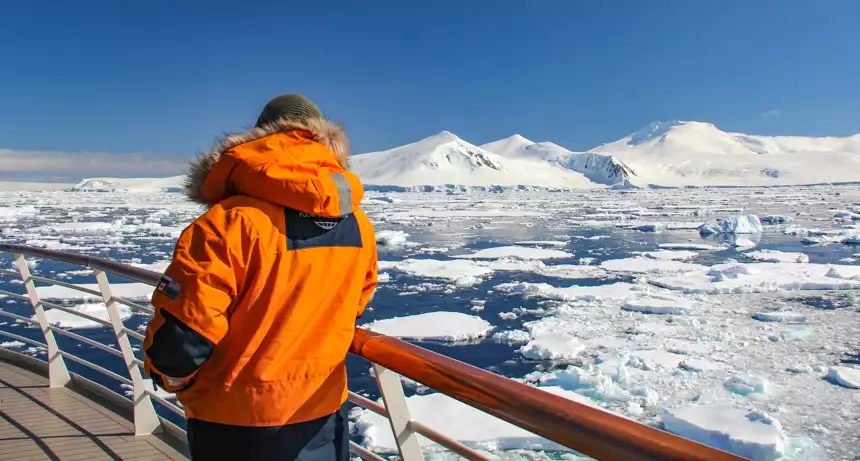
Antarctica Weather in March
- Average temperature in Antarctica in March: 26-32 degrees & 12.5 hours of daylight
- South Shetland Islands temperature in March: 22-30 degrees & 13 hours of daylight
- South Georgia Island temperature in March: 33-46 degrees & 13 hours of daylight
Benefits of Visiting Antarctica in March
- Great time to see whales in Antarctica
- Less sea ice means more opportunities to reach the polar circle
- Snow-free beaches allow for more landing sites and easy sightings of large penguin rookeries
- Best time to travel to Antarctica for night sky viewing, weather permitting
- Green and pink algae blooms show their colors on snow and ice cliffs
- Possible sightings of aurora australis, also known as southern lights, during dark nights
- Lower prices and more availability making this the best time to visit Antarctica for a deal
Antarctica Wildlife in March
- Adolescent penguins explore colonies, finish molting & grow adult feathers to begin swimming
- Some Adelie, chinstrap and gentoo rookeries are empty, as adults return to the sea to feed
- South Georgia Island’s king and macaroni penguin rookeries are highly populated
- Some birds, like Antarctic terns, start flying north
- Whale activity is high as they feed furiously before migrating north
Best Month to Cross the Drake Passage
Ocean conditions can undoubtedly affect your Antarctic plans. The infamous Drake Passage is the body of water between South America’s Cape Horn and the Antarctic Peninsula. Currents at this latitude meet no resistance from any landmass. Combined with high winds this can make for a rough crossing certain times of year.
We are often asked “What is the best month to cross the Drake Passage?” January is the best time to cross Drake Passage with the best chance for calm seas. During the height of summer winds may abate and seas may calm. See our post about how to prevent and treat seasickness on cruises . And consider yourself lucky if you experience calm seas any time you cross the Drake Passage.
Best Time to Cruise Antarctica
Most travelers will visit Antarctica by small ship . We could have called this guide the best time to cruise Antarctica, as all of the advice above applies to cruises. The best time to cruise Antarctica is December through February, which comprises the peak cruising season. We are often asked “When is the best month to cruise Antarctica?” If we had to pick one, the best month to visit Antarctica is January.
View All Antarctica Cruises
See the full list of White Continent itineraries.
Best Time to See Penguins in Antarctica
Penguins can be found throughout the Antarctica travel season. The best time to see penguins in Antarctica is December through March. The best time to see penguin chicks in Antarctica is late January through the end of February. Viewing penguins is a highlight for most travelers visiting Antarctica.
Travelers can see up to eight species of penguin in Antarctica. Virtually all trips to the Antarctic Peninsula will see gentoo, adelie and chinstrap penguins. If you really want to see more species of penguins in Antarctica there are a few specialty cruises to consider.
Trips that visits South Georgia Island and the Falkland Islands will view vast colonies of king penguins and may also encounter rockhopper, megallanic, and macaroni penguins.
Emperor penguins are rare. But there are specialty emperor penguin cruises focused on finding and viewing the largest penguins species.
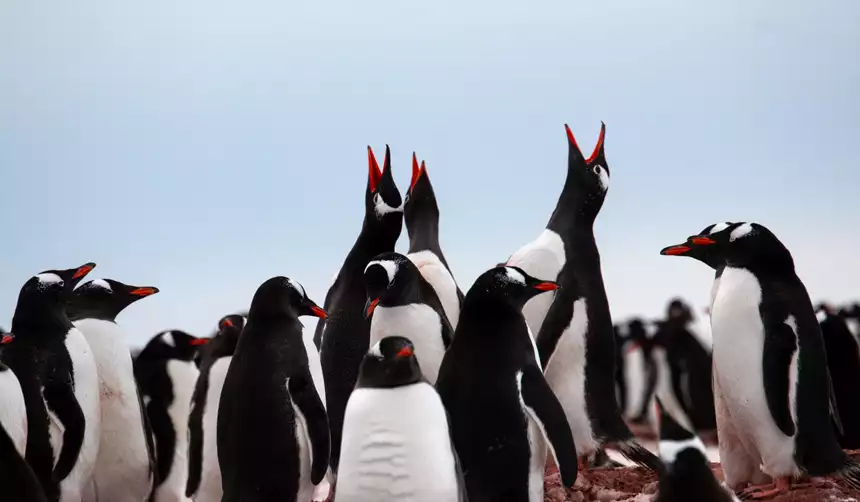
Best Time to See Whales in Antarctica
Whale watching is an exciting highlight of any visit to Antarctica. The best time to go whale watching and to see whales in Antarctica is February and March.
There are up to 8 whale species travelers might encounter in Antarctica. Humpback whales are the most commonly sighted whales, followed by smaller minke whales.
Migratory whales such as humpback whales, fin whales, blue whales and minke whales are begin arriving in Antarctica in November and December. Whales come to feed on abundant krill and small fish that explode as a result of long days and productive waters. Numbers increase and feeding pods form through January. By February and March feeding pods have formed making this the best time to see whales in Antarctica.
Orca whales don’t migrate and can be found in Antarctica year round. The best time to see Orca whales in Antarctica is in February and march when penguin chicks and seal pups are entering the water making an easy meal.
Whale watching is an incredible part of the Antarctic experience. Consider yourself lucky if you see whales on your trip.
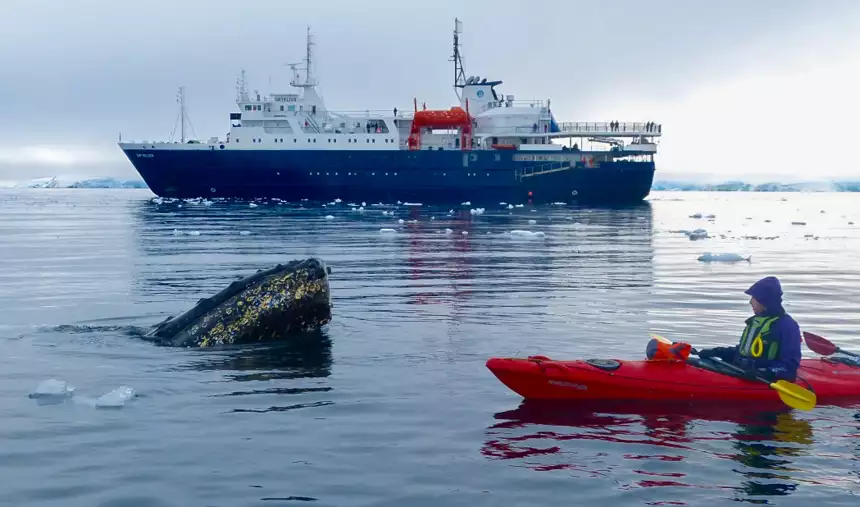
Latitude Matters When Choosing When to Visit Antarctica
Life at the south pole is affected greatly by latitude variances. Slight latitude shifts confer big changes in temperature, sunlight and seasonality. Combine this with the short Antarctic summer and you’ll see animals’ mating, laying and rearing cycles moving very fast!
The Antarctic Peninsula warms first at the northerly tip, and later in the south. This will affect penguins, wildlife and ice conditions. For instance, on our founder’s air cruise to Antarctica in December, he saw penguins mating and nest building; sitting on eggs; and newly hatched chicks all in different areas based on latitude north or south.
There are particularly significant differences for Falkland Islands and South Georgia cruise routes, as well as for routes that stretch into the eastern reaches of the Weddell Sea. Read more about the best time to visit for viewing South Georgia Island animals .
While this Antarctica by month guide is valuable resource for planning your own best time to visit Antarctica, note that wildlife and weather can never be fully predicted, especially in a land as dramatic as Antarctica.
Detailed Climate Tables
View our Antarctica climate page to see Antarctica average temperature by month and daylight hours in detailed locations like the Antarctic Peninsula, South Shetland Islands, South Georgia Island and Ushuaia. As most cruises focus on the Peninsula, here is our detailed table for that region:
Antarctic Peninsula Weather by Month
Antarctic Peninsula Average Temperature, Rainfall & Daylight
So, What Is the Best Month to Go to Antarctica?
Considering everything stated above, the best month to go to Antarctica is January. There is a reason January is the peak Antarctica season. The wildlife is active, the ice is spectacular, and the weather is hard to beat.
But not everyone can or should schedule their trip during this time since each month has its benefits. You really can’t go wrong choosing any time in Antarctica’s six-month cruising season. If you plan your trip during the peak season of mid-December through mid-February, then be sure to book early as these are the dates that sell out first.
Need more information on when to travel to Antarctica? Our timeline above aims to be a detailed guide for you to determine your own individual best month to go to Antarctica. Our experts are here to assist with even more detail. Contact us to learn more about planning an Antarctica cruise and the best time to visit Antarctica for your travel needs. We are here to help with one-on-on advice and ensure you have a great trip any time of year.

MAKE IT HAPPEN
Full-service booking from experts who’ve been there.
Keep researching your visit to Antarctica with our resources below. Or, simply have the latest about Antarctica delivered to your inbox by signing up for the AdventureSmith Explorations newsletter .
MORE ANTARCTICA RESOURCES : Antarctica Travel Guide Antarctica Cruises Luxury Antarctica Cruises Falkland Islands & South Georgia Cruises Cruises with Flights to Antarctica Antarctica Cruise Cost How to Get to Antarctica Things to Do in Antarctica Places in Antarctica Antarctica Ships Best Antarctica Cruise Lines Antarctica Cruise Deals Antarctica Cruise Reviews
Have a question or looking for advice about the best time to visit Antarctica? Use the comments below and we’ll answer your question and make this guide even better.
Comments will be moderated and will appear after they have been approved.
Cancel reply
Your email address will not be published. All fields are required.
Hi, if I would like to kayak, what is the best month to visit Antarctica, and what are the ships or itineraries I should consider?
Hi Wai Yee, Kayaking is available on most of our expeditions, at ANY time of the cruising season, but space can fill up fast for coveted spots. If you have your heart set on kayaking, it’s a good idea to book as soon as you can. Options range from short one-time paddles to full programs that let you kayak every day. We will have an Adventure Specialist be in touch to further hone in the best time to kayak in Antarctica & the best trips for doing so based on what’s available now or next season. Generalizations for timing kayaking would be to expect more ice and pristine landscapes if you kayak in early season (Nov-Dec) and to potentially get closer encounters with whales during kayak excursions later in the season (Feb-March).
Hey! How is end of March for a visit? 🙂
Hey Ashwini! March in Antarctica has its benefits. Whales are plentiful (humpbacks in peak numbers), sunsets/rises are long and vivid, and less snow allows for more landing sites and access to areas further south. By late March the cruise season is wrapping up as the temperatures drop. You can often find more Antarctica cruise deals and enjoy the feeling of having Antarctica to yourself. Here’s a list of Antarctica trips in March ; for detailed availability please contact an Adventure Specialist .
Best months to visit? We want to see the baby animals, plus we are going to tie it in with a trip to Machu Picchu.
Sue, Wow that sounds like quite a trip! These are two of our most popular destinations. Baby penguins are usually most prevalent in January while seal pups are most commonly seen in February, but it always depends where you go as timing can change by latitude. Talking to an Adventure Specialist can help you find the best timing and trip for you and will be reaching out to you shortly.
Find Your Best Time to Visit Antarctica
Start browsing our selection of trips to discover more about activities and itineraries. Let us be your guide to the best time to go to Antarctica and help choose your perfect expedition. Our team has traveled in every month of the season so have firsthand insight on each month. Get started finding your bucket list trip!
Contact Us - Best Time to Visit Antarctica
Travel is best planned one-on-one, and we’re here to help you with your specific needs.
- First Name *
- Last Name *
- Phone (required because some email replies get blocked) *
- Country of residence (required in order to comply with privacy laws) * United States of America - US Afghanistan - AF Aland Islands - AX Albania - AL Algeria - DZ American Samoa - AS Andorra - AD Angola - AO Anguilla - AI Antarctica - AQ Antigua and Barbuda - AG Argentina - AR Armenia - AM Aruba - AW Australia - AU Austria - AT Azerbaijan - AZ Bahamas - BS Bahrain - BH Bangladesh - BD Barbados - BB Belarus - BY Belgium - BE Belize - BZ Benin - BJ Bermuda - BM Bhutan - BT Bolivia - BO Bosnia and Herzegovina - BA Botswana - BW Bouvet Island - BV Brazil - BR British Virgin Islands - VG British Indian Ocean Territory - IO Brunei Darussalam - BN Bulgaria - BG Burkina Faso - BF Burundi - BI Cambodia - KH Cameroon - CM Canada - CA Cape Verde - CV Cayman Islands - KY Central African Republic - CF Chad - TD Chile - CL China - CN Hong Kong, SAR China - HK Macao, SAR China - MO Christmas Island - CX Cocos (Keeling) Islands - CC Colombia - CO Comoros - KM Congo (Brazzaville) - CG Congo, (Kinshasa) - CD Cook Islands - CK Costa Rica - CR Côte d'Ivoire - CI Croatia - HR Cuba - CU Cyprus - CY Czech Republic - CZ Denmark - DK Djibouti - DJ Dominica - DM Dominican Republic - DO Ecuador - EC Egypt - EG El Salvador - SV Equatorial Guinea - GQ Eritrea - ER Estonia - EE Ethiopia - ET Falkland Islands (Malvinas) - FK Faroe Islands - FO Fiji - FJ Finland - FI France - FR French Guiana - GF French Polynesia - PF French Southern Territories - TF Gabon - GA Gambia - GM Georgia - GE Germany - DE Ghana - GH Gibraltar - GI Greece - GR Greenland - GL Grenada - GD Guadeloupe - GP Guam - GU Guatemala - GT Guernsey - GG Guinea - GN Guinea-Bissau - GW Guyana - GY Haiti - HT Heard and Mcdonald Islands - HM Holy See (Vatican City State) - VA Honduras - HN Hungary - HU Iceland - IS India - IN Indonesia - ID Iran, Islamic Republic of - IR Iraq - IQ Ireland - IE Isle of Man - IM Israel - IL Italy - IT Jamaica - JM Japan - JP Jersey - JE Jordan - JO Kazakhstan - KZ Kenya - KE Kiribati - KI Korea (North) - KP Korea (South) - KR Kuwait - KW Kyrgyzstan - KG Lao PDR - LA Latvia - LV Lebanon - LB Lesotho - LS Liberia - LR Libya - LY Liechtenstein - LI Lithuania - LT Luxembourg - LU Macedonia, Republic of - MK Madagascar - MG Malawi - MW Malaysia - MY Maldives - MV Mali - ML Malta - MT Marshall Islands - MH Martinique - MQ Mauritania - MR Mauritius - MU Mayotte - YT Mexico - MX Micronesia, Federated States of - FM Moldova - MD Monaco - MC Mongolia - MN Montenegro - ME Montserrat - MS Morocco - MA Mozambique - MZ Myanmar - MM Namibia - NA Nauru - NR Nepal - NP Netherlands - NL Netherlands Antilles - AN New Caledonia - NC New Zealand - NZ Nicaragua - NI Niger - NE Nigeria - NG Niue - NU Norfolk Island - NF Northern Mariana Islands - MP Norway - NO Oman - OM Pakistan - PK Palau - PW Palestinian Territory - PS Panama - PA Papua New Guinea - PG Paraguay - PY Peru - PE Philippines - PH Pitcairn - PN Poland - PL Portugal - PT Puerto Rico - PR Qatar - QA Réunion - RE Romania - RO Russian Federation - RU Rwanda - RW Saint-Barthélemy - BL Saint Helena - SH Saint Kitts and Nevis - KN Saint Lucia - LC Saint-Martin (French part) - MF Saint Pierre and Miquelon - PM Saint Vincent and Grenadines - VC Samoa - WS San Marino - SM Sao Tome and Principe - ST Saudi Arabia - SA Senegal - SN Serbia - RS Seychelles - SC Sierra Leone - SL Singapore - SG Slovakia - SK Slovenia - SI Solomon Islands - SB Somalia - SO South Africa - ZA South Georgia and the South Sandwich Islands - GS South Sudan - SS Spain - ES Sri Lanka - LK Sudan - SD Suriname - SR Svalbard and Jan Mayen Islands - SJ Swaziland - SZ Sweden - SE Switzerland - CH Syrian Arab Republic (Syria) - SY Taiwan, Republic of China - TW Tajikistan - TJ Tanzania, United Republic of - TZ Thailand - TH Timor-Leste - TL Togo - TG Tokelau - TK Tonga - TO Trinidad and Tobago - TT Tunisia - TN Turkey - TR Turkmenistan - TM Turks and Caicos Islands - TC Tuvalu - TV Uganda - UG Ukraine - UA United Arab Emirates - AE United Kingdom - GB United States of America - US US Minor Outlying Islands - UM Uruguay - UY Uzbekistan - UZ Vanuatu - VU Venezuela (Bolivarian Republic) - VE Viet Nam - VN Virgin Islands, US - VI Wallis and Futuna Islands - WF Western Sahara - EH Yemen - YE Zambia - ZM Zimbabwe - ZW
- Newsletter Subscribe to our email newsletter
- By submitting this form, you consent to our privacy policy .
- Hidden IP Location
Talk to an AdventureSmith Travel Specialist Call us toll free at 1-877-620-2875 . Call us direct at 530-583-1775 .
Office Hours Monday through Friday, 8am-5pm Pacific Time.
Address 40169 Truckee Airport Road, Suite 201 Truckee, CA 96161

Antarctica By Month: Best Time To Go To Antarctica
Antarctica is one of the most intrepid destinations that you can visit in the world, and the great southern continent sees few visitors each year.
This is a remote and isolated place, and travel to the region is very much dependent on the weather. And the weather is extreme, ensuring that you need to choose wisely, the best time to visit Antarctica.
For much of the year, the continent is entirely closed off to tourists, and only a few hardy scientists are found braving the cold depths of winter at inhospitable research stations.
Ships and tourist expeditions don’t run during the southern winter, and it’s impossible to travel to Antarctica as a tourist between April and October.
The brief summer season runs from November through to March, and this is the best time to visit Antarctica and the only time to visit!
But within this travel window, your experience can vary from month to month. At the start and end of the season, you’ll need to endure rough seas, but you’ll have the chance to see enormous icebergs.
If you want to see the wildlife at its most active then you’ll need to visit between December and February, when the weather is at its best.
There’s a lot to consider when you’re planning your journey to the continent, but to help you out, here’s our guide to choosing the best time to visit Antarctica.
Best Time to Visit Antarctica: Month by Month Breakdown
Table of Contents

Late October/November in Antarctica
November is the beginning of the expedition season in Antarctica, although some ships may begin to depart from Cape Horn to the southern seas in late October.
For most travelers though, November is still a month that many choose to avoid because the continent is still transitioning into spring and then summer. What that means in practical terms, is that the weather is incredibly unpredictable still.
While temperatures are beginning to edge above freezing for the first time in months, the seas can still be rough and storms can strike out of nowhere. If you’re prone to seasickness, this is not a good time to be crossing the Drake Passage from South America.
But while the weather isn’t at its summery best yet, there are many positives to visiting in November. For starters, cruises can be cheaper, but more than this, the landscapes are at their most otherworldly.
With so much snow and ice, it’s possible to join snowshoe tours or even to ski when you visit Antarctica in November, while you’ll also encounter the largest icebergs and the vast ice sheets that have yet to melt.
Life is also beginning to return to the continent in November, and not just in the form of tourists. Albatross and other birds will be seen in the skies, while in the water, Humpback Whales and Minke Whales often begin to return to the southern oceans as things begin to warm up.
You’ll also see penguins and seals, while a fantastic bonus of traveling in November is the fact that the sun still sets, meaning you can enjoy fiery Antarctic sunsets in the sky.
Check Quark Expeditions for great deals on expeditions to Antarctica from Oct to Nov.

December in Antarctica
December is when the tourist season begins, and this can be the best time to visit Antarctica if you want to experience more of the local wildlife, yet still catch the last remnants of the cold, dark winter that preceded spring earlier in the year.
This isn’t quite at peak season yet, but it’s getting there, and you’ll find ships can be quieter and not as crowded, while costs might be slightly lower at the start of the month, than January and February when it’s officially the high season in Antarctica.
The weather is much more pleasant in December than in November, but temperatures are still low, this is Antarctica, remember.
Travel further south, to the Antarctic Peninsula and you can enjoy 24 hours of daylight and experience the midnight sun, while you’ll still have the opportunity to see big icebergs and huge ice sheets in the south.
Wildlife is much more active, especially further north in the South Shetland Islands where things are getting positively warm. You can see the start of the penguin nesting and hatching season, and across the continent, penguin activity is constantly on the up in December.
Whales are more common than in November, as the water begins to get warmer. As you head down south, you might be lucky to spot migratory species as they too make the same journey as you.
And of course, book a tour towards the end of the month and you can even spend Christmas in Antarctica, perhaps the only place in the Southern Hemisphere where you can guarantee that you’ll have a white Christmas!
This is when we explored Antarctica with Quark Expeditions on their MV Sea Adventurer ship that departed from Ushuaia, Argentina and we explored the South Shetland Islands and Antarctica Peninsula.

January in Antarctica
January is when the tourist season begins across the great southern continent, and this is the best time to visit Antarctica if you want to enjoy the best weather and the best of the wildlife.
January and late December are incredibly popular, so you will need to book your expedition far in advance, especially if there are particular places you want to visit, as itineraries can vary from ship to ship.
This is summer, and you can expect temperatures to reach highs of 15 degrees Celsius, which for Antarctica, is positively scorching hot.
This is a great time for whale watching, as many more species will have made their way here and you might be lucky enough to spot Blue Whales and Orcas from your boat.
On the islands and the peninsula, penguin chicks are starting to hatch in enormous numbers and it’s the best time to visit Antarctica to see the mass colonies that can number in the tens of thousands in some places, such as on the aptly named Penguin Island.
You’ll have 24 hours of daylight in some places too, and with icebergs and pack ice melting, you can also enjoy plenty of shore excursions that might have been impassable earlier in the season. It’s a good time for kayaking and even, if you’re brave enough, Antarctic camping!
Check Quark Expeditions for great deals on expeditions to Antarctica in January.

February in Antarctica
February is the end of summer, but this is Antarctica and the weather can change drastically, and quickly. For most of the month, you’ll be enjoying temperatures well above freezing though, but the seas can start to get a little tougher though.
Most of the pack ice and many of the icebergs have melted by February, which means that if you are looking to explore further south, along the Antarctic Peninsula and towards the South Pole, then this is the time to go. For shore excursions, this is also the best time, as bays and harbors are ice-free.
On the islands and the peninsula, you’ll find that the penguins have hatched and the young penguins are learning how to stand on their own feet and survive in the harsh world of the Antarctic. It’s the perfect time to see the penguins in action, as well as their predators such as seals.
Importantly though, February is the best time to visit the Antarctic if you are there for whale watching. This is when the seas are quite literally crowded with whales because by now they’ve all made their migrations to the south.
In the waters of the Antarctic in February you can find an incredible array of different whale species. You’ll see enormous Blue Whales, packs of Orcas hunting, Minke Whales cruising through the waters and many more species too.
Towards the end of February, the weather begins to get much colder, but for most of the month, it’s a great time to be in Antarctica.
Check Quark Expeditions for great deals on expeditions to Antarctica in February.

March in Antarctica
When March comes around, it’s the end of the tourist season in Antarctica, but that doesn’t mean that it’s not a good time to travel here. The weather is a lot colder than in the previous summer months, and the days are starting to get shorter too.
In November, at the start of the season the seas, particularly the Drake Passage, will be much rougher and you may want to avoid March if you’re likely to be seasick. Quark Expeditions offers a flight to the Antarctic Peninsula flying over the Drake Passage allowing you to experience Antarctica the fastest and most direct way.
In March though, ships are again less crowded and you’re likely to get a better deal than in peak season, so it’s a more cost-effective time of the year to travel, as long as you don’t mind braving the low temperatures.
You can still see the whales in Antarctica too, and while many might be beginning their long voyage north for the winter months, on your crossing from South America you’ll certainly pass them.
The wildlife on land though is beginning to settle down for the harsh winter months that lie ahead, while many birds may have already migrated to warmer climes.
You might not want to venture too far south either, as the days are much shorter and the weather even colder. The South Sandwich Islands though is very much still a great place to explore in March, and you can continue to enjoy iconic destinations such as Deception Island, King George Island, and many other places too before the season comes to a close at the end of the month.
Our trip to Antarctica was in partnership with Quark Expeditions , however all opinions are 100% mine, as always.

More on Antarctica:
- 34 Antarctica Cruise Tips You Must Know Before You Go
- Can You Go to Antarctica? Why on Earth Would You Want To!
- How to Visit Antarctica Responsibly: Antarctica Tourism Deep Dive
- 26 UNREAL Things to Do in Antarctica
- Crossing the Drake Passage: What It’s Really Like
- Deception Island: A different side of Antarctica
- Animals in Antarctica You Can See During a Visit
- 121 Epic Antarctica Facts
- Climate Change Awareness from Travel: How to Talk About It
- Ultimate Cruise Packing List (Cruise Essentials for Any Destination!)
Did you like this story? Share it!
Travel planning resources, about lina stock.
Lina is an award-winning photographer and writer that has been exploring the world since 2001. She has traveled to 100 countries on all 7 continents. Member: SATW, NATJA, ATTA, ITWA
Leave a Comment Cancel reply

These are the best times to visit Antarctica

Dreaming of a cruise around the Antarctic Peninsula to spot leopard seals or to watch young penguins chase each other playfully around a rookery? Hoping to plunge into below-freezing Antarctic waters or see glaciers calve from the vantage point of a kayak? You'll need to find the best time to visit Antarctica to get the once-in-a-lifetime experience you crave.
Depending on what you want to do or see during your trip to Antarctica, you might favor an expedition earlier in the season or near the end. Certain months are better for camping and hiking on the continent, or for photographing whales and penguins. Some months confer longer days and warmer weather, while others may improve your chances of seeing the aurora australis, more commonly known as the southern lights.
For more TPG news delivered each morning to your inbox, sign up for our daily newsletter .
No matter your preference, you will certainly visit the White Continent during the austral summer. When the northern hemisphere is descending deeper into darkness, Antarctica is experiencing nearly 24 hours of sunlight — which means expeditions typically take place between late November and early to mid-March.
Here are the best times to visit Antarctica for the activities likely to be on your bucket list.
The best times to see wildlife
The best time to visit Antarctica to see wildlife depends on the animals you most want to see, and whether you have your heart set on photographing adorable baby penguins or whales breaching.
Travelers who visit Antarctica early in the season, typically in November, will likely see penguins nesting and protecting eggs. Fresh snowfall at this time can make for incredible photos — and wintry landscapes.
By December, visitors are more likely to see penguin hatchlings. I traveled to Antarctica in mid-December and missed the hatchlings by a week. My colleague, Gene Sloan, visited just 10 days later and saw many baby chicks during several landings.
The sweet spot for seeing chicks that are still small and fuzzy is late December through early January. As the season progresses, you'll find baby penguins turning into adolescents. When Sloan went back to Antarctica in early February, he found the same chicks he had seen as tiny balls of fluff had grown nearly as big as their parents.
Related: Is this the ultimate Antarctica cruise ship?
If whale watching is at the top of your list, visit Antarctica later in the season, in February or March, as that's the best time for cetacean spotting. This is when whales are more easily seen gathering together in large groups before migrating north. But even during my trip in December, we saw many humpback whales — and orcas were spotted in spades the following week.
Humpback whales, orcas and minke whales are all frequently spotted in Antarctic waters, though you might have luck catching a glimpse of more rare whale species too, such as sperm, fin and blue whales.
The best weather in Antarctica
Antarctica is the most extreme continent on the planet: It can be incredibly cold, dry and windy. In the leather folio I received for my December sailing with Atlas Ocean Voyages , I was told that temperatures during the Antarctic summer "usually reach between 30 and 40 degrees Fahrenheit," though this can vary depending on the specific month of your trip.
If you have an opportunity to land and walk on fast ice, as Gene did with Silversea Cruises during a late December trip, you'll want to aim for a trip early on in the season, as the fast ice melts away throughout the summer. It's possible to do this later in the season, but you'll need to venture much farther south, where it's colder.
January is the warmest month of the year in Antarctica, and good weather means better odds of kayaking and paddling around the Antarctic Peninsula and surrounding islands.
Likewise, snow can make landings more challenging and can make it harder or impossible to hike and camp on land. So, in addition to being colder and wetter, easy-season travel can have other complications.
The late summer months (February and March) can also make it possible to venture farther south, to parts of the region that are typically inaccessible, since more ice has melted.
The best times to visit Antarctica for photography
Antarctica is stunning no matter what time of year you decide to visit. But depending on the type of landscapes and wildlife you want to photograph, you might want to hone in on an early, mid- or late-summer trip.
Visit in late December during the summer solstice to capture the phenomenon of the midnight sun — and take full advantage of long days when you can squeeze in as much photography time as possible.
Related: The ultimate packing list for an Antarctica trip
If what you're after is an actual sunset or sunrise photo behind a backdrop of ice and mountains, you'll have more luck on the early and late ends of the season, when there's a more marked difference between day and night.
Or, aim to see the southern lights by visiting as late in the season as possible (March) when the days start getting shorter and you might get lucky on a particularly clear night.
Wildlife photographers should target the middle of the season, when there's a flurry of activity from penguins, whales, seals and other incredible animals.
Bottom line
The window for travel to Antarctica is relatively short, due to the continent's extreme and inhospitable weather. Even travelers on land-based excursions to Antarctica, such as the luxury eco camps by White Desert , will find the calendar of available dates is limited to travel between late November and early February.
To visit Antarctica at the time you think is best, book at least a year in advance.
Whether you're going to book an express flight to the continent or opt instead for a traditional sailing across the Drake Passage (one of the most violent bodies of water in the world no matter what time of year you plan to visit), you will love Antarctica in any season. Since this is often a once-in-a-lifetime destination, think carefully about the sights you want to see or the experiences you would love to have, then choose a trip in the right month to make your bucket-list dreams come true.
Planning a trip to Antarctica? Start with these stories:
- Dreaming of Antarctica: How to book the trip of a lifetime
- 7 tips for visiting Antarctica before it's too late
- 6 ways to travel to Antarctica in style and luxury
- 11 great expedition cruise vessels that will take you to Antarctica
- These 8 books are must reads before any Antarctica trip
- I just spent to night in an igloo in Antarctica — here's how you can, too
- Deutschland
Best Time To Visit Antarctica
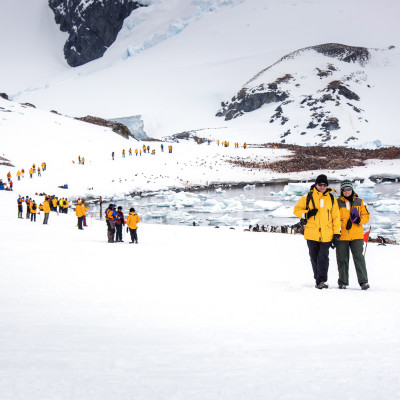
Sunshine and snow in the South Pole
The month in which you travel to Antarctica makes a lot of difference.
November – March is the short expedition season This is not only the best time to visit Antarctica, it is the only time it’s possible – as the ice breaks up allowing ships to pass. The continent is colder but at its most untouched, with pristine ice and snow, and wildflowers blooming on the islands. December and January enjoy days filled with 20 hours of sunshine, which bring welcome warmth; temperatures hover above freezing, creating perfect conditions for seal pups and penguin chicks – as well as whales.
Best Time To Visit
We recommend.
- If you are over 16 and possessed of an adventurous spirit, why not spend a night as part of the ultimate camping experience – sleeping on the ice in Antarctica!
- Venture onto the calm ocean waters as you gracefully glide over the glasslike surface on your kayak, under the eye of your watchful guide. Don’t forget to peer at the spectacular world unfolding below you! Do note that this activity is open to those 16 years and above
- If you are a bird lover, keep your eyes peeled and camera ready as you spot all types of albatrosses, cormorants, petrels, gulls and skimmers
- Gain intimate access right into the rarely seen world of the biggest mammals on earth – the blue whale and the humpback whale as they return to feed in the nutrient-rich waters of the Antarctic Ocean
- If you are visiting this month, it’s still a great time for a spot of whale watching!
- Don’t forget to savor and photograph the stunning sunsets around this time
- Feast your eyes on the spectacular sunsets before midsummer – the skies shift from blacks to grays before a blood-red horizon spills out over the ice and water as far as the eye can see. Red turns over into orange and yellows before clear light blankets everything. This fantastic evening light makes this one of the best times for photographers to capture the islands’ stunning natural beauty
- Marvel at the spectacular icebergs, with ice falling into the water or with cavorting penguins atop of them as you cruise down the magnificent ice-filled fjords
- Bring your binoculars and prepare to enter the world of the penguin! And there are so many to photograph – from the tiny Adelie, and the easily recognizable Chinstrap, to the Macaroni and the remarkable Southern Rockhopper
- This is also the month the chicks start hatching in the penguin rookeries so be prepared for a lot of activity in those areas!
- Visit a research base to get a first-hand glimpse of what it is like to live on Antarctica. There are several abandoned and fully occupied bases scattered the continent and a general population, depending on the season, of anywhere between 1000-4000 people
Climate in Antarctica
With average temperatures of -94°F and -40°F during August – the peak of winter – the climate of Antarctica is the harshest of all continents. It does get warmer during the summer months with average temperatures of 5°F and – 49°F in February, which is considered the warmest month of the region. However, temperatures are somewhat higher in the coastal areas due: between -25°F to 5°F in winter, and 23°F to 41°F in the summer months. With such extreme climatic conditions, it is no wonder that Antarctica is the driest region on our planet, almost entirely a desert. The land experiences six months of daylight in the summer months of October to March, and the rest of the year is spent in darkness. It’s also where the lowest ever temperature on earth was recorded in 2018, -144.04°F, beating the previous record of -128.56°F from 1983!

What to Pack for Antarctica
Covered by ice approximately a mile thick, it’s safe to say Antarctica is the coldest place on earth. Temperatures often drop to as low as -70°C. With no precipitation, Antarctica is a dry place too and is technically classified as a desert. So as you can imagine; what one wears is of the utmost importance, be it day or night.
Suggested Clothing
The average temperature in the Antarctic Peninsula area during the austral summer is about 32°F, although sometimes it may feel a little lower because of the wind chill factor. For this reason, it is best to wear several layers of light, warm clothing. The suggested clothing for Antarctica is very similar to that recommended for skiing: thermal underwear, a couple of warm and wicking mid-layers, and windproof and waterproof jacket and pants as the outer layer – essentially a layered system with an outer layer that is waterproof. The air between the layers provides additional insulation. Fleeces are very suitable and waterproof pants for the landing are essential. You will also need a hat, a scarf, waterproof and insulated gloves, and sunglasses with high UV protection. We offer a complimentary packer to our guests.
Waterproof Boots
You will need to stay as warm and dry as possible all the time. Therefore, correct footwear is very important. As most landings in Antarctica are “wet landings”, the best footwear is knee-high waterproof boots. You will not need to carry them with you since your air cruiser will provide you with a pair of thermal rubber boots before arriving in Antarctica. Sturdy walking shoes or sneakers with a good grip sole for the slippery deck, and rubber boots will be provided. Please note that we provide rubber boots for shore excursion activities during the course of the tour.
Face Protection
You will also need good sunblock lotion for your face. Good quality UV filtering sunglasses are essential. Glacier glasses have leather flaps at the sides to stop the light from passing through. Due to the high reflectance of UV radiation, you will also need good sunblock lotion for your face (this means a high protection factor of perhaps 30 and above) and lip balm.
Photography
To see the wildlife you should have a good pair of lightweight binoculars (the suggested magnification is 7× or 8×). If you are passionate about photography, do not forget a good zoom lens to shoot wildlife while avoiding close approaches. Also, take with you a good supply of memory cards and spare batteries since cold temperatures can reduce their lifespan.
As a side note, don’t forget to carry all your personal medications and a suitable backpack for your belongings during shore excursions. Lightweight disposable rain gear will not endure more than one landing, so please bring high quality, expedition-weight waterproof pants.
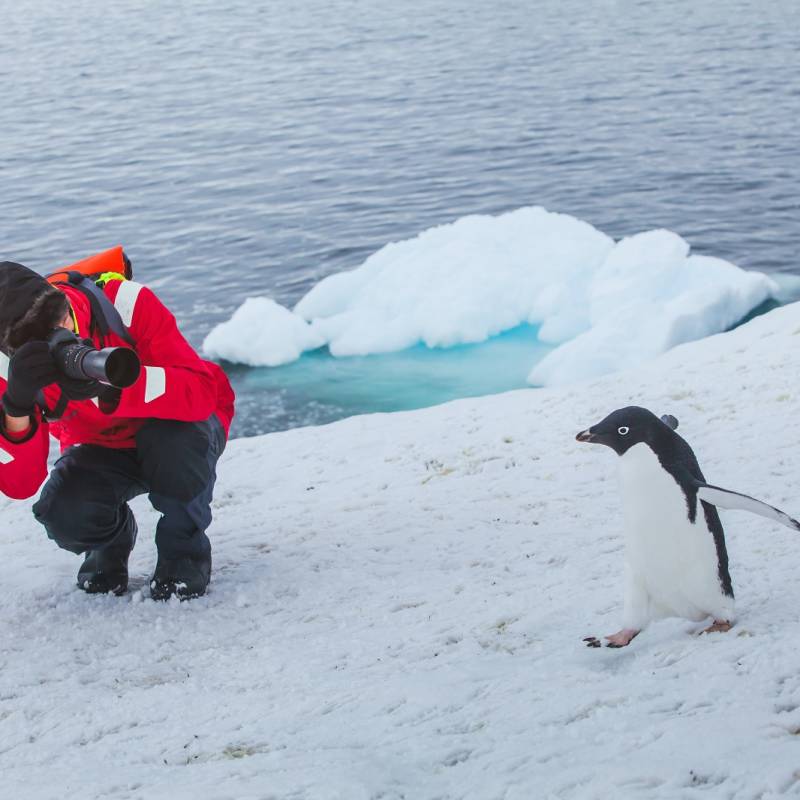
From the Blog
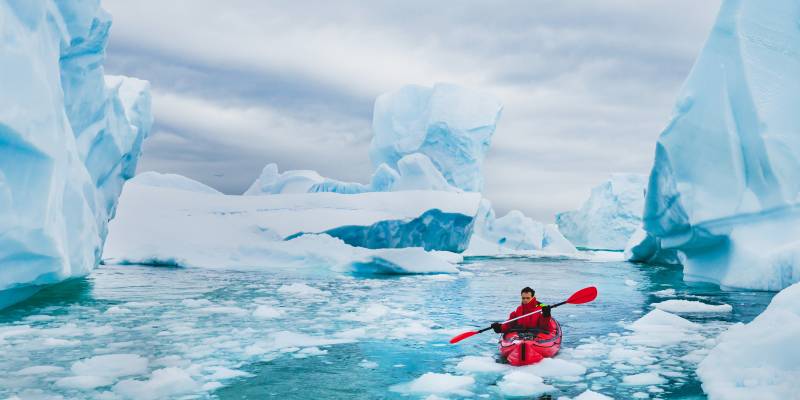
Antarctica Vacation: Into the Deep
Antarctica is literally frozen in time. Blanketed in a stark, surreal yet strikingly beautiful silence, it is the only uninhabited place on our planet – Earth’s last great wilderness. And this is what makes an Antarctica vacation truly exhilarating and fascinating.
Popular Trips to Antarctica
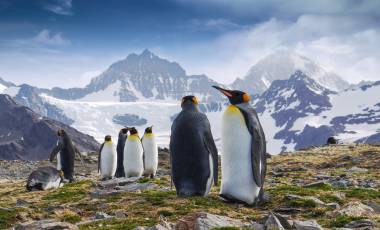
Explorers and Kings: Falklands, South Georgia, and Antarctica
Savor spectacular views of Antarctica’s fabulous landscapes and wildlife over the course of 20 memorable days. Keep an eye out for endemic birds as well as Magellanic, Gentoo and Southern Rockhopper penguins around the Falklands. The expert naturalists on board will help you spot marine wildlife such as whales and seals as you sail through…
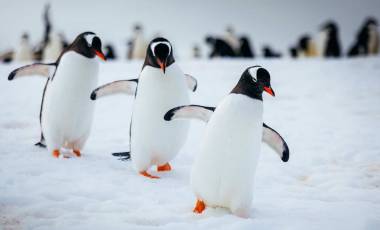
Seventh Continent Cruise with Cape Horn and Diego Ramirez
On this voyage to the South Pole, experience the highlights of the Antarctic Peninsula, the historic landmark of Cape Horn, and the albatross nesting grounds on Diego Ramirez Islands. For centuries, Antarctica has inspired explorers and discoverers around the globe – now it’s your turn! Cross the legendary Drake Strait, experience the endless expanses of…
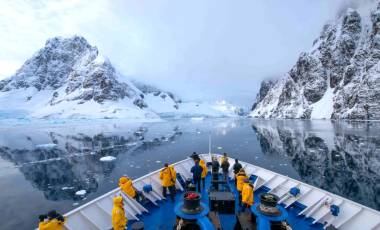
Antarctic Express: Crossing the Circle
Venture out on an adventurous journey to the South Pole! Experience what only a few have experienced before you and cross the southernmost point of our earth – in just eleven days. You’ll be crossing the Drake Strait in an airplane instead of a ship, making it possible to do this journey in a short…
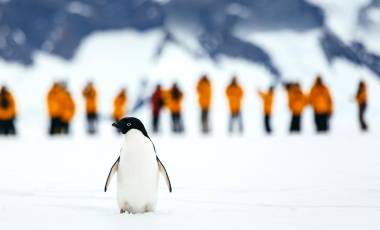
Antarctic Express: Flying the Drake
Experience all the highlights of the Antarctic Peninsula in just eight days! This expedition is ideal if you have limited time and are making your maiden voyage to the seventh continent. Fly over the famous Drake Strait by charter plane and land on King George Island in the archipelago of the South Shetland Islands, where…
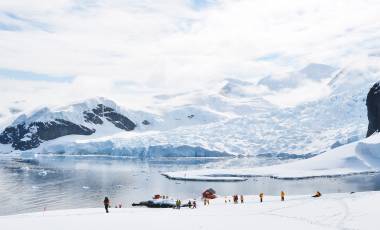
Antarctica: Crossing the Circle, Falklands and South Georgia
Witness all the highlights that Antarctica has to offer on this epic 23-day expedition! Starting at the Falkland Islands, you will see albatross, dolphins, and five species of penguins. From there, you’ll continue to South Georgia, home to 300,000 king penguins, 50 million seabirds, and five million seals. Finally, you’ll explore the Antarctic Peninsula and…
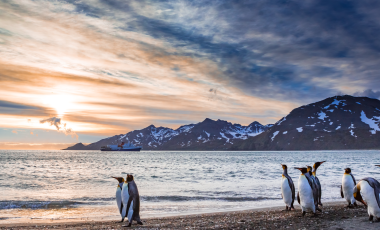
Penguin Safari: South Georgia and Antarctic Peninsula
Embark on a cruise to South Georgia and the Antarctic Peninsula. In Ushuaia, board your modern cruise ship that will be your home for the next 16 days, offering a host of activities and experiences. Admire the barren landscapes of Tierra del Fuego as you traverse the Beagle Channel. On the beaches of South Georgia,…
Things To Do
It’s not just a plain of ice white snow and a smattering of penguins. There is a breathtaking beauty to the region that can be found nowhere else on earth. Here are the top ten highlights of Antarctica.
Travel Guide
Any expedition travel to Antarctica requires flexibility and adaptation to ever-changing circumstances. The weather like anywhere else, is unpredictable. Follow the link below to read our travel tips.
The Enchanting Difference
Authentic & unique.
Our award-winning, licensed local guides provide incredible insights and exclusive experiences for you.
Personalized & Private
Our experts completely customize your private tour to match your interests and preferences.
High-Quality Experiences
All our accommodations and services are personally tested by our team.
Fully Supported Travel
You’ll have a personal and dedicated trip coordinator, backed by 24/7 support in case of emergencies while you’re traveling.
Financial Protection & Flexibility
Your booking is flexible and completely secure with us.
Safe & Secure
Your safety and well-being are our top priorities.
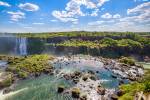
Do you have a vacation in mind? Personalize your itinerary with our Trip Builder.

The best time to visit Antarctica: A month-by-month guide
Published 28th January 2020 in Travel Advice By Tom O'Hara

Related links
- Share on Facebook
- Share on Twitter
Marooned at the bottom of the world, surrounded by roiling seas and covered in a thick layer of ice, Antarctica is without doubt the most remote and inhospitable continent on earth. Read on for your guide to the best time to visit Antarctica.
Yet for a few months each year, during the southern hemisphere's summer months, this fascinating wilderness becomes accessible to polar expedition ships. The days grow lighter and longer, the temperature rises, the sea ice retreats and Antarctica comes alive with an astonishing abundance of wildlife.
The short Antarctic cruise season runs from late October to March, and even within this narrow window there are considerable variations in what you'll see. The early season means colder temperatures and pristine snowy landscapes, while December and January are the most popular months to visit Antarctica , when the weather is warmer and the days are longer. Towards the end of the season you'll have more chance of seeing whales, and the shrinking sea ice means you'll be able to travel deeper into the Antarctic.

We're often asked about the best time to cross the Drake Passage , the notoriously bumpy stretch of water that lies between South America and the Antarctic Peninsula, but in truth you can experience bad weather and rough seas at any time of year.
You're better off basing your decision on the wildlife you want to see, the area of Antarctica you want to visit and how much money you want to spend. To help you in this task, here is our month-by-month guide to visiting Antarctica by expedition cruise:
It's rare for cruises to visit Antarctica as early as October, and those that do will usually only arrive here at the end of the month. It will still be very cold, with sea ice lingering around the Antarctic Peninsula, and the days are short, though this does mean that you should enjoy some lovely sunsets. Other advantages to visiting at the beginning of the season include lower fares, pristine snowy landscapes and bigger icebergs, and there will be very few other ships, so it can be a great time for photography. Look out for penguins and seals perched on smaller icebergs!
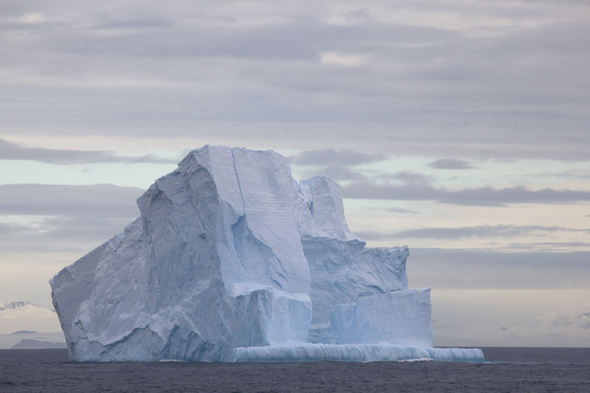
November is when most cruise lines kick off their Antarctica season, and as with October, you can expect landing sites that are yet to be sullied by penguin excrement and other tourists trampling on the snow. The days start to lengthen and penguin chicks start to hatch, while fares begin to rise the further into November you get. If you opt for a cruise combining Antarctica with South Georgia then this is the best time to see elephant seals courting, and it's the beginning of the mating season for penguins in South Georgia and the Falklands . Beautiful spring wildflowers are in bloom on the subantarctic islands, and albatrosses, petrels and other seabirds can be spotted over the Drake Passage. November also offers the opportunity to travel into the Weddell Sea on an icebreaker and visit remote emperor penguin colonies.

December is arguably the best month to visit Antarctica , with temperatures approaching their warmest (by Antarctic standards), long hours of daylight and wildlife active everywhere. It's also the most expensive time to visit, particularly over Christmas and New Year, when flights between the UK and Argentina are at their dearest. Make sure you book well in advance! Wildlife highlights include migrating whales passing through, seal pups on the beaches of South Georgia, and the courting season for seabirds, making this a good time for birding enthusiasts. If you want to know more about what to expect on a December cruise to Antarctica, make sure you read Alex's review of his Christmas cruise to the Antarctic Peninsula with Silversea.

Peak season for Antarctica continues into January, with near 24-hour daylight giving you ample opportunity to snap away with your camera. In early January you can expect to see adorably fluffy grey penguin chicks, and it's also a good month for spotting seals and whales. As the sea ice breaks up in eastern Antarctica you have the chance to join one of the rare voyages into the Ross Sea, where you can visit the remote huts used by Scott and Shackleton on their famous expeditions. These sailings are typically amongst the most expensive Antarctica cruises on offer, but they offer you the chance to go ashore in places where few other people have ever set foot.

February is the best time for whale watching in Antarctica, with species including humpback, sperm, minke, southern right and orca, and you still have a chance of seeing penguin chicks. Fur seals are also abundant at this time of year, and you'll find that seal pups are more inquisitive now that their parents are out hunting in the surrounding seas. By this point in the season you're unlikely to encounter any issues with sea ice, and this is the best month for cruises that venture beyond the Polar Circle. In South Georgia you may also find that the wandering albatross nesting sites, which are closed during the mid-season to protect hatching chicks, are now open to visit.
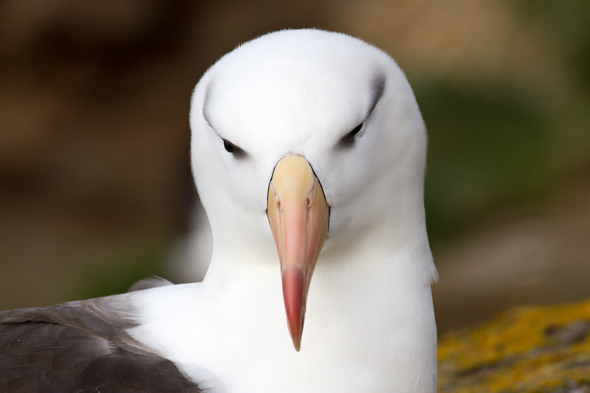
In March the season begins to wind down, and you'll see fewer and fewer ships in Antarctica as the month progresses. By this point it's too late to see penguin chicks and temperatures are getting colder, though it's a still great time to spot whales, and fur seals are abundant on the Antarctic Peninsula. With snow cover at its lowest and the penguins moulting, this is perhaps not the month to see Antarctica at its most photogenic, but you will likely experience some spectacular sunsets, and there are often some great value fares on offer.

April to September
By April the cruise ships have left Antarctica, almost without exception; on very rare occasions you may still find icebreakers venturing this far south. During the Antarctic winter the temperature drops precipitously, darkness descends and stormy seas rage, keeping out all but the hardiest scientists and film crews.

Get your free Antarctica guide
Our expedition cruising guide to Antarctica will tell you everything you need to know, including when to visit, what to see and how to get there.
Tom is a Communications Manager at the Galapagos Conservation Trust and former Marketing Manager at Mundy Adventures
Sign up for our email newsletter
Get the latest expedition cruise news and offers direct to your inbox every fortnight.
Thank you. You've been signed up successfully
Find a cruise
Antarctica expedition cruises

The Ultimate Bucket List Expedition Cruise | Pole to Pole Adventure
HX Hurtigruten Expeditions
5 Aug - 7 Nov 2024 (94 Nights)
From £34,422 pp

Between the Poles - Our Epic Global Expedition Cruise
9 Sep - 10 Nov 2024 (62 Nights)
From £27,373 pp

Ultimate Adventure | Machu Picchu, Patagonia & Antarctica
14 Oct - 7 Nov 2024 (24 Nights)
From £12,761 pp

18-Day Chilean Fjords & Antarctica
16 Oct - 5 Nov 2024 (20 Nights)
From £9,555 pp
Related articles
You may also like

Small is beautiful: benefits of a small expedition ship

8 of the most iconic wildlife species you can see on an expedition cruise

Antarctic Peninsula Cruises

Arctic vs Antarctica: Which polar expedition cruise to choose?
020 7399 7630

- Travel Guide
Best Time To Visit Antarctica: Wildlife & Weather By Month
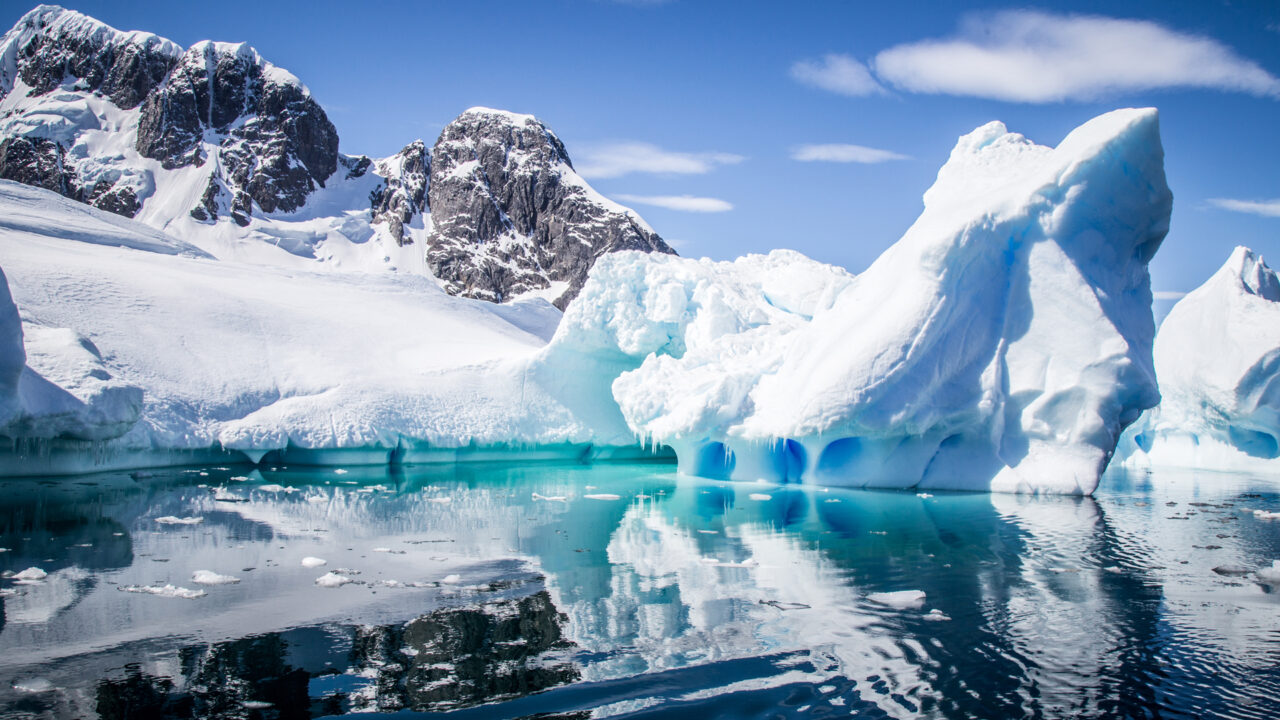
Antarctica Cruise Season: The Austral Summer
Month-by-month guide to antarctica’s travel season (including antarctica weather by month), deciding on the best time to visit antarctica.
For a good chunk of the year—the roughly six months of the austral winter—Antarctica is utterly frigid, storm-wracked, and dark. Some hardy scientists tough out this most unforgiving global manifestation of wintertime, but this is (understandably) not the time of year for general-purpose sightseeing in the coldest place on Earth.
Though Antarctica is most crudely classified as a two-season climate, swinging between winter and summer, brief transitional periods in between give the White Continent something of a version of spring and fall. Variations in weather, ice cover, and wildlife activity enhance the seasonal rhythms across the prime tourist period here and its “shoulder seasons.”
Because travelers have their own interests and personal preferences, this means there’s not a single, clear-cut answer to “When is the best time to go to Antarctica?”. That said, given the relatively narrow window for tourism, Antarctica is something of a more straightforward travel destination when it comes to scheduling than most places.
Read on for an overview of the prime polar tourism season here, Antarctica average temperature by month, when which wildlife can be spotted, and other useful details to consider while planning your once-in-a-lifetime odyssey to the bottom of the world!
The short Antarctic cruise season typically runs from November to March during the austral summer, though some limited cruises kick off in late October and extend a little into April. This is the only feasible interval for cruising to the White Continent, as summer marks the breakup and retreat of the seasonal ice pack surrounding the remote landmass. Increasing daylength, warming temperatures, and pack-ice decline not only affords sightseeing access to the Antarctic mainland, but also sparks a magnificent flurry of wildlife activity here: from nesting penguins and pupping seals to an influx of hungry whales.
The most popular months for visiting this icy realm are December and January, when the weather is warmest (relatively speaking, of course) and day length extends the better part of 24 hours. But, as we’ll get into, there are definite perks to coming during the earlier and later parts of that tantalizing austral summer.
In the following breakdown of the Antarctic travel season, we’ll spell out basic conditions—including average temperatures for Esperanza Base on the Antarctic Peninsula (the top sightseeing area on the mainland and the mildest part of the White Continent)—as well as specific highlights of each month of the austral summer, including its peripheral spring and fall shoulder periods.
Mount Erebus on a windy day
The early and middle parts of October aren’t in the tourism window for Antarctica, as the continent is still mostly in late-winter mode, with cold temperatures and short days. Toward the end of the month, however, some cruises get underway to provide hardy tourists with a taste for Antarctica at its most pristine.
Weather: October’s mean temperature at Esperanza Base is -4.3°C (24.3°F), with conditions getting (unsurprisingly) balmier toward the end of the month—though still plenty nippy!
Advantages/Scenic Highlights: Besides feeling a fuller dose of that prevailing Antarctic cold (and the chance to nab lower fares), an end-of-October voyage offers many enticements—not least magnificent and extensive sea ice, including numerous large ice floes and icebergs around the Antarctic Peninsula. Photographers relish the huge ice formations, the uncrowded channels and unsoiled snow-scapes—the latter also delighting skiers and snowshoers—and the dramatic sunset shows.
Wildlife: Spring mating rituals are in full swing on the packed beaches of South Georgia where nearly half a million elephant seals line its shores, and belligerent bulls engage in their bloody battles of bravado. Breeding activities among seabirds and penguins on the Antarctic Peninsula are showing signs of getting underway, and Weddell and crabeater seals are having their pups on the ice. There’s some possibility of seeking out remote colonies of emperor penguins.
View our October Antarctica cruises here .
November is when tourism to Antarctica really kicks off, as ever-expanding daylight hours and the retracting sea ice mark the Antarctic “spring” in full force.
Weather: Days continue to lengthen, with better than 15 hours of daylight. Average monthly temperature at Esperanza Base is -1.1°C (30°F).
Advantages/Scenic Highlights: Prime skiing and snowshoeing conditions continue, while kayaking possibilities expand. This is a fine time of year for trekking afoot on fast ice, the form of sea ice connected to shore. Speaking of, there’s still lots of dazzlingly beautiful ice to behold and photograph, including ornate icebergs. Prices tend to be lower here on the front-end of the season.
Wildlife: Pinniped, seabird, and penguin rookeries are busy on the sub-Antarctic islands—also abloom with spring wildflower—and on the Antarctic Peninsula, where gentoo, Adelie, macaroni, and chinstrap penguins breed.
View our November Antarctica cruises here .
Among the most popular months for visiting Antarctica—not least on account of holidays and school vacations—December includes the austral summer solstice, with maximal daylight shining down on some spectacular scenery and wildlife action.
Weather: Close to 24 hours of daylight give you a taste for the seduction of the Midnight Sun. Temperatures on the Antarctic Peninsula commonly get above freezing, even into downright balmy territory. The mean December temperature at Esperanza Base is 0.8°C (33.4°F), with an average high of 3.8°C (38.8°F).
Advantages/Scenic Highlights: Especially in the first part of the month, gorgeous ice floes and bergs remain plentiful. Even as the ice formations diminish with December’s progression, the opportunity to see (and hear) calving glaciers offers ample compensation. Alongside kayaking, camping, and other adventuring, the main diving season commences by the middle of the month or so. All of that summertime daylight provides many hours for recreation, wildlife-watching, and photography.
Wildlife: Penguin hatchlings and fuzzy chicks offer a delightful, crowd-pleasing spectacle in December, while seabird nesting and young-feeding are going full force. Seals and their growing pups are readily seen, and whales begin trickling into their Antarctic feeding grounds.
View our December Antarctica cruises here .
The chicks follow the lead
January is also absolutely prime time for Antarctic tourism, with optimal weather, long days, and increasingly extensive access to the mainland inshore and coastline.
Weather: Even as the days begin to contract following the solstice, there’s still an absolute surfeit of extended sunshine in January. This is also the warmest month on average, with temperatures on the Antarctic Peninsula occasionally running up into the mid-teens°C (upper 50s°F). The mean monthly temperature at Esperanza Base is 1.4°C (34.5°F), with an average daily high of 4.3°C (39.7°F).
Advantages/Scenic Highlights: With the sea ice significantly receding, this month can often mean feasible voyages deeper into the wilds of the White Continent: If conditions allow, some cruise ships venture beyond the Antarctic Circle, while visiting the Ross Sea—where the remarkable huts of early-20th-century South Pole explorers Robert Falcon Scott and Ernest Shackleton await—may be possible.
Wildlife: Penguin-watching remains extraordinary, with cute-as-heck chicks on full display and parents burning the candle at both ends to feed them. Seabird rookeries are also raucous nurseries. And whales continue to increase in number around the Antarctic Peninsula.
View our January Antarctica cruises here .
February generally continues to offer fine weather and remains a popular time to come to Antarctica, though tourist levels are ebbing past the December/January peak.
Weather: Daylength continues to decrease, but temperatures remain invitingly mild by polar standards—Esperanza Base sees a monthly mean of 0.7°C (33.3°F) and an average daily high of 3.7°C (38.7°F)—and the weather typically calm.
Advantages/Scenic Highlights: As sea ice approaches its yearly minimum, opportunities for exploring south of the Antarctic Circle and into the Ross Sea are rich.
Wildlife: Even as penguin- and seabird-viewing diminishes somewhat, February offers peak whale-watching as humpbacks, minkes, and other baleen species feast on the seasonal smorgasbord of krill, and orcas prowl for seal pups and young penguins.
View our February Antarctica cruises here .
Taking photos of whales – you better be fast!
The tail-end of the austral summer means less-cluttered sightseeing waterways, a minimum of sea ice, and the chance to experience special delights of the “Antarctic fall.”
Weather: Daylength is decreasing at a steady clip (some 15 minutes per day), and temperatures are cooling off as winter approaches; Esperanza Base’s mean March temperature is -2.3°C (27.9°F).
Advantages/Scenic Highlights: As autumn falls on Antarctica, so do cruise prices; March is one of the cheapest times to visit Antarctica. Less ship traffic this time of year ups the delicious feel of Antarctic wildness. The water is clearer for diving and leopard seals start to hunt the ever braver penguin chicks. The sea ice is at its minimum extent, luring late cruises past the Antarctic Circle. The lowering sun enhances colors for landscape photography, and starry skies of dazzling purity—perhaps a show of the Aurora Australis, aka the Southern Lights—come with nightfall.
Wildlife: Whale activity remains outstanding in March, as the local leviathans fatten up ahead of their northbound migration.
View our March Antarctica cruises here .
As we hope the above has made clear, each stretch of the austral summer in Antarctica provides its own unique draw. For many people, not least first-time visitors, the best time of year to travel to Antarctica is December and January, when you’ve got optimal weather, oodles of daylight, a nice combination of scenic attractions, and rich wildlife-viewing. But folks with specific goals in mind may prefer other windows, especially if they are price sensitive or wish to partake in certain adventure activity options.
Skiers and snowshoers will find the best conditions in November and early December. Scuba divers typically do their thing mid-December through mid-February, when water temperatures off the Antarctic Peninsula typically range from the upper 20s to mid-30s (F); water clarity tends to be better earlier in the season, before the spike in plankton. Those wishing to go camping on the White Continent should note that this activity isn’t usually available after January due to campsite deterioration and unsuitable conditions underfoot.
On the wildlife front, the peak penguin show tends to be mid-December into January with the hatching and rearing of chicks. But whale-watchers will do better to aim for mid to late summer, especially February and early March. If you are an avid photographer who wants to capture shots of nesting wandering albatrosses on South Georgia’s Prion Island, you’ll need to time your visit outside of 20th November – 7th January (inclusive) as the island is closed during this time.
Expect the priciest itineraries during the peak season of December through mid-February, especially late December into January. Lower fares are generally available earlier and later in the season.
The best time to go to Antarctica is obviously the austral summer, but within that period you’re likely to be richly rewarded—and coming home awash with lifelong memories—whenever you can make the trip happen!
You May Also Be Interested In
A history of fur & elephant seal hunting in antarctica, antarctica’s whaling history & abandoned whaling stations, how to find the best antarctica travel insurance for you, the prehistory & fossils of antarctica, antarctic plants: pearlwort, hair grass & palm trees, the 7 penguin species of antarctica & the sub-antarctic, antarctic birds: a guide to bird watching in antarctica, antarctic pinnipeds: the 6 seal species of antarctica, antarctic fish & crustaceans: toothfish, icefish, krill & other species.
Our travel guides are for informational purposes only. While we aim to provide accurate and up-to-date information, Antarctica Cruises makes no representations as to the accuracy or completeness of any information in our guides or found by following any link on this site.
Antarctica Cruises cannot and will not accept responsibility for any omissions or inaccuracies, or for any consequences arising therefrom, including any losses, injuries, or damages resulting from the display or use of this information.
Ready for the adventure of a lifetime?
Get in touch with us via phone or form today and you’ll be assigned a dedicated Antarctica specialist who’ll be with you every step of the way to help you choose, book and plan the right Antarctica cruise for you. Here’s how it works:
Listen & Match
We’ll carefully listen to your aspirations and curate an impartial shortlist of personalized polar cruise recommendations—and pre- and post-cruise extensions—to match your desired experience.
Reserve & Relax
Next we’ll place a free, no obligation, 24-hour cabin hold on your preferred cruise option whilst we discuss the final details. Book and relax safe in the knowledge you’ll be paying the lowest price guaranteed.
Prepare & Travel
Then we’ll provide you with our expert packing advice, insider travel tips, and more to ensure you are fully prepared for—and maximize your enjoyment of—your once-in-a-lifetime Antarctica expedition.
- With Partner/Friend
- With Family
- As Part Of A Group
- Emperor Penguin
- Photography
- Exploration Heritage
- Antarctic Peninsula
- Antarctic Circle
- Falklands/S. Georgia
- Weddell Sea
- Ross Sea/E. Antarctica
Best Time To Visit Antarctica
The endless wilderness of antarctica is accessible by expedition cruise and flights between late october and late march, offering the best possibilities for wildlife viewing and exploring., when to visit antarctica.
After a long and harsh winter, Antarctica becomes alive again during the summer months. The first expedition ships arrive in late October and early November with a pristine frozen polar wilderness. By December, the wildlife in Antarctica is bustling with hatching penguins and seals pupping on the remote beaches. In the height of the summer, during January and February, the days are long, the newborn wildlife takes to the waters for the first time, and longer length expeditions to reach the polar circle are possible. In March, the whales are at the height of their activity as the sea ice returns.
Each month in Antarctica offers the explorer a different experience, and many guests return to visit at other times of the year. This guide, produced by our in-house polar experts with decades of firsthand experience of visiting Antarctica, provides a detailed breakdown of the best time to visit Antarctica, with month-by-month highlights of what to expect to help you plan your expedition.
Antarctica Month By Month Guide
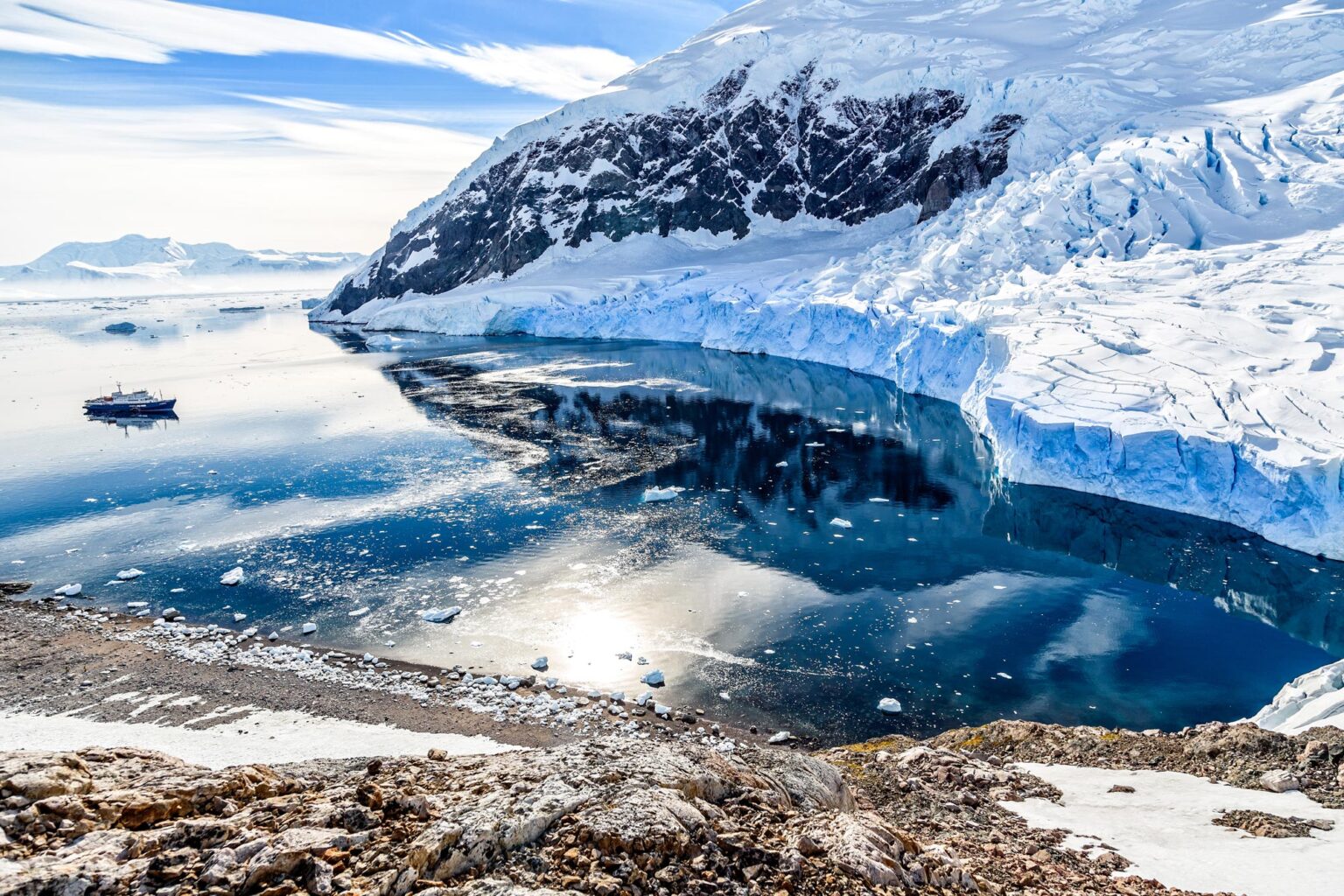
Visiting Antarctica in October
Visiting Antarctica in October has its unique appeal. However, it's important to note that October is considered the late spring season, and certain factors, such as weather conditions and sea ice, can influence the overall experience. There are few cruises to Antarctica this early in the season, but if you do choose to visit in October, these are some of the potential highlights:
Pristine Landscapes
October marks the beginning of the Antarctic travel season. The landscape is still covered in snow and ice, providing a pristine and untouched appearance. The scenery is breathtaking, with towering icebergs, glaciers, and vast expanses of white wilderness.
Early Wildlife Preparations
During October, wildlife becomes more active as the breeding season approaches. Penguins, seals, and seabirds are preparing for nesting, and you may witness their behaviours as they establish territories and build nests.
Photography Opportunities
Antarctica's soft light in late spring can create stunning photographic opportunities. The pristine ice formations, wildlife activities, and unique lighting conditions can create captivating images.
Fewer Visitors
October is considered the shoulder season, with fewer tourists than the peak months of the austral summer (November to March). This can provide a more intimate and quieter experience, with fewer expedition vessels in the area.
While October has its advantages, there are also considerations to consider. The weather can be colder, and sea ice conditions may limit access to certain areas. Wildlife activities are in the early stages, and you may not witness the peak of breeding season behaviours. If you're seeking warmer temperatures and a higher likelihood of wildlife sightings, visiting later in the austral summer may be more suitable.
Visiting Antarctica in November
Visiting Antarctica in November marks the beginning of the austral summer and offers unique highlights. Here are some key aspects to consider:
Penguin Courtship and Nesting
November is the start of the breeding season for penguins. A highlight can be witnessing the courtship rituals, nest-building, and egg-laying activities of various penguin species, such as Adélie, Gentoo, and chinstrap penguins.
Seals, including Weddell and crabeater seals, give birth to their pups in November. This is an opportune time to observe seal colonies with newborn pups, witnessing their early interactions and behaviours.
Whale Watching
November is a good time for whale watching in Antarctica. Humpback whales, minke whales, and orcas are among the species that may be spotted. This is a chance to witness these majestic creatures return to feed in the Antarctic waters.
Wildflower Blooms Arrive
While Antarctica is not known for its plant life, some hardy mosses and lichens experience a brief period of growth during the austral summer. In November, you may see the emergence of these tiny plants, adding a touch of colour to the landscape.
Migratory Birds
November sees the return of migratory seabirds to Antarctica for the breeding season. This time, species like skuas, petrels, and sheathbills can be observed.
Ice and Snowscapes
The landscapes are still pristine, with extensive ice formations and snow-covered terrain. The soft lighting of late spring can create beautiful and unique scenes for photography.
November is the beginning of the Antarctic travel season, and there are generally fewer tourists compared to the peak months of December to February. This can provide a more intimate and less crowded experience.
While November offers exciting opportunities, it's important to note that conditions can be colder compared to later in the season. Access to certain areas may still be limited by sea ice, and wildlife activities are in the early stages.
Visiting Antarctica in December
Visiting Antarctica in December is considered the peak of the austral summer and offers a range of highlights. Here are some key highlights of visiting in December.
Penguin Chicks
In December, many penguin chicks hatch, and you can observe adult penguins actively caring for and feeding their young. Adélie, chinstrap, and gentoo penguins, among others, provide adorable and photogenic scenes.
Seal Pups and Seal Activities
December is a prime time to observe seal pups, particularly Weddell and crabeater seals. You can witness seal colonies with playful pups and keep various seal species engaging in behaviours such as basking on ice floes.
December offers good opportunities for whale watching in Antarctica. Humpback whales, minke whales, orcas, and other whale species are often seen feeding and breaching in the waters surrounding the continent.
December is suitable for birdwatchers as migratory seabirds, such as skuas, petrels, and sheathbills, actively nest and engage in breeding behaviors.
Midnight Sun
Antarctica experiences long daylight hours in December due to the midnight sun phenomenon. This provides ample opportunities for extended wildlife viewing, photography, and exploration without the constraints of darkness.
Warmest Temperatures
While temperatures in Antarctica are still relatively cold, December tends to be one of the warmer months of the austral summer. Warmer temperatures make outdoor activities more comfortable for visitors.
It's essential to plan your trip well in advance, as December is a popular time for Antarctic expeditions, and cruise availability may be limited.

Visiting Antarctica in January
Visiting Antarctica in January is often considered the height of the austral summer and offers numerous highlights.
Peak Wildlife Activity
January is a month of peak wildlife activity in Antarctica. As chicks grow, penguin colonies bustle with life, and adults feed and care for them. Seals, including Weddell and crabeater seals, can be observed in various stages of their life cycles.
Penguin Chicks and Moulting
In January, many penguin chicks are in the late stages of their development, making it an ideal time to witness adorable and active penguin colonies. Additionally, some penguin species undergo their annual moulting process during this month.
January is a good time for whale watching in Antarctica. Humpback, minke, orcas, and other whale species are frequently spotted in nutrient-rich waters. This is a perfect opportunity to witness their feeding and breaching behaviours and, if lucky, on a Zodiac ride up close.
Seal colonies continue to be active with seal pups, providing opportunities to observe their playful behaviour and interactions with adults. Leopard seals, known for their menacing jaws, are often seen on ice floes.
January is still a time when migratory seabirds are active in Antarctica. Skuas, petrels, and other bird species are involved in nesting and breeding activities, making this period exciting for birdwatchers.
The Antarctic summer peaks in January, resulting in long daylight hours and the phenomenon of the midnight sun. This provides ample time for outdoor activities, wildlife viewing, and photography without the constraints of darkness.
Warmer Temperatures
January is one of Antarctica's warmest months, making outdoor exploration more comfortable for visitors. However, it's important to note that "warmer" in Antarctica is still relatively cold compared to other destinations.
Planning your trip well in advance is crucial, as January is a peak month for Antarctic tourism, and expedition opportunities may fill up quickly.
Visiting Antarctica in February
Visiting Antarctica in February continues the austral summer, providing unique opportunities to experience the region's wildlife and landscapes. Here are some highlights of visiting Antarctica in February:
February is still a month of peak wildlife activity in Antarctica. Penguin colonies remain active with chicks, and you can witness various stages of their development. Seals, including Weddell and crabeater seals, stay present, and leopard seals may still be observed.
February is an excellent month for whale watching in Antarctica. Humpback whales, minke whales, orcas, and other whale species are often spotted, and this is a prime time to witness their feeding behaviours.
Penguin Chicks
Many penguin chicks still exist in colonies, providing opportunities to observe their behaviour and interactions. Some penguin species undergo moulting during February, adding another exciting aspect to their life cycle.
Seal colonies remain active with seal pups, offering ongoing opportunities to observe their playful behaviour and interactions with adults. Depending on the specific species, you may still encounter Weddell and crabeater seals with their pups.
The midnight sun continues in February, providing extended daylight for outdoor activities, wildlife viewing, and photography.
February is one of the warmest months in Antarctica, offering more comfortable conditions for outdoor exploration. However, it's important to note that temperatures in Antarctica are still relatively cold compared to other destinations.
Icebergs and Glacial Scenery
In February, the ice formations and glaciers remain stunning. Calving icebergs, towering glacier fronts, and pristine ice-covered landscapes create breathtaking scenes.
End of Breeding Season
February marks the end of the breeding season for many species. Some wildlife, including penguins, may start to disperse from their colonies, but this can also offer unique opportunities to observe their behaviour during this transitional period.
It's essential to plan your trip well in advance, as February is considered a peak month for Antarctica cruises.
Visiting Antarctica in March
Visiting Antarctica in March marks the end of the austral summer, and while wildlife activity may start to decrease, there are still unique highlights to experience:
March is a transitional period, but you may still encounter penguin chicks in various stages of development. Observing their growth and interactions with adult penguins can be a highlight.
Seal colonies, especially those of Weddell seals and crabeater seals, may still have pups. This provides opportunities to witness the last stages of seal pupping and observe their behaviour.
March is considered an excellent month for whale watching as many species, including fins, humpbacks, minkes, and orcas, are most active now.
Birdwatching
March sees the continued presence of migratory seabirds. Although some species may start their migration north, others may still actively engage in breeding and nesting activities, offering opportunities for birdwatchers.
Stunning Landscapes
In March, the ice formations and glacial landscapes are still impressive. Icebergs, glaciers, and the unique scenery of Antarctica provide fantastic photo opportunities.
Sunset Photography
March brings shorter days as the Antarctic summer ends. This can provide unique opportunities for sunset photography, capturing the beauty of the landscape in softer lighting.
March is the tail end of the tourist season in Antarctica, and there are generally fewer visitors compared to the peak months of December to February. This can result in a quieter and more intimate experience.
It's important to note that March marks the beginning of autumn in Antarctica, and temperatures may drop. Also, due to sea ice formation, access to some areas may become limited. While wildlife activity may not be at its peak, the quieter atmosphere and unique lighting conditions can make March a memorable and more serene experience.
Visiting Antarctica Between April - September
Visiting Antarctica between April and September is challenging due to the harsh winter conditions. During this period, the continent experiences extreme cold, long nights, and extensive sea ice, making it nearly inaccessible for most travellers. There are no expedition cruises to Antarctica during these winter months.
Several factors contribute to the challenging conditions:
Extreme Cold
Antarctica's temperatures can be extremely low during the winter, often well below freezing. Combined with strong winds, the wind chill can create a harsh, inhospitable environment for extended periods.
Long Polar Night
From late April to mid-September, Antarctica is in the midst of its polar night. This means the sun remains below the horizon, resulting in continuous darkness for several months. The absence of sunlight limits visibility and makes outdoor activities challenging.
Sea ice coverage increases significantly during winter, making maritime travel difficult. The frozen expanses of sea ice hinder access to many areas along the Antarctic coastline.
Limited Wildlife Activity
Most wildlife in Antarctica is adapted to the harsh conditions but tends to be less active during the winter. Many species, including penguins, seals, and migratory birds, migrate north or spend the winter months in the sea.
Isolation and Safety Concerns
Inhospitable conditions, limited infrastructure, and support services make winter travel to Antarctica logistically challenging and potentially dangerous. Few research stations operate during this period, and visitor access is highly restricted.
While visiting Antarctica during the winter months is not practical for tourists, it is crucial for scientific research. Researchers stationed at various Antarctic research stations continue their work during the winter, contributing to our understanding of the region's climate, geology, and biology.
If you are interested in experiencing Antarctica, the austral summer months (November to March) offer the best opportunities for exploration, wildlife observation, and a more comfortable travel experience.
Best Time To Visit Antarctica To See Wildlife
The best time to visit Antarctica to see wildlife is between November and March during the summer, which coincides with the expedition cruising season. Due to the extreme temperatures during the winter, most of the wildlife leaves Antarctica, except a few species, such as the Emperor and Adelie Penguins, due to its inhospitable climate.
The best month for wildlife watching in Antarctica depends on your individual preferences and what breeding cycles you would like to witness.
Best Time to Visit Antarctica to See Penguins
The best time to see penguins in Antarctica is between November and March. During this period, the temperatures are relatively milder, and the sea ice has receded, allowing easier access to various penguin colonies.
November and December are exciting times for penguin observation. During these months, you can witness the nesting and breeding activities of penguins and the hatching of chicks. Penguins such as Adélie, Chinstrap, and Gentoo build nests and lay eggs during this time.
January and February are also excellent months for observing penguins. The chicks are more visible, and the penguin colonies are bustling with activity. Penguins feed their chicks actively, and you may observe interactions between adults and their young.
Best Time to Visit Antarctica to See Whales
The best time to see whales in Antarctica is during the austral summer, which runs from November to March. The weather conditions are more favourable for travel, and the sea ice has melted enough to access various parts of the region.
The specific timing within this period can impact the types of whales you may encounter. November and December are often the best months for seeing feeding and courtship behaviours and witnessing newborn seal pups and penguin chicks. January, February and Early March are peak months for whale watching, with increased whale activity, particularly around the Antarctic Peninsula.
During this time, you may have the opportunity to see various whale species, including humpback whales, fin whales, minke whales, orcas, and occasionally blue whales. Remember that wildlife sightings can vary, and there are no guarantees, but the austral summer provides the best chance for observing whales in Antarctica.
Best Time to Visit Antarctica To See Seals
Antarctica is home to various seal species, including Weddell seals, crabeater seals, leopard seals, fur seals, Ross seals and Southern elephant seals. Seals are frequently sighted in Antarctica between November and March, and they are most active during this time, engaging in breeding, pupping, and other behaviours.
November and December are the best months to witness mother seals giving birth to their pups, watching the newborns litter the beaches, and swimming for the first time.
January and February offer the most active months for seal-watching in Antarctica. Seals continue to pup during this period, and leopard seals commonly rest on ice flows with their furious-looking jaws.
Best Time To Visit Antarctica for Photography
The best time to visit Antarctica for photography is between November and March. Still, the best month depends on your interests (wildlife or landscape) and the images you want to capture.
November & December (Late Spring and Early Summer)
The early season is the best time to visit Antarctica if you are a landscape photographer looking to capture the pristine white wilderness as it emerges from the winter. Most of the landscape is covered by snow, and it is an excellent time to capture ice formations and the best chance of photographing sea ice.
January and February (Mid-Summer)
The best time to visit Antarctica for wildlife photography is during the peak summer months when the wildlife is most active on the Antarctic Peninsula. Penguin rookeries are fully alive, and elephant seals line the beaches. The longer days lead to more possibilities to explore, and the temperatures are at their mildest.
February and March (Late Summer and Early Autumn)
The end of the season, as the sun begins to lower in the sky, offers dramatic light conditions for landscape photographers. It is also the best time of year to see whales in Antarctica. Other wildlife, including penguins and seals, are still active. Towards the end of March, snow and sea ice return, offering countless photography opportunities.
Best Time To Visit Antarctica For An Expedition Cruise
The best time to visit Antarctica to embark on an expedition cruise is during the summer between November and March. This season offers the best possibilities for wildlife viewing, the mildest temperatures and the best access with the most favourable weather conditions and sea ice extent. Different types of cruises to Antarctica take place at throughout the summer season. Search our Antarctica Cruises here.
Best Time To Visit Antarctica for Fly and Cruise Expeditions
Fly-and-cruise expeditions to Antarctica occur during the summer between the end of November and early March. This window offers the best conditions for charter planes to land on King George Island. Flying to Antarctica to join a fly-and-cruise expedition is only possible in November and after early March.
Best Time To Visit Antarctica for Polar Circle Cruises
Expedition cruises that venture further south along the Antarctic peninsula to cross the polar circle occur at the end of the season, in February and March, when the sea ice extent is at its furthest south, and the region becomes more accessible to ships.
A great reason to visit Antarctica now is that whales are at their most active and frequently sighted. Species, including humpbacks, minkes, and fin whales, are often seen on polar circle cruises.
Best Time To Visit Antarctica for Cruises Visiting the Falkland Islands and South Georgia
Between November and March, expedition cruises visiting the Antarctic Peninsula and stopping en route at South Georgia and the Falkland Islands occur. The best time to visit Antarctica, South Georgia and the Falkland Islands comes down to what wildlife you want to experience.
In November, King Penguins return to their rookeries in South Georgia to start incubating their eggs. At St Andrews Bay, over 400,000 pairs of King Penguins nest in one of the largest rookeries on Earth. The beaches are full of elephant seal pups, and the vast bird life returns. Wildlife is most active in January and February, although sizeable male fur seals can often take over beaches and prevent shore landings. February and March offer excellent opportunities to encounter baby fur seals and King Penguin chicks that line the beaches.
Best Time To Visit Antarctica for Ross Sea Cruises
Only a handful of cruise ships visit the Ross Sea each year. Due to its more southerly and extreme location than the Antarctic Peninsula, cruises to the Ross Sea only operate in January and February at the height of the Antarctic summer when there are 24 hours of daylight and the conditions are at the mildest. Outside of these two months, visiting the Ross Sea is impossible due to the amount of sea ice and extreme temperatures.
Best Time To Visit Antarctica for Weddell Sea Cruises
Due to the thick sea ice that the Weddell Sea is known for, cruises for the Weddell Sea usually take place later in the season. The best time to cruise to the Weddell Sea is in late February and March when the sea ice extent is at its lowest and offers the best chance to visit wild and rarely visited locations. It is also possible to see the Weddell Sea earlier in the season in November on a luxury icebreaker cruise, which offers a truly unique experience to encounter the unexplored.
Best Time to Fly To Antarctica (and visit the South Pole)
Due to the extreme climate at the South Pole, flights to Antarctica have a minimal season and only occur during the summers. December and January are the best times to fly to Antarctica and visit the South Pole. Outside of these months, flying to the South Pole is impossible.
Best Time To Visit Antarctica for Kayaking
The best time to visit Antarctica for kayaking is at the height of the summer between late November and February. This period offers more favourable conditions for kayaking due to milder temperatures, reduced sea ice, and longer daylight hours.
During these months, the sea ice is generally at its minimum, creating more open water for kayaking. The warmer temperatures make the experience more comfortable, and the extended daylight hours provide ample time for exploration. Remember that specific weather and ice conditions can vary each year, so it's crucial to choose a reputable expedition company with experienced guides who can adapt to the conditions.
If you would like to participate in kayaking as part of your expedition cruise, we will provide advice about the best cruise options for kayaking in Antarctica. Please get in touch with our Travel Experience Team , who will assist you.
Best Time To Visit Antarctica for Camping
Camping in Antarctica is limited to the peak summer months, from November to February, when temperatures are more conducive for outdoor activities.
During these months, nature enthusiasts can experience the unique thrill of spending a night in the pristine wilderness of Antarctica as part of their expedition cruise.
If you would like to participate in camping as part of your expedition cruise, we will advise you about the best cruise options in Antarctica. Please contact our Travel Experience Team , who will assist you.
Help to choose the best time to visit Antarctica for your Interests
Here at North Pole Cruises, we are the experts in Antarctica, with decades of collective firsthand knowledge exploring the polar regions. We are happy to help you choose the best time to visit Antarctica based on your preferred travel dates and what you want to see and experience. Please get in touch with our knowledgeable Travel Experience Team . We will provide free, no-obligation advice to help you decide on the best month, ship and itinerary.
Do you need help planning your expedition?
Our friendly and knowledgeable Travel Experience Team is ready to assist you.

International House 6 South Molton Street Mayfair London W1K 5QF United Kingdom
Tel: +44 20 3290 8799
USA & Canada
276 5th Avenue Suite 704 New York NY 10001 USA
Tel: +1 917 267 7707
Destinations

North Pole Cruises – a brand by the Expedition Collective Limited
Ask A Question
Do you have a question for our knowledgeable Travel Experience Team? We’re all ears! Just fill out this form, and we will be in touch shortly to answer your question.
Your Guide To Exploring The Polar Regions
Subscribe to be the first to know about new voyages, exclusive offers and insider travel tips.
- Find an Expedition
- Voyage Calendar
- Travel Advisors
- Manage My Booking
- Call Now: +1-833-826-5828

Best Time to Visit Antarctica: Ultimate Month by Month Guide
Home > Blog > Activities > Best Time to Visit Antarctica: Ultimate Month by Month Guide
Last updated on February 20 th , 2024
You don’t need a crystal ball to know that if you’ve been dreaming of waddling penguins, breaching whales, and towering icebergs, an Antarctica expedition is your destiny. What your dream state is unlikely to be telling you, however, is when is the best time of year to visit Antarctica! You’ll need to know this so you can book that dream-becomes-reality vacation. That’s where our handy guide comes in, revealing everything you need to know about when to travel to the white continent.
It’s a rare traveller that doesn’t have Antarctica on their list of travel goals. It’s as away-from-it-all as you can get; a destination filled with intrigue, awe and surprises. Plus, its history of daring endeavours sheds light on the tenacity of the human spirit. Choosing when to go to Antarctica is as important as the thermals you pack and the camera or phone’s storage (spoiler alert: you will need more than you think).
The best time of year to visit Antarctica is not as simple as us saying “mid-December to mid-February”, when wildlife is at its most active. What if you’re looking for the most classic Antarctic experience? Then the start and the end of the season would suit. Or perhaps, since watching Happy Feet, you’ve been yearning to see young penguins take their first plunge? Then book a February departure.
As experts in expedition cruising for decades, we’ve compiled this handy month-by-month travel guide so you can select the best time to visit Antarctica. From when we set sail in October and return from our last trip of the season in March, there’s no best or worst time to travel to Antarctica, in our opinion. There are absolute highlights on every sailing!
When should I go to Antarctica?
You might think of Antarctica as only having one season (cold!), but there are actually two distinct seasons . The two seasons – winter and summer – are due to the Earth’s tilt and orbit around the sun. Both impact the weather, the wildlife and when you should plan your visit.
Winter in Antarctica
For six months, sea ice surrounds Antarctica, making it almost impossible to get there. It’s also during winter that the region plunges into darkness. Around 21 June, the sun vanishes over the horizon and doesn’t reappear for weeks.
Winter is when whales begin their long migration towards the equator to breed. Those penguins you can’t wait to see? They also flee north towards the advancing ice edge. In fact, the only warm-blooded animal that has the audacity to face Antarctica’s most hostile months is the staunch emperor penguin .
The lack of access and the fact that most of the wildlife on your Antarctica bingo card has migrated north tells you winter is not the ideal time to visit.
Summer in Antarctica
As always, in nature, there is balance. What is dark becomes light. What is cold becomes hot. Or ever-so-slightly warmer, in Antarctica’s case. The return of the sun sees the sea ice break lose, the glorious residents – whales, penguins, seals, and sea birds – return in droves, and Aurora Expeditions’ welcoming crew, Expedition Leader, and onboard experts excitedly prepare to set sail to the white continent for a new season of adventures.
With the best times to travel to Antarctica covering half of the year, it is no surprise there are fluctuations and changes over that long window of opportunity to explore the region. It’s important to understand the best months to meet your travel goals so you can get a clearer idea of when to set sail.
Choosing the best time to travel to Antarctica means knowing what activities are available and what wildlife is most active, when. No matter what, each month in Antarctica has its unique charms. The only disappointment when travelling to Antarctica is that the trip ends!
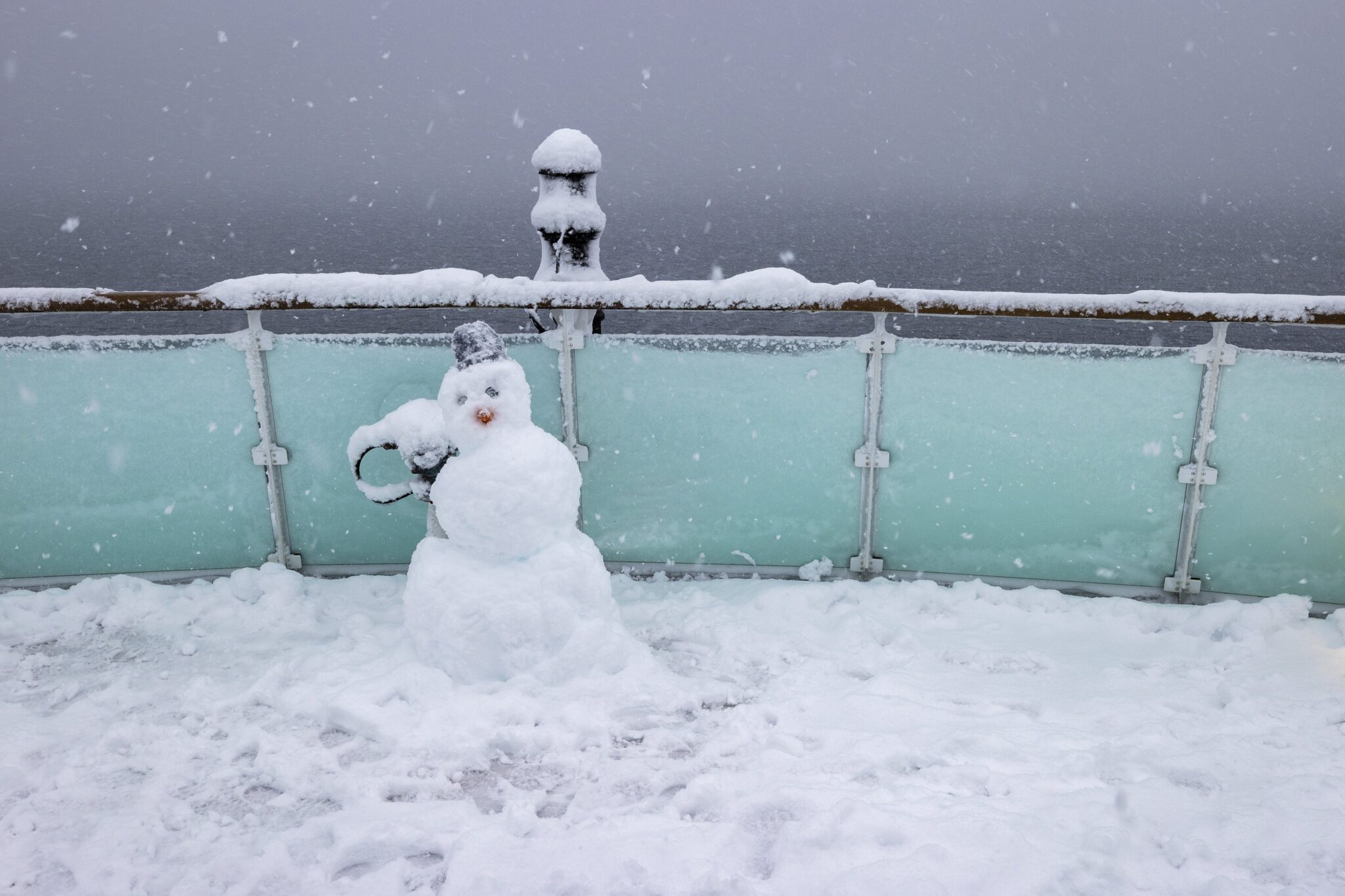
October & November
Quick guide: October and November offer untouched Antarctica with pristine landscapes, abundant sea ice and ample adventure opportunities.
When you set sail in October and November, fresh white snowscapes, slow, luminous sunsets and an ocean filled with residual sea ice await. If you’re into photography , this is an optimal time to visit. Especially as our onboard professional photographer is on hand to maximise your results. Fun fact: there is an Aurora Expeditions resident photographer on every sailing!
October is also when penguins return to the Antarctic Peninsula en masse. Seeing their signature waddle traversing a snowy slope is a memory that will last you a lifetime. If you’re fortunate, you may even witness them building their nests from small stones and their intricate courtship rituals.
From October onwards, whales also return to their feeding grounds. While eight whale species are spotted in Antarctica, there are three thrilling main whales to witness in action.
If you like a good workout while on holiday, the deep snow at some landing sites will be your training ground. Some pre-trip training is helpful for departures at this time of year, as is packing your trekking poles, or utilising the ones offered once onboard (more on packing later).
Come November, spotting an egg tucked between the legs of a penguin is an aww-worthy site. Seasonal timings vary between locations, though. November is also the month to keep your eyes peeled to maximise your chances of witnessing elephant seal pups being hauled from the ice by their colossal parents. Did you know they can’t go in the water until their moulting is complete?
A bonus of going earlier in the season for active travellers is the possibility of extra activities that put you in the middle of the action. Like camping on the ice , snowshoeing , and skiing and snowboarding (additional costs may apply). Our popular Spirit of Antarctica departures are ideal for unique add-on activities.
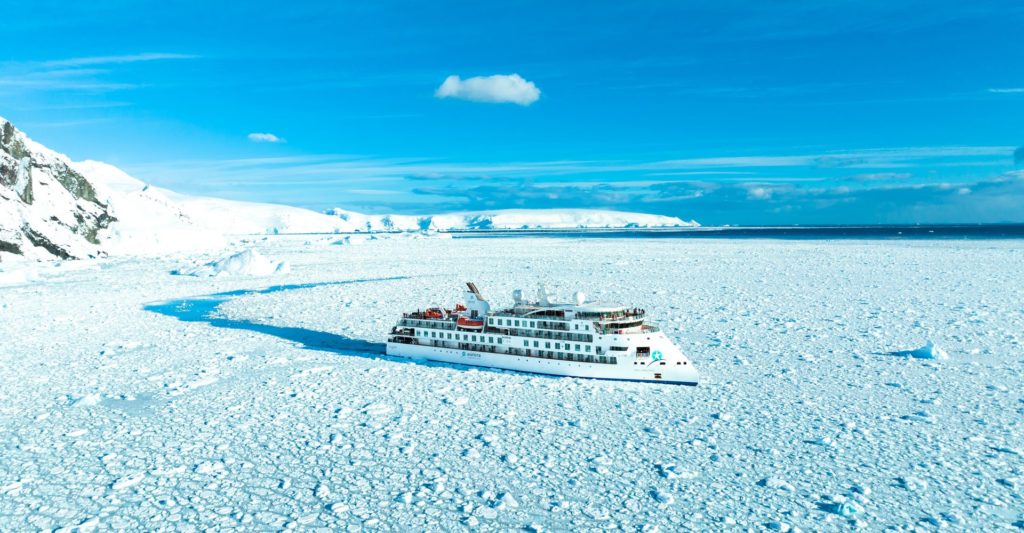
Spirit of Antarctica
Embrace the spirit of polar exploration on this classic expedition to the coveted white continent. Sail across the famed Drake Passage to and from Antarctica, admiring spectacular seabirds and approaching the ice as the explorers of old did: by sea.
With a chance to Zodiac cruise through pack ice, set foot on the continent, choose from a range of adventure options and even perhaps camp under pastel polar skies, this is the quintessential Antarctic voyage for adventure-lovers.
December & January
Quick guide: Stable weather, easier landings and newborns and juveniles across the continent, December and January are two of the most popular months to visit.
That summer feeling we all know and love is evident across all species it seems, with the penguin colonies buzzing with new life and doting parents. Seeing the downy plumage of a penguin chick is bound to give you the warm and fuzzies – and fabulous photos, of course.
However, it is not only penguins. By December, the ocean is teeming with whales feeding and crabeater seals hauling their rotund bodies onto ice floe. Plus, there’s the occasional elephant seal appearing like a celebrity at a VIP event. Many consider December one of the best months to visit Antarctica because you can also experience the ultimate white Christmas or sail into a New Year in an entirely new way!
Like Januarys the world over, the kids are playing up. Only instead of back-to-school uniforms and stationery runs, Antarctica’s penguin chicks are starting to form creches and tear through the colony with vigour and glee. It’s now that the adults begin to moult, too.
Across the continent, the sea level snow begins to melt as the days grow warmer and the temperatures rise, exposing rocky terrain in its place. When the sea ice has melted, crossing the Drake Passage is easier and traditionally calmer.
Both December and January optimise your activities and Zodiac expedition time, as you’ll enjoy around 20+ hours of daylight! That also means more time to say yes to our polar kayaking and scuba diving optional activities. Getting on or in the icy water is the ultimate way to experience Antarctica, especially if you’re brave enough to take the polar plunge !
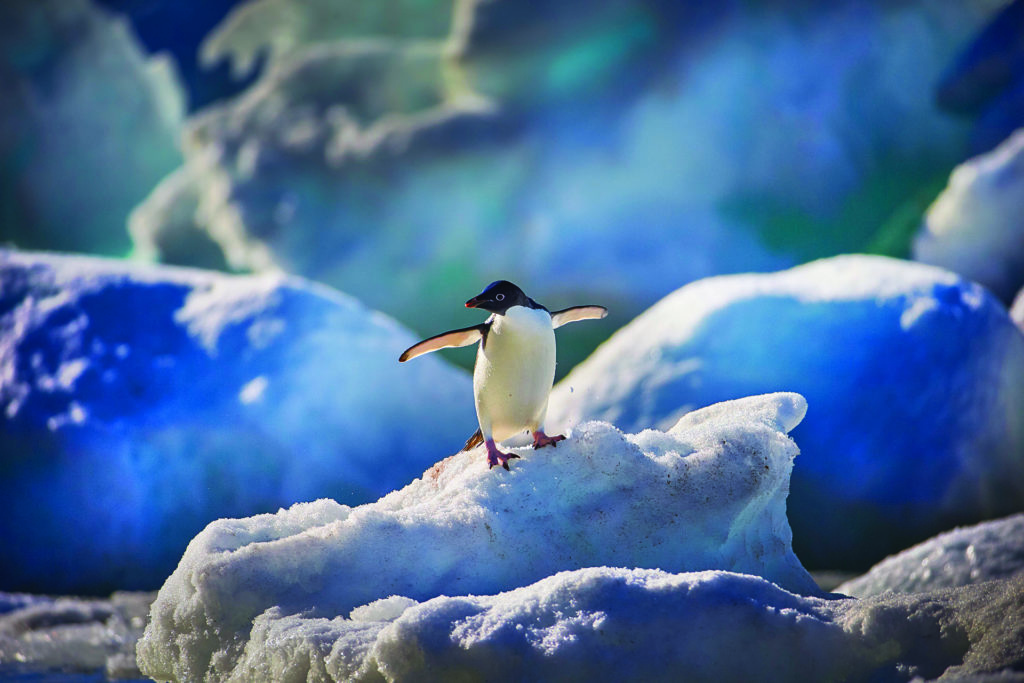
Across the Antarctic Circle
Venturing below the Antarctic Circle is about more than just earning bragging rights. It is the chance to enter a different world, rarely seen, it feels more isolated and colder than further north, with great swathes of pack ice and dreamlike icebergs.
Thread through pack ice and narrow channels where scenes of ice-clad mountains, feeding whales and lively penguin colonies become lasting memories.
February & March
Quick guide: These are prime whale-watching months, offer stunning sunrises and sunsets, plus surprising bursts of colour across the White Continent.
February can be an excellent time for an Antarctica cruise, particularly if you love wildlife-watching. The breeding frenzy has eased, adult penguins have finished moulting, and it’s time for many offspring to test their freshly waterproofed plumage.
The young penguins born earlier in the summer move through a speedy adolescence, prepping for their own turn to experience life at sea. You’ll want to have your camera charged and ready for a ton of pictures as the daring adolescents take their first tentative steps into the water. You’ll feel like it’s one of your own young, bursting with pride as they start to swim.
February and March are the best months to see whales in Antarctica, as they enjoy a buffet feast on the abundant krill. Watch for leopard seals resting on the ice near penguin colonies.
Like autumn in many destinations, fall brings bursts of colour with vibrant splashes of pink and green dotting the ice. This snow algae looks as pretty as toppings on an ice cream, however, this ‘watermelon snow’ has a laxative effect so avoid the temptation to taste it!
Like the start of the season, March’s shorter days, fading light, and spectacular sunrises and sunsets leave photographers (and passengers) breathless. Returning floating sea ice amplifies that winter-is-coming feeling.
Consider the February departures on our Antarctic Explorer if you’d love to spend your days witnessing these joys! For a March trip, Wild Antarctica is an epic fly-sail adventure.
Discover why Naturalist and Expedition Leader Dr. Roger Kirkwood prefers Antarctic trips in March .
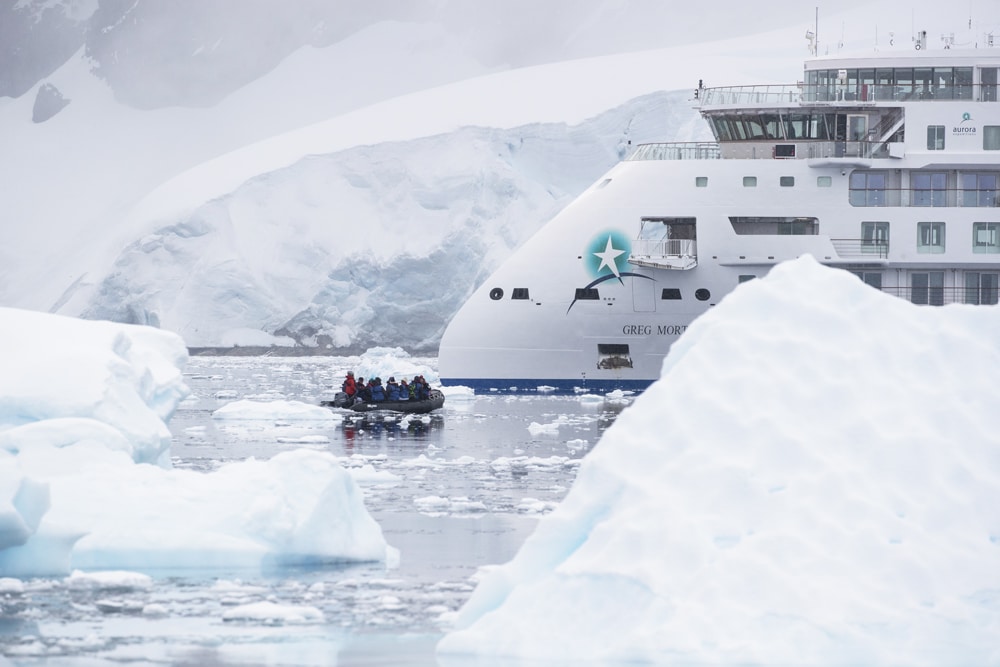
Antarctic Explorer
Early Antarctic explorers returned from their voyages to the deep south with tales of a magnificent, ice-covered land teeming with life. Experience the awe-inspiring immensity of Antarctica, reducing your time on the high seas by flying across the Drake Passage in one direction.
Immerse yourself in the unimaginable beauty of the Antarctic Peninsula, where vast glaciers tumble into the sea, penguins are dwarfed by soaring peaks and humpback and minke whales feast on abundant krill.
What to pack for an Antarctica expedition
Now you know the best time to visit Antarctica, you’ll need to know what to pack for your expedition . Luckily, as experts for over 33 years, we have everything you need to know to ensure you experience the white continent in comfort.
The most important thing to know? Pack layers! You can check out our layering guide here , but the key takeaway is to wear several light layers and one heavy one to insulate your body effectively.
So, what is Antarctica’s weather like from October to March? Chilly is a very generous word to describe either end of the season, with lows around –5.5°C (22°F). In December and January, temperatures are around 1°C (34°F) – positively balmy! You can see why those layers are a good idea, right?
Essentials in your luggage include waterproof trousers, a polar fleece jacket and thermal undies. Wool mittens, gloves and headgear will keep your extremities nice and toasty.
Closed-in shoes while onboard will ensure you can safely and comfortably navigate our purpose-built expedition ships . We’ll lend you a pair of muck boots to wear on shore excursions, so you don’t need to pack bulky footwear for the frigid temps.
Every Aurora Expeditions passenger also receives a complimentary polar expedition jacket. This custom-designed 3-in-1 jacket will be your new best friend, trust us.
Travel tips & safety
For polar explorers during the Golden Age of Antarctic Exploration , Antarctica was not considered a safe destination. Sir Douglas Mawson would attest to this after he lost members of his party and dogs to a deadly crevasse fall. When you’re travelling with the expedition experts, however, you’re protected from the temperamental elements.
Unlike Mawson aboard a 19th-century wooden vessel, you’ll be aboard one of our two modern purpose-built ships – the Greg Mortimer and the Sylvia Earle . Their design ensures safety and comfort as we navigate nature’s most intense conditions.
You’ll also enjoy our small-ship capacity (maximum 132 per departure) and robust Expedition-Team-to-guest ratio. While not a safety feature of the ship, consider our 100% climate-neutral status as a safety feature for the planet.
If you come prepared for your Antarctica trip and always follow the Expedition Team’s instructions, you will be safer than in many other destinations in the world. In fact, the only real problem you may face on Antarctica sailings is the unpredictable elements. This typically affects those who suffer from motion sickness, so it pays to bring medication, sea bands and ginger sweets. Of course, we have medical staff on every sailing to assist when needed.
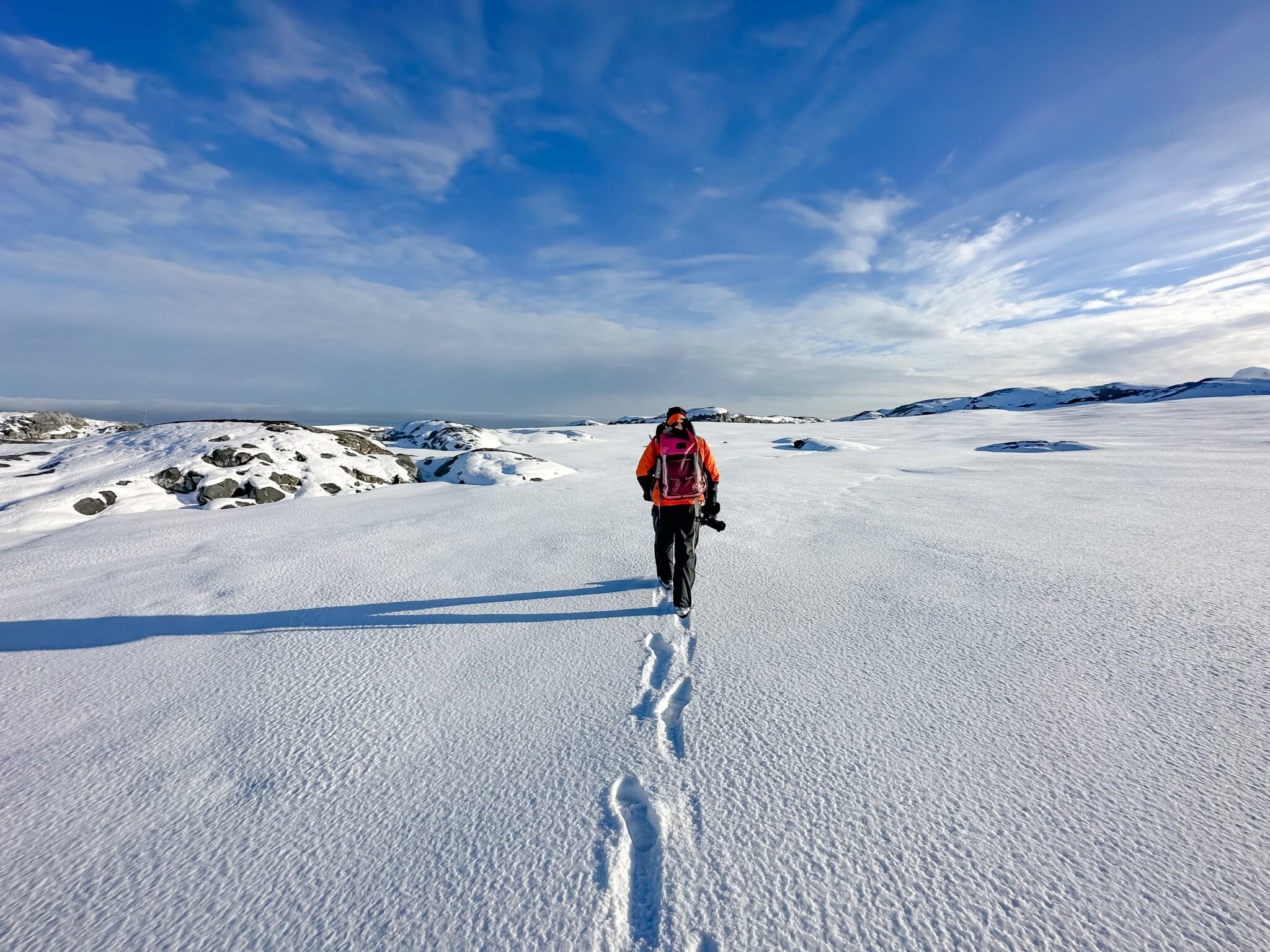
Choosing your ideal departure
It’s time for the fun part! Do you prefer the sound of witnessing Antarctica’s untouched wilderness at the start of the season, watching the continent come alive with new life, or the colour explosion that occurs towards the end of the season?
Whatever you decide, now you know the best time of year to visit Antarctica, you can find a departure to ensure you tick off those Antarctica bucket list items!
With over 25 annual departures – including fly/sail options – you can be assured there’s a sailing and cabin with your name on it. Call our knowledgeable team to book your spot or for help answering any questions you have about travelling with us, including how to get to Antarctica . Check out some featured expeditions below or download or order our latest brochure to view the full range of Antarctica itineraries.
Antarctic Peninsula in Depth
Welcome to Aurora Expeditions’ Antarctic Peninsula In Depth expedition. The ultimate expedition to the Antarctic Peninsula that seeks to include visits to some well-known locations and opportunities for surprise discoveries. Enjoy...
From USD $ 13,676.00 /pp
Wild Antarctica featuring the Weddell Sea
Welcome to Aurora Expeditions’ Wild Antarctica featuring the Weddell Sea expedition. Famed for its enormous icebergs, year-round sea ice, fascinating fossils and the pivotal role it played in Shackleton’s Endurance expedition,...
From USD $ 11,676.00 /pp
South Georgia & Antarctic Odyssey
Welcome to our South Georgia & Antarctic Odyssey expedition.This voyage encompasses the best of the Antarctic Peninsula and South Georgia. Discover historic Stanley in the Falklands~Malvinas and stand in awe...
From USD $ 21,516.00 /pp
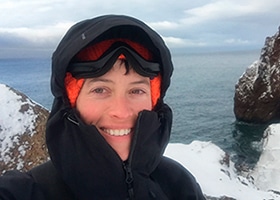
Written with assistance from Nina Gallo , Aurora Expeditions’ historian and certified PTGA polar guide.
Nina has been drawn to the polar regions since her first otherworldly experience of the midnight sun in 2002. She has spent time in far northern Canada, the Himalayas, the Alps and deserts in America and Australia, always seeking out quiet, wild corners to explore.
Nina feels immensely privileged to travel to these places and shares her passions for the natural world, human stories and adventure with all the wonderful people she meets. Nina is the author of Antarctica, published by Australian Geographic in September 2020.
You may also like
Late season antarctica: why i like antarctic trips in march.
It’s fantastic – you have the real Antarctica, and you have it all to yourself. Dr. Roger Kirkwood March is …
How cold is Antarctica?
Antarctica is the coldest place on earth. Colder than the Arctic and the Andes, even colder than the summit of …
Is Antarctica a desert? YES. Find out why
When most people imagine Antarctica they think of a cold continent covered in ice. And they’re right. In fact, 90% …
Do people live in Antarctica?
Antarctica is known for being the highest, driest, coldest and windiest continent on earth. So perhaps it won’t come as …
Request a customised quote
Privacy Overview

The Best Time to Visit Antarctica: Weather & Season Guide
By Author Arakita Rimbayana
Posted on Last updated: 6th October 2023
Antarctica is one of the least-visited places on Earth, but not for a lack of incredible experiences and truly striking landscapes. Its abundant wildlife, history of brave explorers, striated ice towers, and polar ice cap exceed every visitor’s imagination – and explain why it’s top of many travelers’ bucket lists.
Although there are many factors in determining the best time to visit Antarctica, ice and weather play a crucial part. Outside of Antarctica’s warmer months (October to March), ships cannot travel through the compacted sea ice.
The same applies to harsh weather conditions that may involve strong winds, blowing snow, whiteouts, and blizzards, even in summer.
Even during the Antarctic summer, ships can find themselves delayed because of inclement weather, which makes it incredibly hard to predict what you can expect to do and see on a cruise, anyway.
However, there are some general weather expectations, which I’ve dived into below.
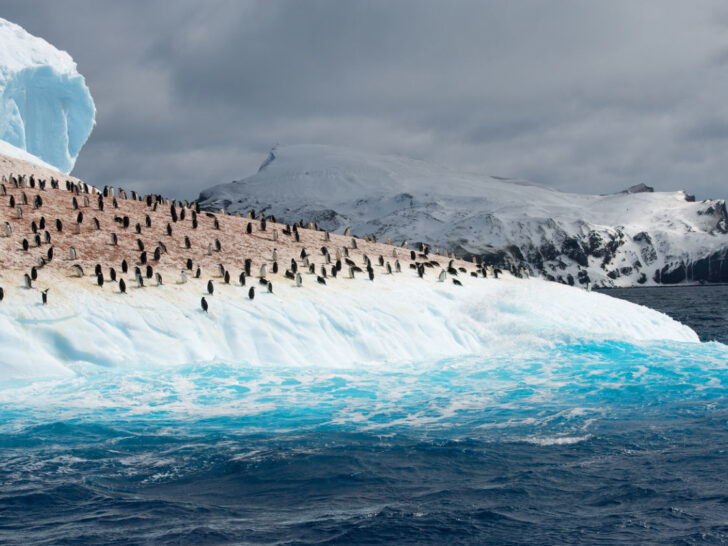
Click to navigate this article:
- January: One of the best places to spend the Antarctic summer is on the South Shetland Islands. This is when the islands buzz with activity: penguin chicks are learning to survive without their parents and winterovers (people who spend winter at the South Pole) are relishing the warmer days before the harsh season sets in.
- February: This is when you can catch sight of the humpbacks and orcas that have traveled to these waters, although the snow turns mushy and brown underfoot thanks to visitors and the guano of the breeding penguins.
- March: The tail end of the Antarctic season is marked by the whale-watching peak. You might even catch some fresh snow as the cold weather returns for the winter.
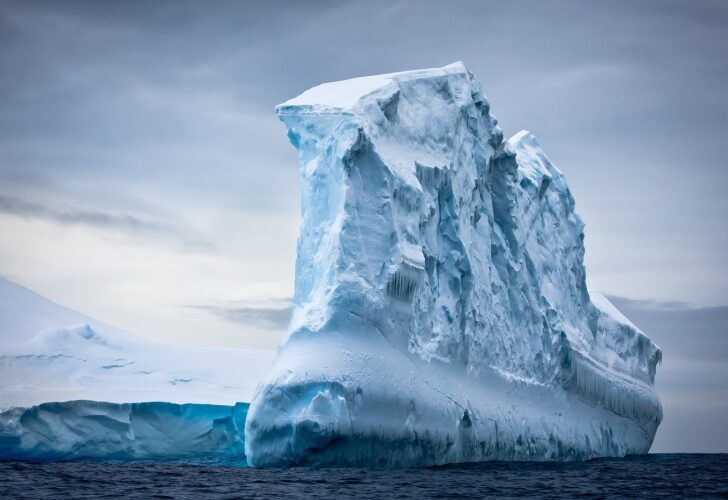
- April to September: Winter approaches and average temperatures are beginning to drop well below freezing, reaching -60°C (-76°F) or lower. The pack ice thickens, and all cruise ships depart. Antarctica is plunged into almost complete darkness; the sun comes close to the horizon but not above it, resulting in twilit days.
- October: Visiting in October, you’ll be among the first to arrive in Antarctica for the tourist season. Alternatively, visit the Falkland Islands to spot penguins before the breeding season begins.
- November: This month is ideal for observing adult penguins breeding and building nests – mostly on South Georgia Island – as the icebergs calve and sea ice breaks up.
- December: This is the beginning of peak season with the warmest temperatures, longest days, and most abundant wildlife. You’ll begin to see chicks hatching during the final weeks of December.
Planning Your Trip to Patagonia?
Save time, stress & money with a customized travel itinerary planned for you by a Patagonia expert
What previous clients have said:
I engaged Steph’s help during a very busy time in my life, as I was determined to travel without a tour, but had become overwhelmed trying to piece it all together. Steph absolutely nailed the brief. She understood exactly what we wanted to do, and made exceptional recommendations. Steph was also super quick to answer emails and find solutions when needed. I just feel so incredibly grateful to have read about Steph’s planning service, and our Chile bible….Moon Chile (Steph’s travel guidebook) was with us every step of the way.
The best weather conditions
What you need to know about visiting antarctica.
- Antarctica is a snow desert; it remains cold and dry throughout the year. The continent experiences only two seasons: winter and summer. During the winter months, temperatures are extremely low, with the temperature at the South Pole averaging -60°C (-76°F). As winter progresses, daylight hours decrease until the sun sets almost entirely for months. In contrast, summer months bring longer days and relatively warmer temperatures, although they tend to remain below freezing.
- Due to its extreme southern location (and the effects of climate change), even warmer weather can change rapidly . It can reach as high as 9°C (48°F) on the coast but drop to much colder temperatures the following day.
- The summer and winter of the Antarctic season occur at opposite times of year compared to the northern hemisphere. Therefore, don’t try and plan a trip during your summer vacation if you’re in the northern hemisphere – you won’t find any cruises running!
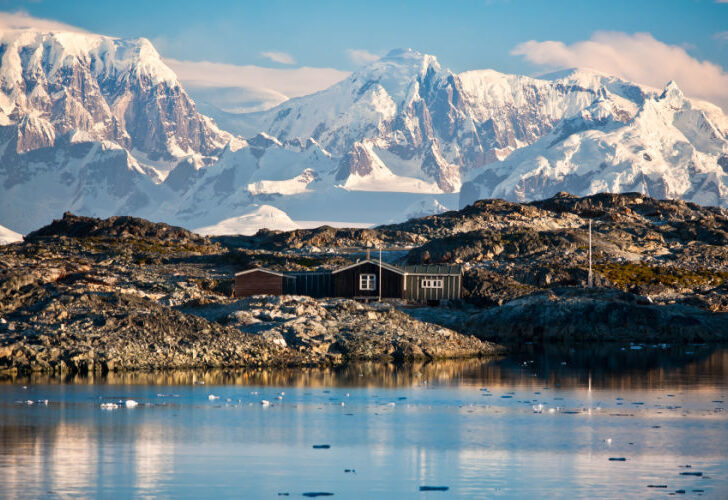
Beyond the sea ice thickness, weather conditions can make or break your trip to Antarctica. With temperatures regularly dropping to -34°C (-29°F) in the coastal regions and -60°C (-76°F) in the interior during the winter months, from late spring to the end of summer is the only reasonable time to visit.
The Antarctic coasts – where you will most likely visit – hover around 0°C (32°F) from October to March. Therefore, any time after the first full sunrise in August until late March should be a great time to visit.
With 24 hours of daylight and the arrival of penguin chicks, December is peak time for Antarctic cruises. If you don’t mind visiting during the peak season, this is the best month to visit, weather-wise.
The best time to visit different regions in and around Antarctica
Antarctic peninsula.
The peninsula is the most visited part of Antarctica, not only because it is the closest to South America, but also because of its unparalleled beauty.
Set sail for the peninsula during November – perhaps the best time to visit Antarctica – when the landscape is at its most dramatic and the wildlife emerges after the long winter.
Looking to head to the White Continent? I highly recommend the brilliant Swoop Antarctica. Their staff have extensive, first-hand experience of sailing to Antarctica and, because they sell cruises for all the well-known companies, they can give you handy, impartial advice for choosing the one that best suits you. What’s more, they specialize in small ship expedition cruises, which means you’ll be allowed to get off the boat at every stop on the itinerary (which is not the case for large ships!) and you won’t pay a cent more by booking through them rather than directly with the cruise company themselves. Ready to be inspired? Check out their classic cruises to the Antarctic Peninsula , or their more unusual trips to wildlife-rich South Georgia and the Falklands , or go further than most on a cruise to the Antarctic Circle .
Antarctic Circle
The Antarctic Circle’s relatively harsh conditions – and the effort involved in getting there – make it the least visited part of Antarctica. However, venturing to the most southerly place on Earth promises an unforgettable experience.
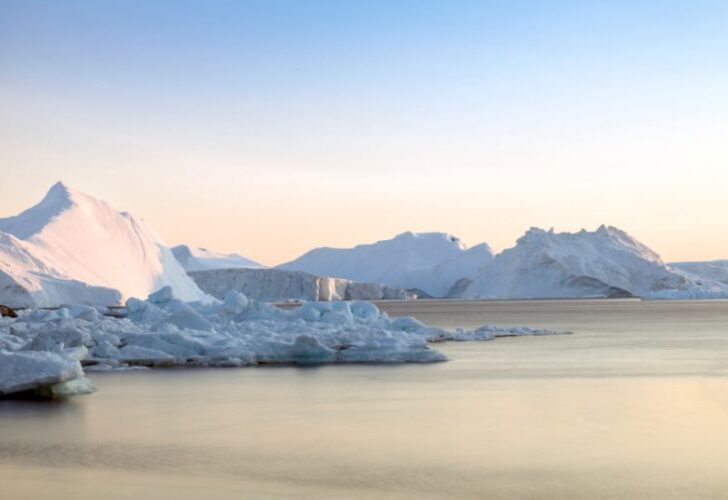
Though the wildlife in the Antarctic Circle may not be as abundant as in other regions, it plays a crucial role in maintaining ecosystem integrity. The area is home to unique, rare sponges that live for nearly half a millennium; it’s also the only region inhabited by the Antarctic toothfish.
Due to the unique conditions, it’s best to book with a specialist operator. Swoop Antarctica has extensive first-hand experience and offers a 6-day cruise to 66 degrees south – the edge of the Antarctic Circle – aboard a comfortable and spacious vessel.
South Shetland Islands
Ships bound for Antarctica often stop in the South Shetland Islands to give their passengers a taste of the White Continent, or to take a break from a turbulent journey across the Drake Passage. One of the most popular landing sites is the Arctowski Station on King George Island.
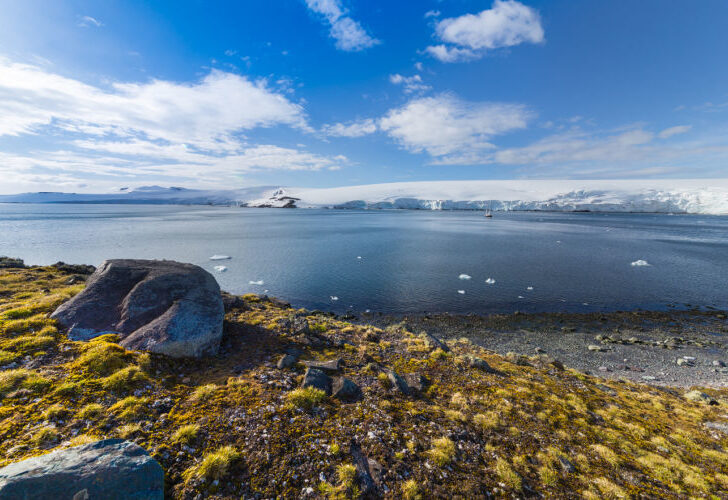
As they’re just north of the Antarctic Peninsula, the best time to visit the South Shetland Islands is typically the same as the best time to explore the main continent. However, if you’re only planning to visit this archipelago and not venture further into Antarctica, January is an excellent time to visit, as it’s when wildlife is most active.
South Georgia Island
South Georgia Island is home to numerous penguin colonies; you’ll spy thousands of these magnificent creatures throughout the summer months. The spectacle is particularly captivating in December when chicks begin to hatch. Like most parts of Antarctica and its surrounding islands, it’s best to visit during the Southern Hemisphere’s summer months. If you want to avoid the December peak season, consider November as an alternative. You’ll still have the opportunity to observe penguins breeding and nest-building on the islands.
Falkland Islands
The Falkland Islands often feature in Antarctic cruises departing from South America and are home to millions of animals and only thousands of humans. Among its most arresting sights are the penguin colonies atop cliffs that descend to pristine beaches.
Five species call the archipelago home but you’ll likely encounter the Gentoo most often, as the Falklands have the largest population of Gentoo penguins on Earth.
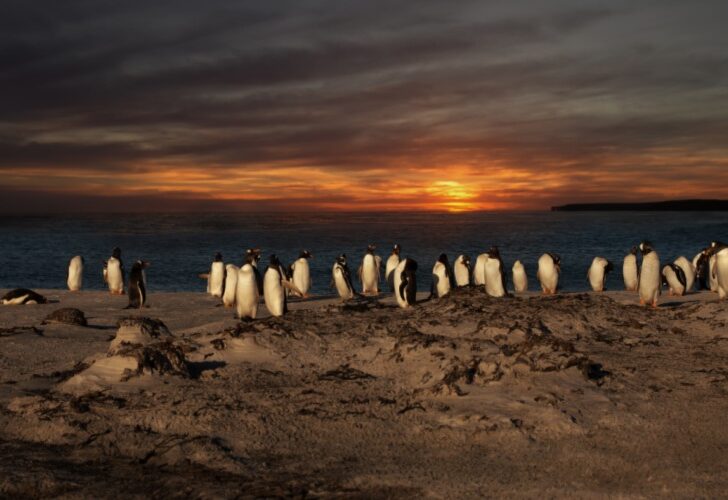
Typically, I would recommend visiting during the breeding season – which starts in November – to see the greatest number of penguins. However, given that millions of them inhabit an area of just 4,700 sq mi (12,000 km2), there’s still a good chance of spotting them earlier.
For this reason, I suggest visiting in October to avoid the crowds and to fully enjoy the time leading up to your arrival in Antarctica.
Although wildlife is undoubtedly the main attraction, there are also interesting sights and activities inland. Pay a visit to the Dockyard Museum or take a stroll around Whalebone Arch Square to see the impressive arch made from real blue whale jawbones.
So, when is the best time to visit Antarctica?
To see penguins hatching.
According to the Australian Antarctic Program , there are at least nine species of penguin in the Antarctica region (out of only 17 discovered worldwide); the most common are King penguins, Adélie penguins, and Emperor penguins. The latter is the only one breeding during the Antarctic winter when the continent is closed to visitors.
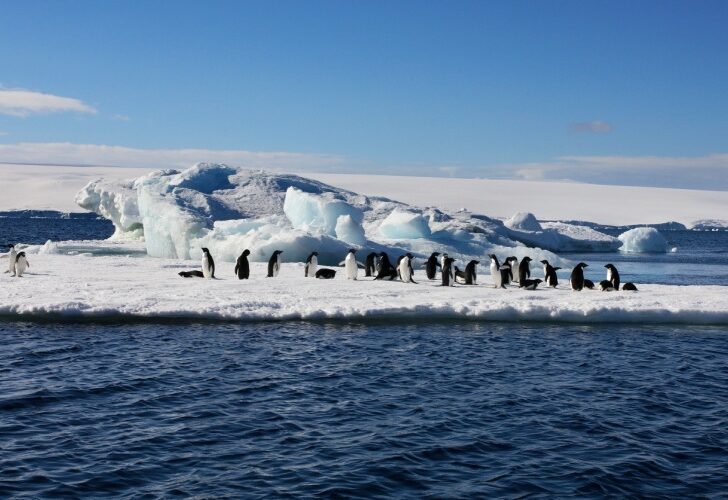
King penguins have a long breeding cycle: they lay eggs from November to April. As long as you visit within this time window, there’s a good chance you’ll see not only eggs hatching but also the parents incubating them on their feet (unlike most penguins, which build nests).
Adélie penguin chicks, like most penguins in Antarctica, begin to hatch in mid-to-late December. They stay with the adults for another month until they are large enough to be left alone. When their adult feathers fully grow in February, they can feed themselves.
As thousands swim into the ocean to hunt fish and krill, they attract other, larger animals, such as humpback and minke whales.
To see whales
Although the peak of the whale-watching season falls in March, February is actually the best month to catch sight of the humpback whales and orcas that have traveled to these waters to feed. However, the snow will have turned mushy and brown underfoot due to visitors and the guano of the breeding penguins.
Most tours to Antarctica include whale-watching activities. Swoop Antarctica expeditions offer several options: watching from a ship on the open sea; from a guided Zodiac inflatable boat tour that gets you closer; or even from a kayak, watching their movements in complete silence.
To see seal pups
Spotting adult seals can be a challenge, let alone seal pups. Seals live most of their lives underwater, only coming up to breed on the sea ice. In addition, some species – such as Ross and Leopard seals – tend to be solitary.
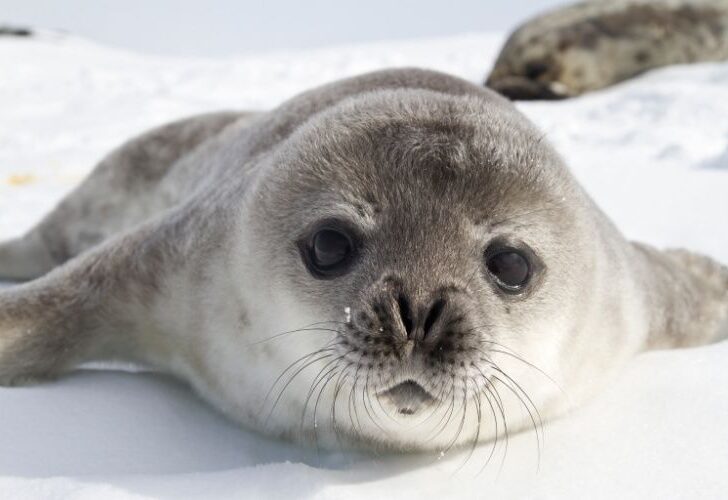
The longest time span seals spend above water is raising the pups, which is when you can spot them basking in the sun. You’ll see young fur seals, elephant seals, and most other species on sub-Antarctic islands (mostly on South Georgia); you’re more likely to spot crabeater and leopard seals on large pack ice in the Antarctic waters.
Most species give birth from September to December. Although the adults are usually nonchalant (though sometimes curious) around humans, the seal pups can be shy and hide from visitors, so it’s best to schedule your trip in October to see the pups before the crowds swarm in. However, significantly fewer ships sail to Antarctica in October.
To avoid the crowds and see unblemished landscapes
The early summer season (October to November) has excellent snow and ice conditions. It is the best time to visit as landscapes remain pristine – there have been no tourists to churn up the snow yet. Moreover, you may witness the spectacular sights of icebergs calving and sea ice breaking up.
Mid-November is also the mating season for Adélie penguins; you may see them building their nests. Although the whales aren’t as easy to spot during these months, you can see seals and their pups on South Georgia Island.
Looking for further inspiration for your trip to Antarctica? Read our guide to the best books about Antarctica and look at our Patagonia itineraries to plan your adventures before heading down to the White Continent.
- Search Please fill out this field.
- Manage Your Subscription
- Give a Gift Subscription
- Sweepstakes
- Travel Tips
How to Visit Antarctica
From how to get there to what to pack, here's what you need to know about visiting Antarctica.
Meena Thiruvengadam is a lifelong traveler and veteran journalist who has visited more than 50 countries across six continents. Her writing has appeared in The Wall Street Journal , Departures , TripSavvy , and other publications.
:max_bytes(150000):strip_icc():format(webp)/Meena-Thiruvengadam-0953f29450f840a786278802ac6a8162.jpeg)
There is at least one place left on earth where you really can disconnect: Antarctica.
There is no mobile phone service. There are no town squares, no restaurants, and no tourist traps. The local "airports" are really just ice or gravel landing strips.
Antarctica is nearly twice the size of Australia and mostly covered with a thick sheet of ice. It's one of the most remote destinations in the world and the trip of a lifetime for many travelers. It's also easier to travel to Antarctica than one might think.
Lars-Eric Lindblad first took a group of 57 visitors to Antarctica in 1966. "At that time it was more or less like accomplishing a moon landing," his son Sven-Olof Lindblad said. "In those days, we were not as prepared as we are now. There were no satellite ice charts. You were not that different navigationally from the early explorers."
Even now it can be hard to really understand Antarctica. It is the coldest and windiest place on earth and, by some measures, the driest. It has no currency of its own. It is a desert with no trees, no bushes, and no permanent residents. More meteorites are found in Antarctica than in any other place in the world.
"Antarctica is about the wildest place you can go on the planet," Lindblad said.
It's also an increasingly popular place to visit. According to the International Association of Antarctica Tour Operators , tourism more than doubled from 2010 to 2020.
"The conversation around climate change has elevated people's interest and created a sense of urgency," Lindblad said.
The Best Times to Go to Antarctica
The Antarctic travel season lasts from November through March, the Antarctic summer. Temperatures are often below freezing at this time of year, especially in the continent's interior, but they can reach as high as 50 degrees Fahrenheit.
The best time for penguin spotting is late December or early January. Wait too long and previously pristine penguin colonies get dirty and smelly, said Nik Horncastle , a regional specialist with Audley Travel. For peak whale watching, try February or March.
Other activities, including snowshoeing, kayaking, skiing, camping, snorkeling, diving, and visits to historic sites from earlier expeditions, can be experienced throughout the season.
How to Get to Antarctica
One of the more common routes to Antarctica is by ship via Ushuaia, a city at the southern tip of Argentina. Several companies, including Hurtigruten Expeditions , Quark Expeditions , and Lindblad's namesake Lindblad Expeditions , specialize in Antarctic and polar cruising, offering journeys that range in length from just over a week to a full month and beyond.
On board, expect to mingle with scientists, naturalists, historians, and underwater specialists. "The onboard experience is a conversation around where you are and what does this place mean," Lindblad said. Internet service via satellite is available but comes with a hefty price tag.
Antarctica is one place where smaller boats offer a big advantage. "We don't recommend a boat over 200 people," Horncastle said. "Big boats can only stop at a few sites."
That said, if you want to visit Antarctica on a traditional cruise line, many major carriers can get you there — often on vessels that adhere to that fewer-than-200-guests rule of thumb. Some more affordable lines, like Norwegian and Royal Caribbean , stick to "cruise-only" itineraries, which sail along the Antarctic coast (and offer great views in the process) but don't allow disembarkation on the continent. A number of others, though, from Viking Cruises and Disney Cruise Line to Ponant and Silversea , take passengers right into the Antarctic interior, thanks to on-shore excursions and ships with icebreaker capabilities.
Booking an Antarctica Expedition
Expect to spend between $6,000 and $50,000 to visit Antarctica, depending on the length of the trip and the level of luxury you seek.
"It's an expensive trip," Horncastle said — but there are options if you're traveling on a budget.
Intrepid Travel and G Adventures both specialize in affordable trips to Antarctica, and neither requires single supplements for solo travelers. If you don't feel the need to set foot on the continent, you can also opt for a sightseeing flight. These flights, which cut costs by flying over Antarctica without stopping there, are available from most major cities in Australia at prices that start around $1,200 per person.
To both fly over and step onto the continent, Antarctica21 combines a two-hour flight from Chile with cruises that passengers can board in Antarctica. While this option doesn't give visitors the chance to cruise the famous Drake Passage, it does save time and minimize the risk of seasickness.
"The Drake Passage is a crossing full of unpredictable conditions," said Antarctica21's Francesco Contini. "When the crossing is rough, passengers tend to be not very comfortable."
Packing List for Antarctica
- Knee-high waterproof boots
- Waterproof pants
- A warm parka
- Waterproof gloves
- Warm base layers
- Extra socks
- A tight-fitting beanie
- A warm scarf
- A camera and lenses
- Seasickness medication
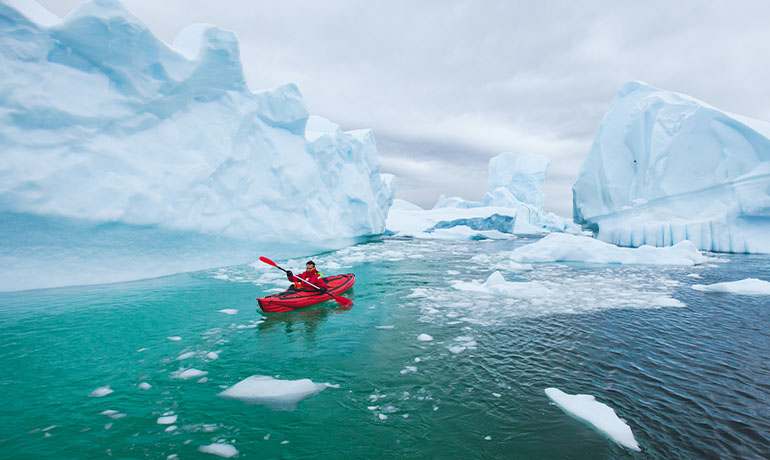
The Best Time To Visit Antarctica: Travel Guide | Marchay
Ready for the trip of a lifetime? Antarctica is one of the last places on Earth yet to be explored by humans, and you now have a chance to make landfall on this frozen frontier. With around 50,000 tourists every year, Antarctica is becoming more accessible for tourists excited to embark on the ultimate adventure.
The untouched frozen landscapes prove that nature reigns over all — giant glaciers reaching heights of 50+ stories and beyond, ice sheets covering areas larger than metropolises like Los Angeles, and an abundance of wildlife that live in harmony with the uninhabitable polar regions.
This travel guide provides insight into how you can add the coveted Antarctica stamp to your passport and when you can start planning your journey into the Arctic.
Table of Contents
When Is The Best Time To Visit Antarctica?
Antarctica is often the trip of a lifetime for our Marchay members interested in exploring one of the most remote, untouched regions of the world. So, while it’s still largely uninhabited and with many surprises awaiting you, when is the best time to visit?
The best time to visit Antarctica is during the summer. The season, locally known as the Austral summer, lasts six months, from October to March. It gives a large window for traveling to the continent. There are many things to expect during these months, and you may have preferences based on which month to visit.
Travelers interested in seeing the most dramatic landscapes in Antarctica should consider visiting at the beginning of summer in October and November. The equally-long winter comes to a close, revealing nature’s magical work over the six months of darkness and uninterrupted activity.
Sightseeing wildlife is best done in December and January. This is the peak season when the wildlife is most active with their mating and breeding seasons to see the unique courtship rituals. There is also a bit of history found on the Antarctic coasts, left behind by whalers. These sites are excellent to visit during the late summer when the weather is warmer for outdoor exploration.
When Is The Worst Time To Visit Antarctica?
Lucky for you, the worst time to go on an Antarctica trip is also when it’s inaccessible for tourism. The Antarctica winter lasts six months and has harsh, unexpected weather conditions that prevent any tourist activity on the continent.
Antarctica winters last from April to September. These are the darkest, coldest months in Antarctica, but also are the period largely responsible for its natural beauty. During the winter, the only people in Antarctica are there for research, so you won’t have to worry about missing a thing!
The Antarctica winters are extremely cold, with average temperatures far below the freezing level. It’s when the South Pole faces the opposite direction of the sun, so it has 24-hours of darkness until the sun rises again in October.
In addition to the weather being unfavorable in the winter, getting to Antarctica is also highly unlikely. The winds cause rough water conditions too unsafe for tour providers to cruise the Drake Passage en route to Antarctica. There are also large ice sheets frozen on the water surface that make it nearly impossible to navigate the waterways.
Winter isn’t a time when you would want to visit Antarctica and is a time when even many wildlife species tend to avoid spending time on the continent.
Visiting Antarctica In The Spring
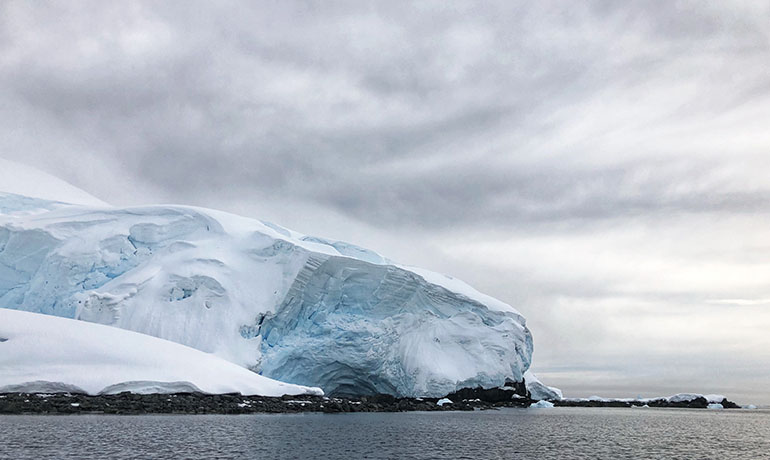
The Spring months of October and November kick off the cruise season in Antarctica! With the sea waters calming and the weather becoming more favorable, this season is when visitors can finally begin returning to the white wilderness. For the continent of Antarctica, springtime is considered the beginning of the summer.
Visiting Antarctica during the Spring lets you experience the continent’s most pristine conditions. Finally, after months of human inactivity and extreme weather conditions, you’ll arrive at a setting of dramatic landscapes. Frozen white glaciers tower at their highest, the frozen desert still has a fresh layer of snow, and the sea ice that Antarctica cruise ships cut through upon arrival.
Average weather during the spring ranges from freezing temperatures of 32 ºF to a mild 50ºF. Also, it’s the first time in months when many places on the continent receive sunlight after a 24-hour nighttime sky in the winter.
Not only do tourists return to Antarctica, but wildlife also migrates back to the continent. various types of seals, including fur seals and leopard seals begin their mating seasons. In addition, tons of seabirds, like the albatross, can be seen soaring overhead, and you’ll begin to see whales returning to the arctic waters to feed on the abundance of krill.
Visiting Antarctica In The Summer
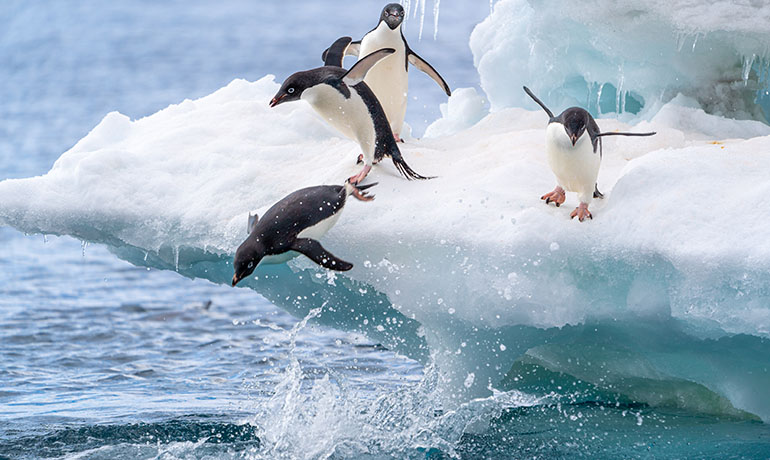
The summer season in Antarctica is the most popular time to visit the continent. For the southern hemisphere, the summer months are January to March, although, in Antarctica, the summer is defined as October to March. Visiting this frozen tundra will give new meaning to summer vacation, but it will undoubtedly be an unforgettable experience.
Did you know that Antarctica gets 24 hours of daylight during the summer? Known as ‘Antarctic Day,’ this time of year is when the region below the polar circle directly faces the sun. The sunrise takes two months to finally reach its peak for the season. However, the heat from the sun helps melt the ice formed over the winter and makes the coastal regions of the continent easier to navigate for ships.
The Antarctica summer has average temperatures in the low 40s. The warmest month to visit Antarctica is in January. The relatively warm conditions make it ideal for visitors to spend time exploring the arctic landscape and sightseeing the local wildlife.
Wildlife is most active during the summer. With the mating season over, the coasts are lined with penguins and their chicks hatching alongside elephant seals and their seal pups. You can see phenomena like mothers nursing the young or waddling towards the coast for their first swim. The summer season is also when you’ll see an abundance of whale pods.
Visiting Antarctica In The Fall
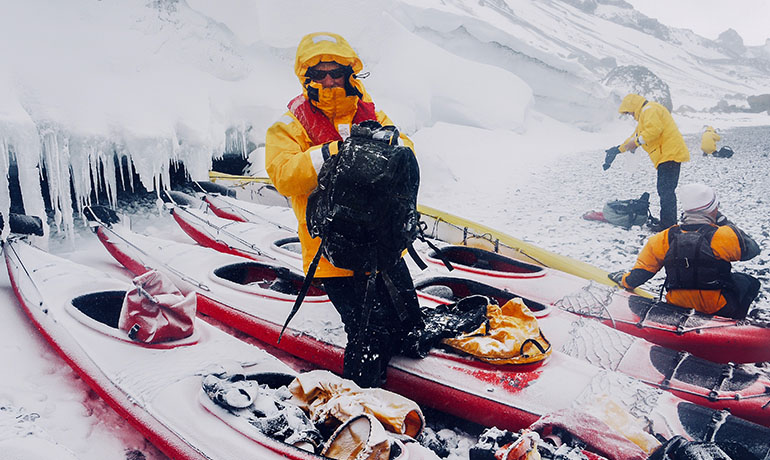
The fall months in the southern hemisphere between April and June are the start of Antarctica’s six-month-long winter season. Unfortunately, visiting Antarctica during these months is not possible due to the temperatures and water conditions.
The popular Drake Passage route when traveling to Antarctica has unpleasant waters during the fall. The rough waters make it unsafe for visitors traveling to Antarctica. But the water conditions aren’t the only thing that makes fall travel to Antarctica unlikely.
Fall enters the ‘Midnight Sun’ period in Antarctica. Most of the continent experiences 24-hours of nighttime after the final sunsets in March and doesn’t reappear until October. With the dark skies comes freezing temperatures that can average between 5°F to -22°F.
A select few still inhabit Antarctica during this time of year. It has a population of approximately 10,000 people, namely scientists and researchers studying the vastly unexplored continent.
Visiting Antarctica In The Winter
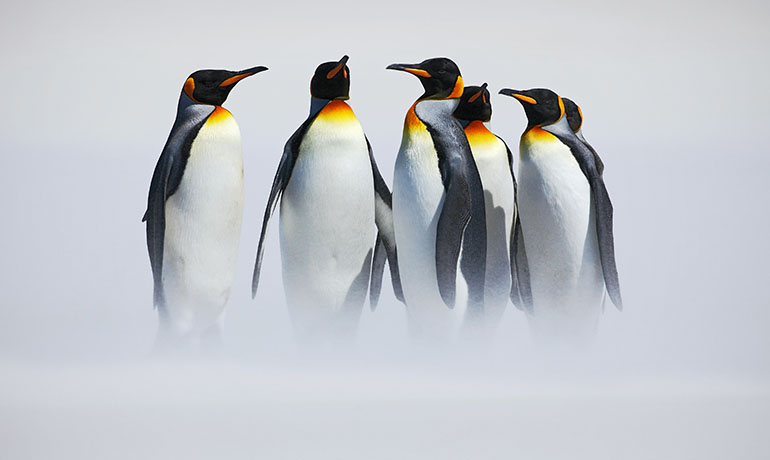
Wintertime is what most people imagine when thinking about Antarctica. But, unfortunately, travel is not available to the continent during this season — and it’s when you’ll least want to visit. Winter in the southern hemisphere occurs from July to September. However, the Antarctica winter is more extensive, starting at the end of March.
The ‘Midnight Sun’ lasts the entire six-month winter. It gives plenty of time for the landscape to freeze over, and there are also exaggerated winds blowing across the continent. As a result, the weather conditions are harsh, even for wildlife that leaves the continent to warmer waters and temperatures north of the arctic.
As unpleasant as the weather can be during the Antarctica winter, it’s a necessary season to preserve the unique landscape. It prevents significant human activity, other than adventurous researchers stationed on the continent, from interrupting the continued work of nature to create the beautiful, untouched landscape for us to enjoy when the Antarctica summer finally arrives.
Join Marchay
For travelers who want a bespoke, personalized travel experience, get in touch with an experienced Marchay Travel Advisor to guide and plan all your traveling needs.
Attractions & Things To Do In Antarctica
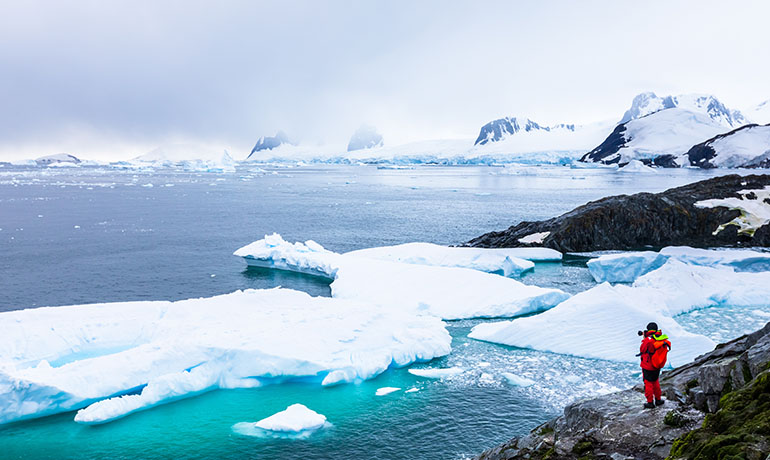
#1. Lounge With Penguins
Penguins thrive in cold climates, making Antarctica the perfect location to see them in their natural habitats. You’ll encounter five penguin species, including the King Penguin, Emperor Penguin, Rockhopper, and Adélie Penguins, which can be seen playing, mating, and leaping onto the Antarctica coast. If you’re lucky, baby penguins will approach you and pose for photos.
#2. Take A “Polar Plunge”
Stepping foot onto the Antarctica continent is a bucket list item for many people, while others want a more immersive experience like jumping into the water. Antarctica expedition cruises plan a ‘Polar Plunge’ to truly get a sense of the frigid water temperatures.
#3. Visit Deception Island
Explore Antarctica’s historical heritage by visiting Deception Island. This island has many remnants of its past as a whaling station used during the late 1960s. Go snowshoeing across the pack ice to see what was left behind.
#4. Kayak Through The Antarctic Peninsula Waterways
Massive glaciers reveal the true scale of the artic wonders in Antarctica as seen as you explore the Antarctic Peninsula Waterways via kayak. Bundle up as you navigate the icy waters where you might get a chance to see whales breaching the surface nearby.
#5. Photograph Icebergs
Even with most of their mass below the water surface, icebergs in Antarctica still tower 100+ feet above you. Seeing these giant ice blocks is surreal as you try to capture their awe-striking appearance on camera.
#6. Mail A Letter From Port Lockroy Post Office
Need proof that you’ve visited Antarctica? The Port Lockroy Post Office will gladly send your postcard to friends and family, which includes a unique stamp. In addition, the local penguins outside always make great photos to include with your mail.
#7. Cross The Infamous Drake Passage
The Pacific and Atlantic Oceans meet at the Drake Passage. Board your Antarctic cruise ship in Ushuaia, Argentina, and set off across the passage to reach one of the closest Antarctica landing sites. The Antarctica summer season is the best time to navigate the deep waters that are much more calm and manageable for tourist travel.
#8. Sail Through The Lemaire Channel
Towering glaciers rise on either side of you as you cruise through the narrow Lemaire channel. Many Antarctica excursions sail this popular route, where you’ll see glacial landmarks like the famous ‘Twin Towers.’
#9. Go Whale Spotting
Antarctica is a playground for the world’s largest mammals. Blue whales, minke whales, orcas, and humpback whales are a few common sightings while whale watching the Antarctic waters.
#10. Visit An Arctic Research Station
Antarctica is a frozen frontier full of mysteries waiting to be explored. The continent’s residents are a mix of scientists, biologists, ecologists, and other personnel helping document the arctic wonders. You’ll get a chance to peek into the operations with tour stops at local arctic stations.
#11. Visit “Blood Falls”
Antarctica blood falls. Unique red waterfall. Flowing from Taylor Glacier. Sightseeing in Antarctica includes stops at unusual landmarks like the “Blood Falls.” Iron minerals in the waters flowing from Taylor Glacier resemble blood falling five stories into the frozen West Lake Bonney.
#12. Explore The Coast In A Zodiac Boat
Large cruise ships do most of the heavy lifting to cross the rough waters of the Drake Passage to reach Antarctica. However, the inflatable Zodiac boats will finish the job to take you to the shore, where you’ll get the experience of a lifetime by stepping foot onto the ice-covered continent.
#13. Warm-Up In A Thermal Pool
Antarctica seems like the last place where you’d find an active volcano, but Deception Island once again surprises those who visit it. If the outdoor temperatures are warm enough, tourists are invited to go for a dip in the island’s thermal pools heated by Mount Erebus sitting below the surface.
The Bottom Line
While many destinations around the world experience peak travel seasons or even overtourism, tourism in Antarctica is still in its early stages. Set off on a journey to one of the most unique places on Earth and experience the beauty that nature can create when undisturbed.
There is only a six-month window to enjoy the ideal Antarctica Summer, where you’ll be immersed in the continent’s nature and wildlife. Our Marchay members have access to excursions that are both adventurous, educational, and full of surprises that you can only experience in Antarctica.
Find out more about how you can take this life-fulfilling journey to Earth’s last frontier.
Frequently Asked Questions
What is the warmest month in antarctica.
Did you know that Antarctica doesn’t always have temperatures below freezing level? This comes as a surprise to travelers while planning a trip to Antarctica because of its location. Most of Antarctica lies below the Antarctic Circle, giving it a unique climate throughout the year.
The Antarctica Summer happens from October to March. This six-month season is when the South Pole continuously faces the sun, giving it a 24-hour daylight phenomenon. The constant sunlight warms up the frozen continent and melts the ice.
The warmest month in Antarctica occurs in January, in the middle of the summer, and one of the best months to visit. It’s when the sun has had time to deliver heat and sunlight to the once frozen continent. Temperatures in January can reach upwards of 50ºF (10ºF). With these temperatures, you can stand outdoors without a jacket and even see Antarctica wildflowers growing.
When is the best time to see penguins?
Witnessing the abundance of wildlife is one of the most exciting parts of visiting Antarctica. One of the most endearing residents of the continent is penguins. Large penguin rookeries can be found on the Antarctica mainland, the South Shetland Islands, swimming in the Weddell Sea, on the coastal reserve of the Ross Sea, and in other locations.
Antarctica is home to five species of penguins since it provides the optimal environment for them to live in. The best time to see penguins is during the Antarctic Summer. They are present all season but are active in different ways each month.
At the start of the summer, in late October and November, penguins are active during their mating season. By the end of the season, you can see penguin chicks waddling across the ice sheets and diving into the water.
Tourists are advised to keep their distance from the penguin colonies to not disturb their natural state. However, you might get lucky and be approached by the penguins, who are always happy to welcome visitors.
Marchay Member Travel
15+ nights in 5* hotel
Private, First or Business Class fights
Minimum $25,000 travel spend /year
One large vacation /year
Loves travel and discovery
- € EUR
When is the Best Time to Visit Antarctica?

Published on: July 25th, 2017
Last modified: March 21st, 2024
The best time to visit Antarctica is between December and March, due to milder temperatures of around 0ºC (32ºF), and greater likelihood of spotting wildlife like penguins and whales. The first journeys of the year begin in November and, if you’re visiting the Falklands and South Georgia, can run until early April.
December and January see the longest days and February and March are best for whale spotting. Antarctica cruise activities such as kayaking, camping and even swimming are typically available across the entire summer season from December to March.
Monthly Climate Guide for Antarctica
Although Antarctica’s weather is characterised by cold and icy conditions, there are some distinct seasonal changes. Variable temperatures and wind speeds can dramatically alter the region, even making it inaccessible at certain times of year.
To help you understand the different seasons and choose the best time to travel to Antarctica , we’ve put together a climate guide highlighting what the weather is like across the year.
December to January
Antarctica Temperatures in December and January: 1°C (34°F)
December to January is considered Antarctica’s peak summer season. Although it’s still cold – particularly when the wind picks up – these are the warmest months. It can feel warmer or colder depending on sunshine and windchill.
At this time of year Antarctica also boasts nearly 24 hours of sunlight and the most active wildlife, with penguins, seabirds and even whales starting to make an appearance.
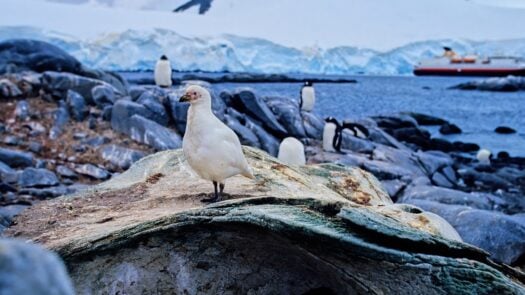
February to March
Antarctica Temperatures in February and March: −1°C (30°F)
The summer continues into February and March with similar weather conditions as December and January. It’s worth noting that Antarctica receives very little rain or snow – particularly at this time of year – and by March much of the snow on lower ground won’t appear as pristine as it did earlier in the season.
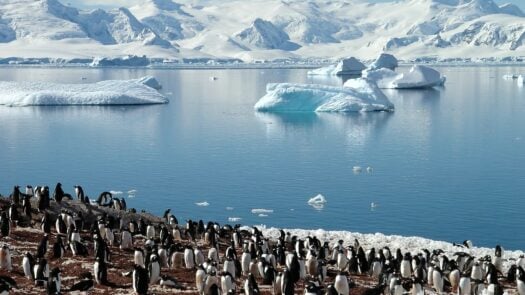
April to September
Antarctica Temperatures from April to September: −15 to −20°C (5 to −4°F)
Antarctica’s harsh winter stretches from April to September. The temperatures are freezing and inhospitable, and most of the day is dark. Storms are also common at this time of year, making it impossible to complete the journey to and from Antarctica.
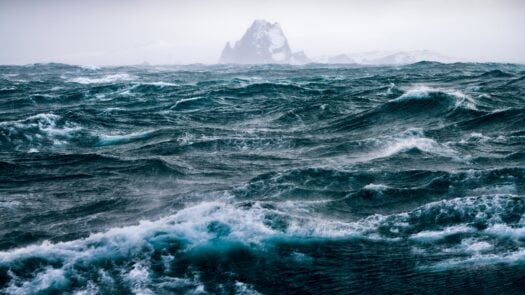
Antarctica Temperatures in October: −4°C (25°F)
October marks the end of the harshest winter conditions in nearby destinations like the Falkland Islands and South Georgia, so some cruises start to operate there. But cruises around the Antarctic Peninsula don’t usually start until November, due partly to remaining winter sea ice.
Although many ice-strengthened ships can make light work of these conditions, temperatures are still too cold to enjoy cruise activities such as sleepouts and kayaking.
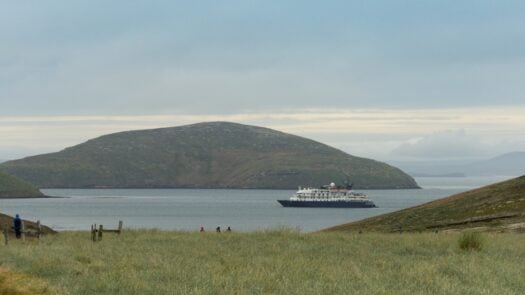
Antarctica Temperatures in November −2°C (28°F)
In some ways, November is spring in Antarctica. Flowers start to bloom in South Georgia and the Falkland Islands. Across the Antarctic Peninsula conditions are still cold, but the ice on the water starts to break up. Cruising here starts in earnest as the peak season begins and travellers can fully enjoy the epic White Continent.
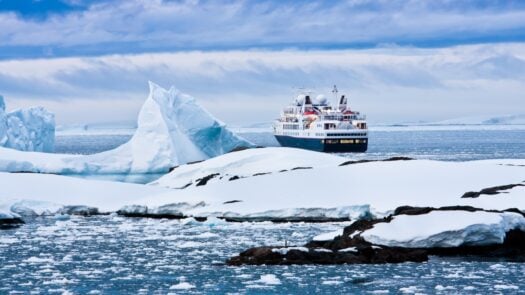
What Time of Year is Antarctica Warmest?
The warmest time of year to visit Antarctica is January, when daytime temperatures can reach 1°C (34°F). However, the other summer months of December, February and March boast similar temperatures. The entire summer season of December to March is considered the best time of year to go to Antarctica for cruises.
Keep in mind that fly-in cruises to Antarctica only run from December to February, as the rest of the year is too cold and prone to ice storms that make these expeditions impossible.
When to Visit Antarctica by Interest
What’s really special about Antarctica is the adventure, the unknown, the unpredictability. It’s like being on another planet. There’s no scenery, no colours – no sounds, really, unless you listen intently. You’re completely disconnected from everything, and you’re entering a whole new world. You’re surrounded by imposing, powerful landscapes, but you also realise just how fragile everything is.
Simply being in Antarctica is a stunning experience. However, some months offer truly spectacular highlights, and others bring such hostile weather that it’s not possible to visit at all. To help you choose when to visit Antarctica, we’ve put together a month-by-month guide to conditions and activities across the entire summer season.
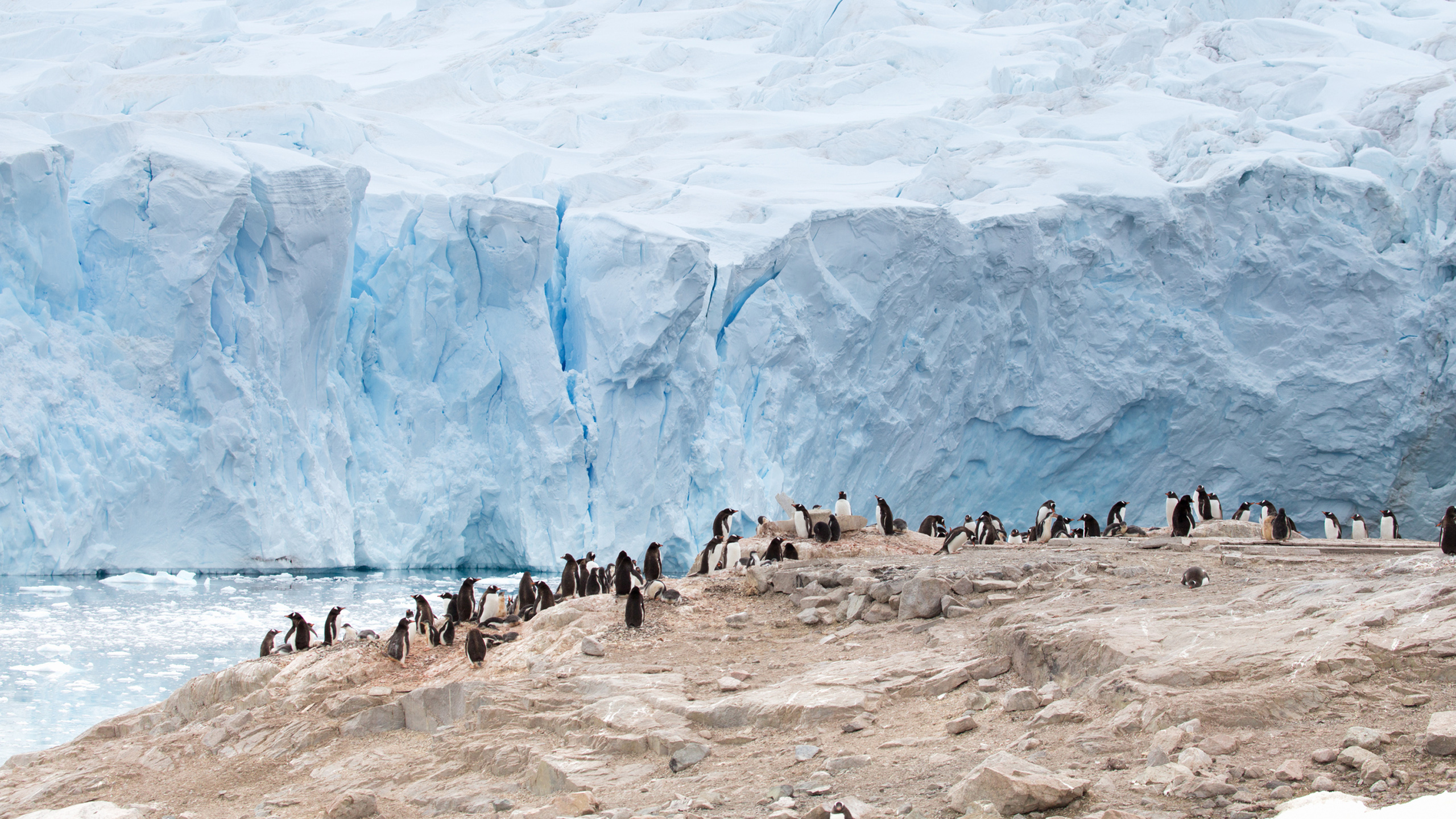
Best Month for Penguin Spotting
The best month to visit Antarctica for penguin spotting is November. This is when the penguins come ashore to breed, although they often stay until March. The landscape also tends to be more pristine and undisturbed in November, so it’s a special time to travel to Antarctica – especially for photographers.
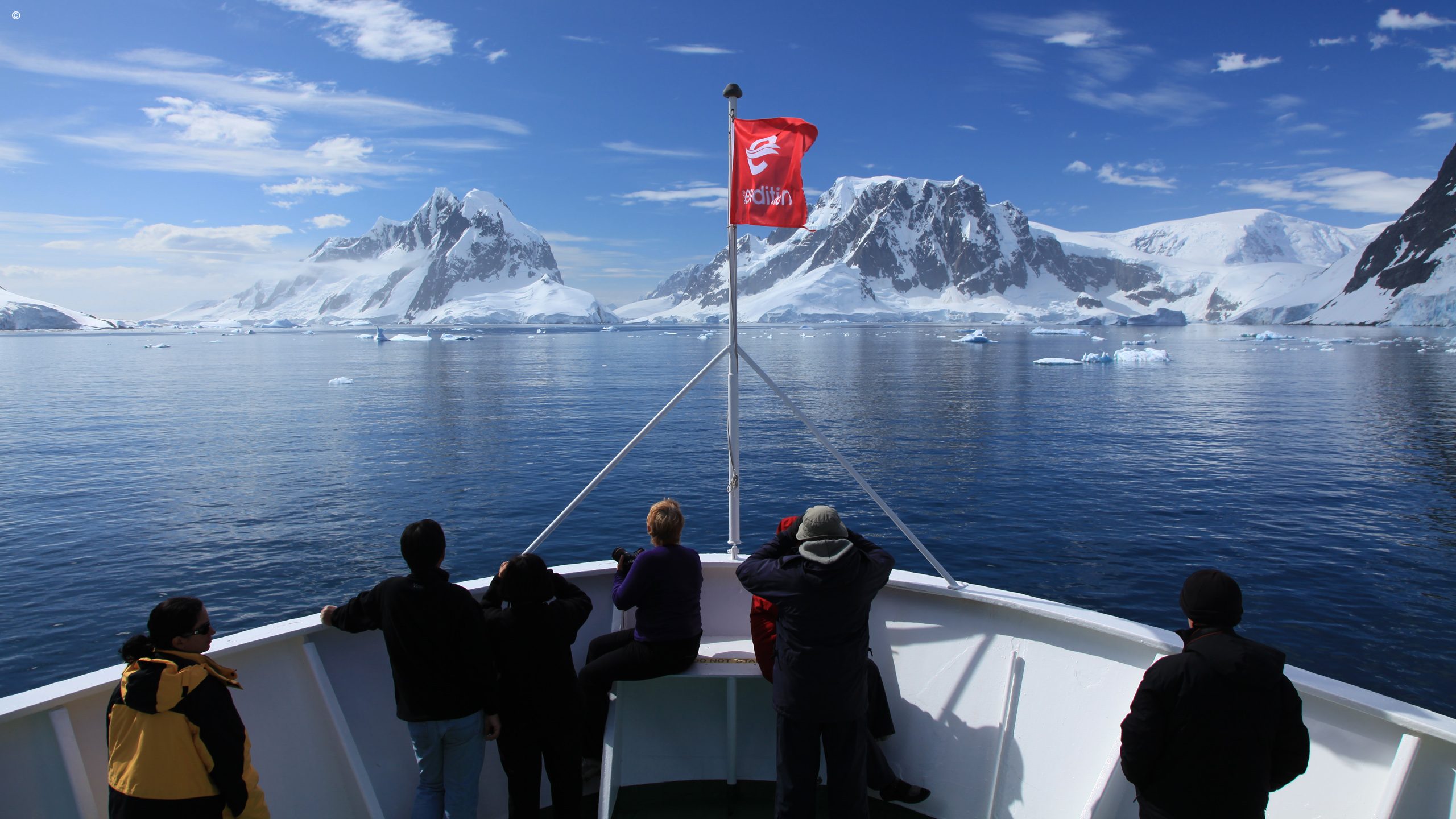
The Best Months for Sunlight
The best time to go to Antarctica for sunlight is summer (December to March), boasting over 20 hours of sunshine per day. Wildlife is most active during this season, so you can see animals like newborn seal pups, penguin chicks, whales and seabirds. These months also see the most visitors.
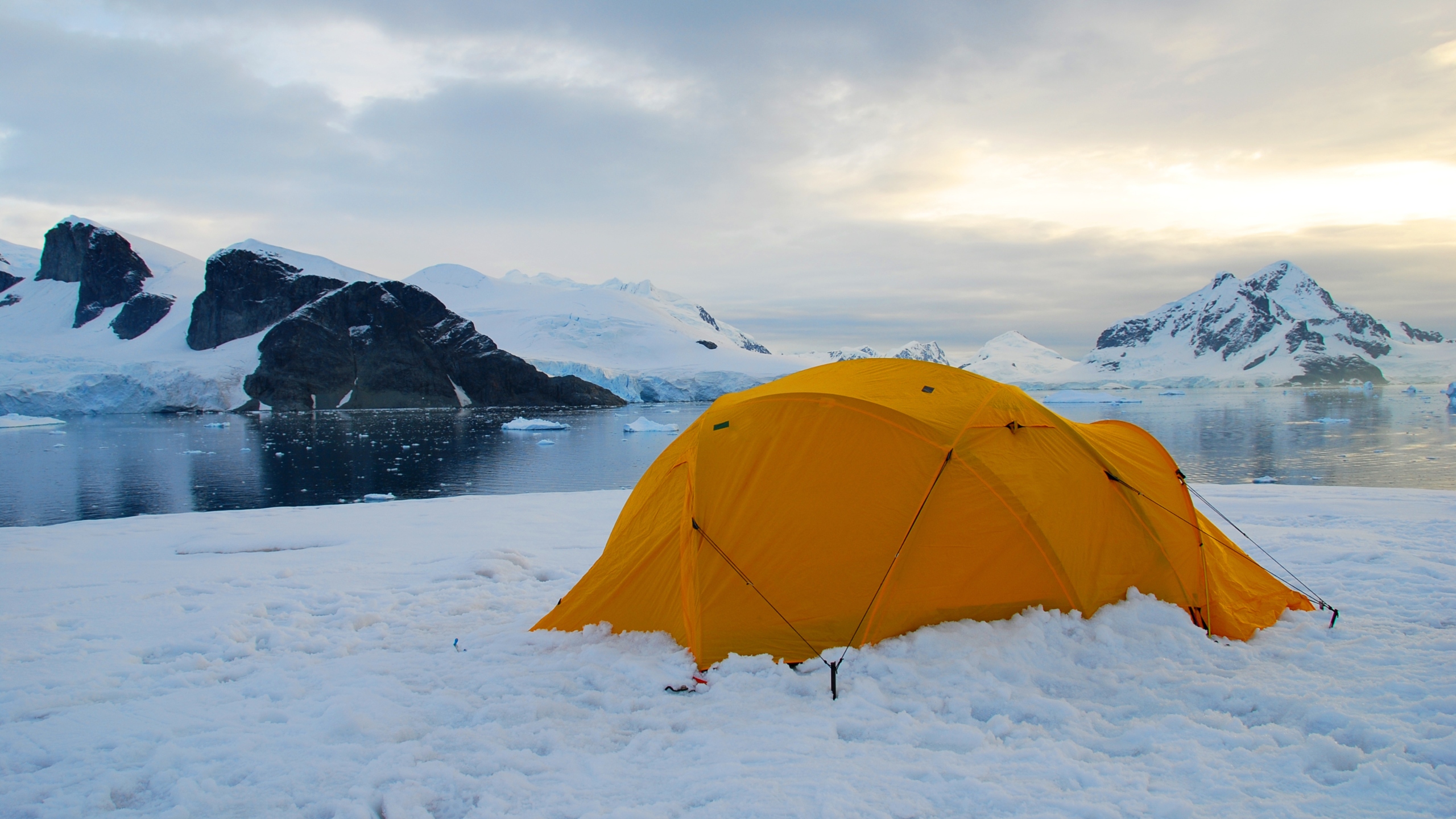
Best Months for Camping
The best months for camping on the Antarctic Peninsula are December to February, when it’s warmer and less windy. Although it might sound incredibly adventurous, anyone can go camping in Antarctica. The experience lasts just one night; you’ll spend around 10 hours on the ice before returning to the ship for breakfast.
Campers wear extra layers and sleep in small 2- to 3-person tents. If the weather is particularly calm, there’s even the chance to sleep completely outdoors in ‘bivvy’-style sleeping bags.
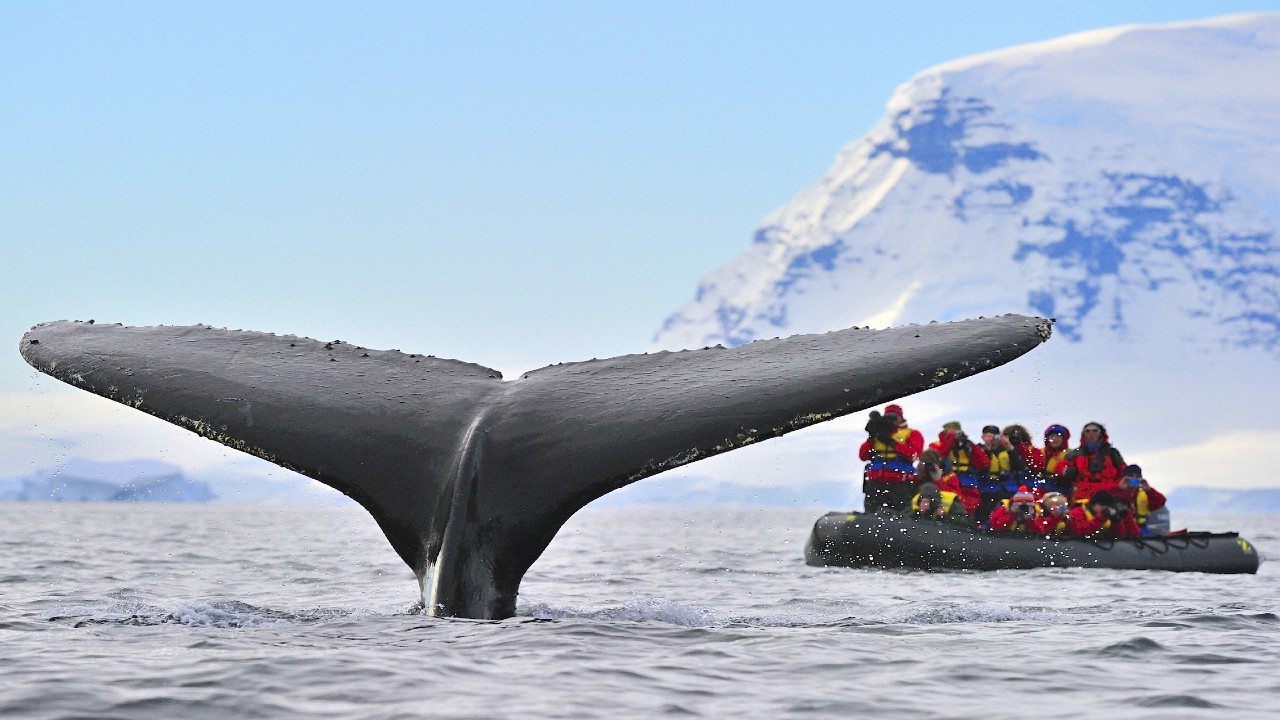
Best Months for Whale Watching
The best time to visit Antarctica to see whales is February to March, when you can spot species like orcas, sperm whales and humpbacks. This is when the whales migrate south to feed on krill. Humpbacks and orcas travel in huge pods, which can be an awe-inspiring sight.
Around March, the whales usually migrate north to seek out warmer waters for breeding and giving birth. Other animals also start leaving the Antarctic Peninsula during these months to avoid the cold temperatures.
How Many Days Are Enough in Antarctica?
We suggest spending 5–7 days in Antarctica itself, although the entire experience can be longer. For example, those who sail the Drake Passage from Argentina will need at least 4 extra days to get to and from Antarctica , sometimes amounting to 13 days on the ship altogether.
For a truly epic adventure crammed with wildlife and spectacular scenery, you can do an Antarctica cruise to the Falkland Islands and South Georgia. You’ll spend around 20 days on board the ship before disembarking in bustling Buenos Aires .
Trip Inspiration
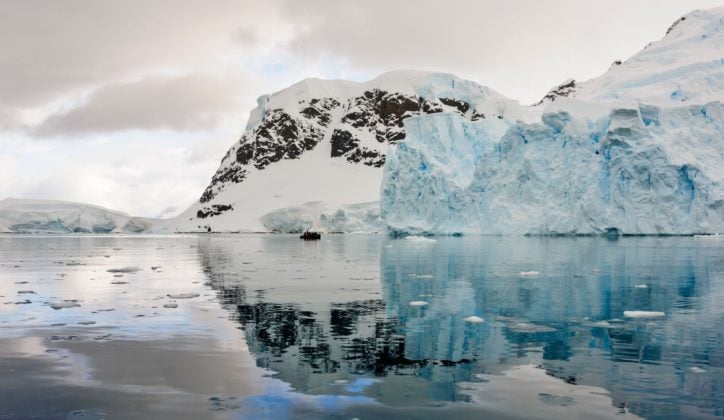
Where to Stay in Antarctica
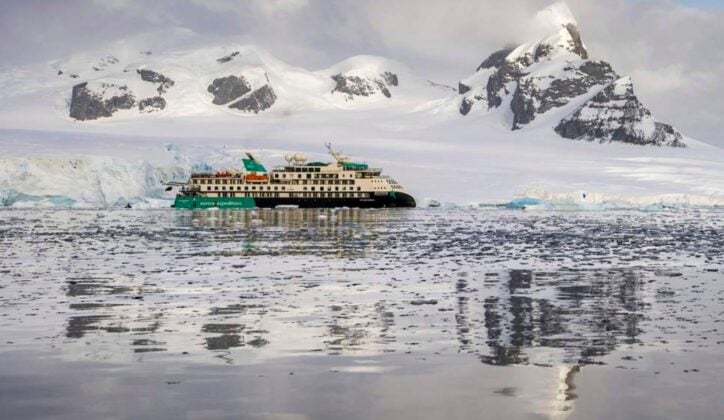
Whatever you want from your trip to Antarctica, our team of expert travel designers are ready to help.
1-800-240-3648

Book Incredible Cruises to Antarctica and the Arctic
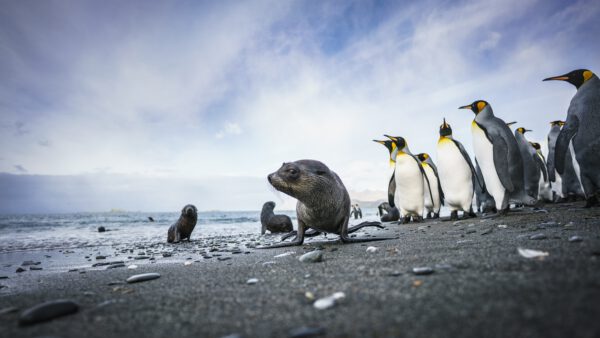
Visiting Antarctica in March
March is an excellent time to visit Antarctica for those looking to experience the region’s unique wildlife, landscapes, and science, without the crowds of the peak season. However, it’s essential to note that weather conditions in Antarctica can be unpredictable, so it’s always best to check with your travel provider before booking your trip
5 Reasons to Visit Antarctica in March
The weather in March can be slightly cooler than earlier in the season, with temperatures ranging from around -5°C to 3°C (23°F to 37°F). However, the weather is still relatively mild, and the days are still long, providing ample time for exploration.
Although the wildlife may start to become less active in March, there are still plenty of opportunities to see penguins, seals, and whales. It’s an ideal time for birdwatchers, as many of the migratory birds are still in the polar region .
There are plenty of activities to participate in during March. Hiking , mountaineering , skiing , helicopter rides, and more!
March is an ideal time to see the unique ice conditions in Antarctica, with the ice starting to break up and form stunning ice sculptures and icebergs.
March is an excellent time to see the Aurora Australis (Southern Lights) in Antarctica, as the nights are becoming longer, and the weather conditions can be optimal for viewing.
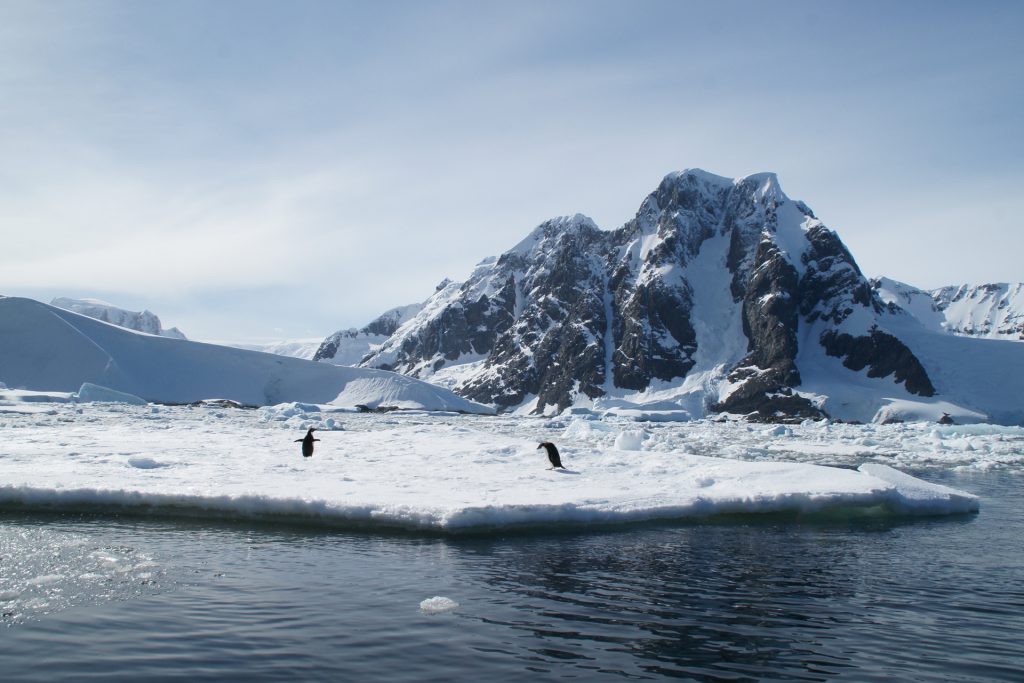
Ice breakup is happening now, perfect for viewing unique ice formations and activity!
Testimonials
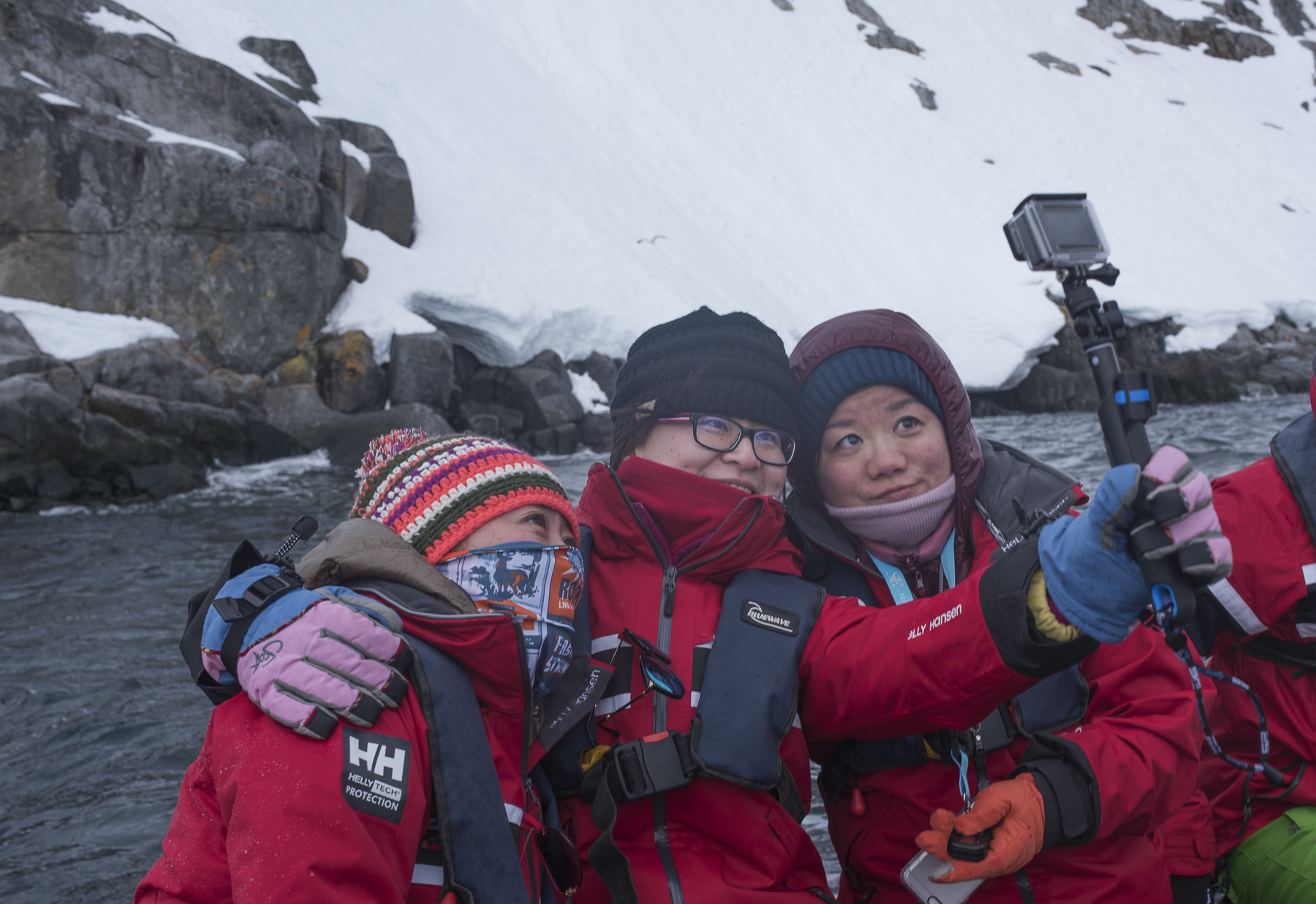
Antarctica Cruises in March
Atlantic odyssey, excl. antarctic peninsula, antarctica – beyond the polar circle – wilkins ice shelf, antarctica – elephant island – weddell sea – polar circle, ready to book your polar cruise in march.
Contact Polar Holidays to schedule a free consultation with one of our booking specialists today!
- 1-800-240-2648
- Privacy Policy
Change location
- UK / International
- Call toll-free until 8pm EDT 617-223-4521 617-223-4915 or
- REQUEST A QUOTE
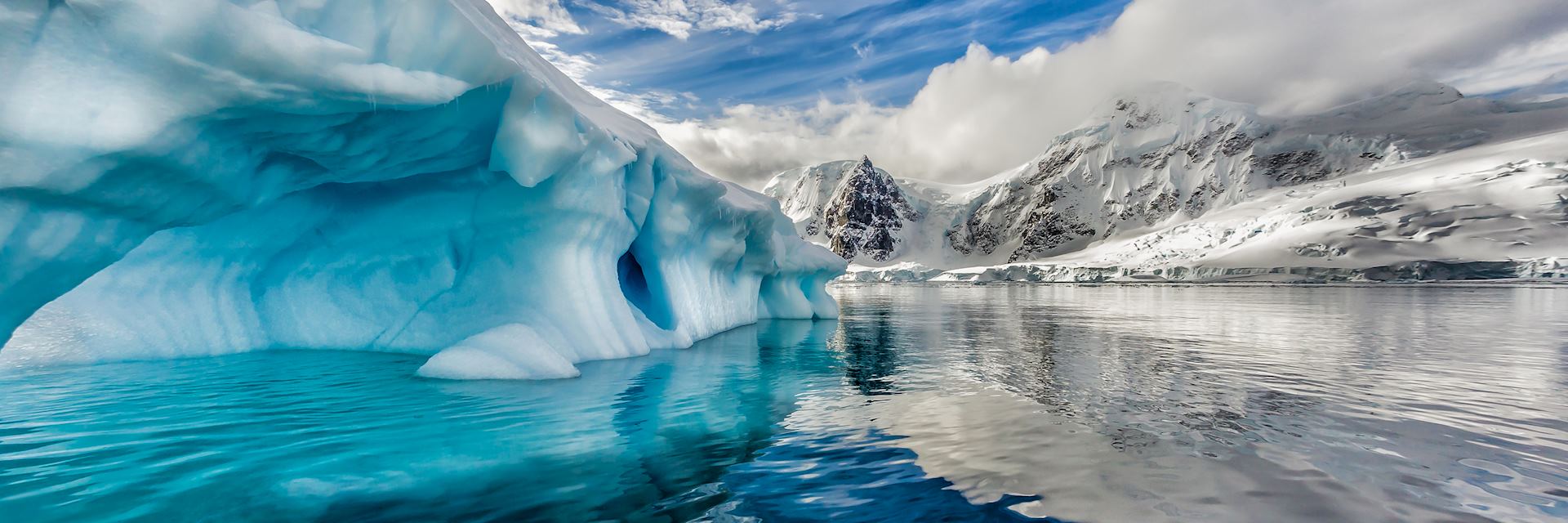
When is the best time to visit Antarctica?
- Month-by-month
The best time to visit Antarctica on an expedition cruise is between late October and late March — indeed, this is the only time when such travel is possible. These are the summer months in the Southern Hemisphere, with temperatures in Antarctica ranging from 39°F to 46°F.
This is also the calmest time of year to take on the infamous Drake Passage — the two-day sea crossing to get to and from Antarctica.
There are some variations in what you might see, with luck playing a large part, but whenever you go, it will be the trip of a lifetime.
- Make an inquiry
- Request a brochure
Month-by-month guide for traveling in Antarctica
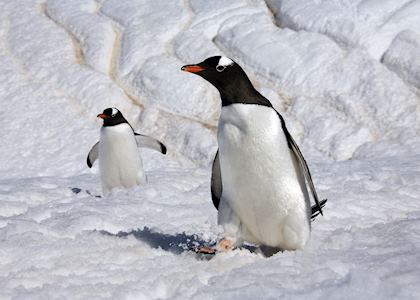
Visiting Antarctica in December - January
High summer in Antarctica. Days are long, the temperatures are at their ‘warmest’ and the penguins, seals and seabirds are active everywhere. Christmas and New Year is a very busy time for Antarctica cruise travel, so if you wish to travel at this time please plan well in advance.

Visiting Antarctica in February - March
These are the best months to see whales such as humpback, sperm and orca. Fledgling penguin chicks can be seen and seabirds are still abundant.

Visiting Antarctica in April - September
Winter in Antarctica — stormy seas, freezing temperatures and no possible way to visit.

Visiting Antarctica in October
Some cruises start to operate in late October, and the advantage of being a guest on one of the first trips of the season is seeing the start of the courting and mating season of the penguins of South Georgia and the Falkland Islands. Down near the Antarctic Peninsula you will need to push your way past the winter sea ice.
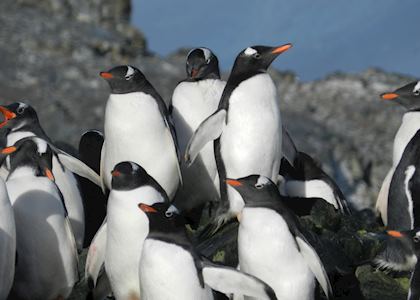
Visiting Antarctica in November
This time of year sees the winter ice further break up into stunning icebergs and sculptures. Wildlife courtship rituals continue, including male seals establishing their breeding beaches, and wildflowers are in bloom in South Georgia and the Falklands .
Antarctica Climate Guide
Why travel with audley.
- 100% tailor-made tours
- Fully protected travel
- Established for over 25 years
- 98% of our clients would recommend us

Travel advice
Practical tips for traveling to Antarctica, from social protocols to guidance on money matters, with a link to the latest US State Department travel advice.

Request our brochure
Covering all seven continents, The World Your Way shows you how you can see the world with us. It features trip ideas from our specialists alongside hand-picked stays and experiences, and introduces our approach to creating meaningful travel experiences.
Trip ideas and travel guides for exploring Antarctica
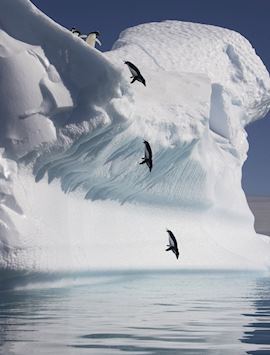
Antarctic Peninsula cruise
13 days from $12,235pp
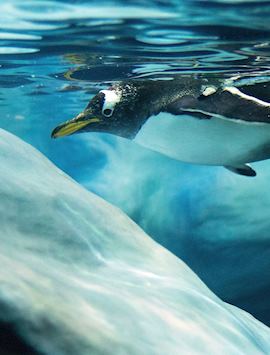
Antarctica & Patagonia tour
18 days from $17,835pp
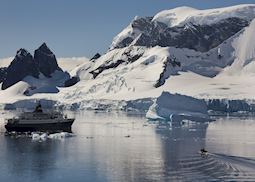
Antarctic expedition cruises
10 min read
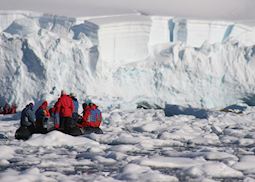
Activity vacations in Antarctica
Ask LP: how can I travel to Antarctica?

Oct 7, 2020 • 3 min read
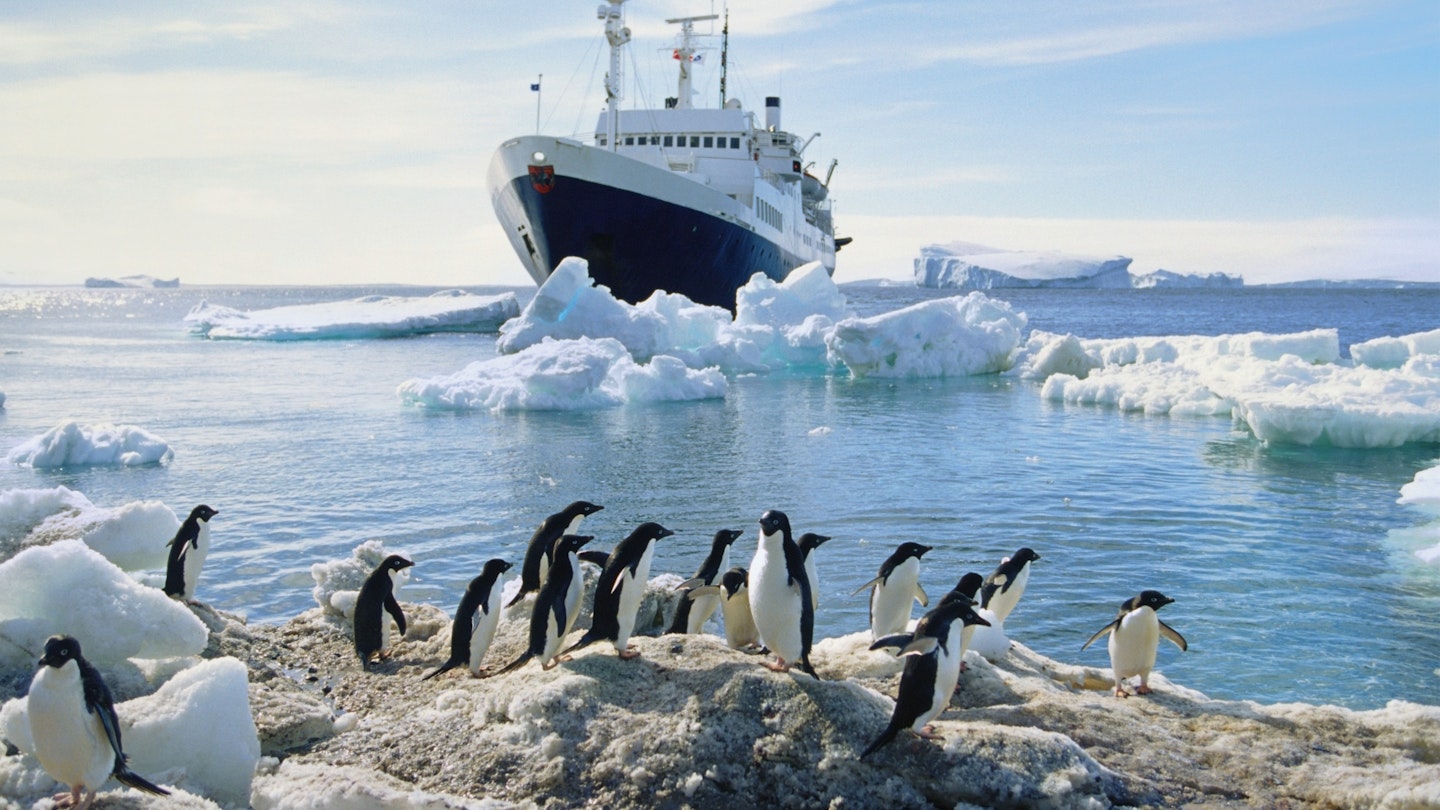
Antarctica's tourist season starts in November © DreamPictures / Getty Images
The far south of the world may have escaped the pandemic that’s locked down life elsewhere, but that doesn’t mean this summer season is smooth sailing. Antarctica has no cases of COVID-19 – partly due to efforts to keep it that way, and partly reflecting the restrictions placed on other countries. This impacts scientists who make up the temporary residents of the continent and also threatens the Antarctic tourist season, which generally runs from November to March or April.
In a normal year, travelers would converge on Ushuaia (Argentina), Punta Arenas (Chile), and, less frequently, ports in New Zealand and Australia to embark on the long journey south. The shortest route – across the swells and choppy waters of the Drake Passage from South America – takes two to three days to reach the Antarctic Peninsula . Air options like DAP’s overnight trips to King George Island in the South Shetland Islands ($6500 per person from Punta Arenas, Chile) usually gives another way to reach the far south from South America for a more limited time. Services are currently suspended.

There are two big obstacles to getting to Antarctica this year. One is the lack of cruises – most operators have cancelled their schedules for the remainder of the this year and early next year. If cruises can happen at all this season it will be towards the end of the usual period of operation. Hurtigruten has cancelled Antarctica departures until January 2021, but hopes to resume operations then.
The other is the inaccessibility of gateway destinations. At the time of writing there’s no way into Chile , Argentina , New Zealand and Australia for foreign tourists. All these countries have closed their borders to non-nationals since March, and Argentina has recently paused plans to allow international flights back into the country until at least October 11. In all likelihood, this will be longer. Sub-Antarctic destinations have their own entry restrictions. The Falkland Islands (Islas Malvinas) are only accessible for essential travel with reduced air links. In order to reach Antarctica, any departing travelers heading south would need to transit Argentina (or one of the other jumping-off countries) and transfer directly to their cruise ship. As you’d expect there’s no confirmed plan for this at present.
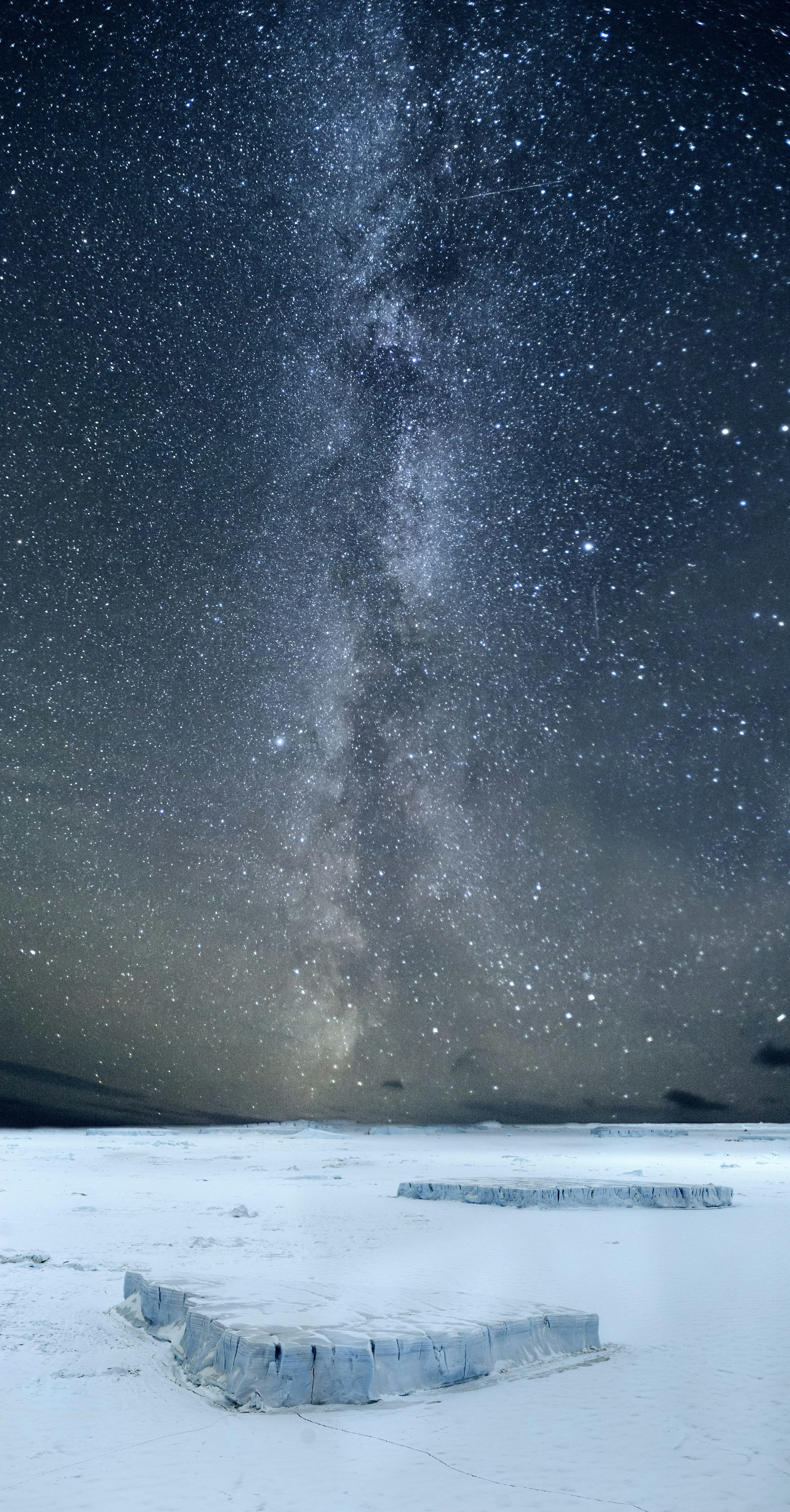
Adding all this up, 2020–21 may be a better time to save for a future Antarctic odyssey. However knock-on demand for 2021–22 is likely to be strong, as capacity is always limited and there is an Antarctic solar eclipse in November next year. That said, specialist travel companies are also keen to encourage booking, and deals for next year are available through experts like Discover the World .
One way for ice-cap enthusiasts to get their fix from Australia is to take a seat on one of the scenic overflights of the continent run by Antarctica Flights . These 12 hour journeys – using a 787 Dreamliner for the first time – depart from various Australian airports from November to March. They don’t touch down and therefore count as a domestic charter flight. Currently there is not a requirement to wear a mask on these flights.
You might also like:
Is it sustainable to visit Antarctica? How to pack for a trip to Antarctica The eternal lure of icebergs: fulfilling a life-long dream of visiting Antarctica
Explore related stories

Destination Practicalities
Mar 30, 2024 • 4 min read
Who wouldn't jump at the chance to visit the Emerald Isle? Here’s how to check if you need a visa before setting off on your Irish adventure.
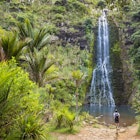
Mar 15, 2024 • 17 min read

Mar 2, 2024 • 8 min read
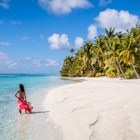
Jan 24, 2024 • 8 min read

Jan 23, 2024 • 4 min read

Jan 17, 2024 • 8 min read

Jan 15, 2024 • 7 min read
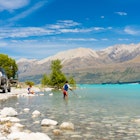
Jan 9, 2024 • 6 min read
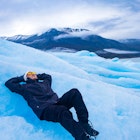
Jan 8, 2024 • 11 min read

Jan 7, 2024 • 3 min read

Passing Thru Travel
Top 5 Luxury Expeditions to Antarctica 2024
Posted: March 11, 2024 | Last updated: March 11, 2024
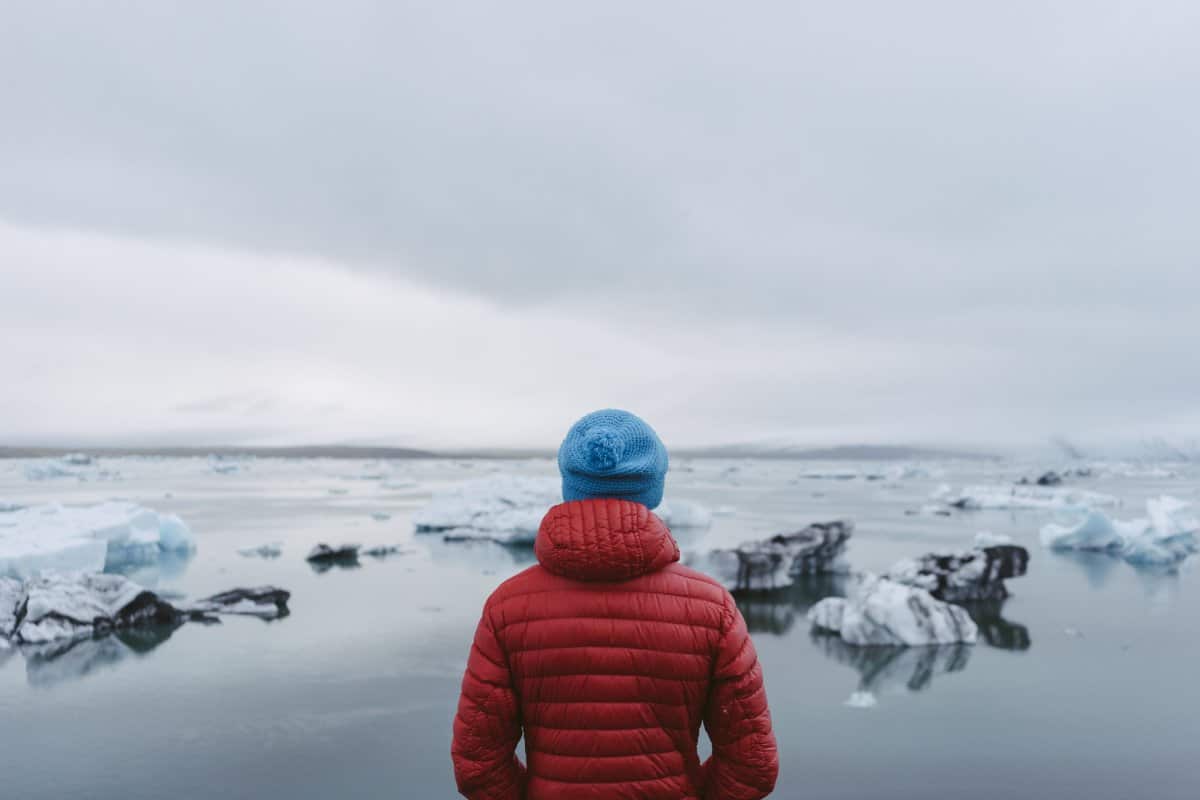
Though most people don’t think of Antarctica as the destination for their next vacation, it is still pristine, remote, and filled with almost otherworldly beauty. Whether it’s untouched ice landscapes, unique wildlife encounters, or the surreal experience of visiting the Earth’s southernmost continent, there is far more to visiting Antarctica than you might initially expect.
There is an excellent opportunity for those looking for more luxury expeditions in this harsh and remote environment. These expeditions provide unparalleled comfort and style, making the inaccessible accessible without compromising the spirit of adventure. Today, we will journey with the top luxury expedition cruises to Antarctica to learn more about their unique offerings and features that often focus on sustainable travel practices to preserve Antarctica’s fragile ecosystem.
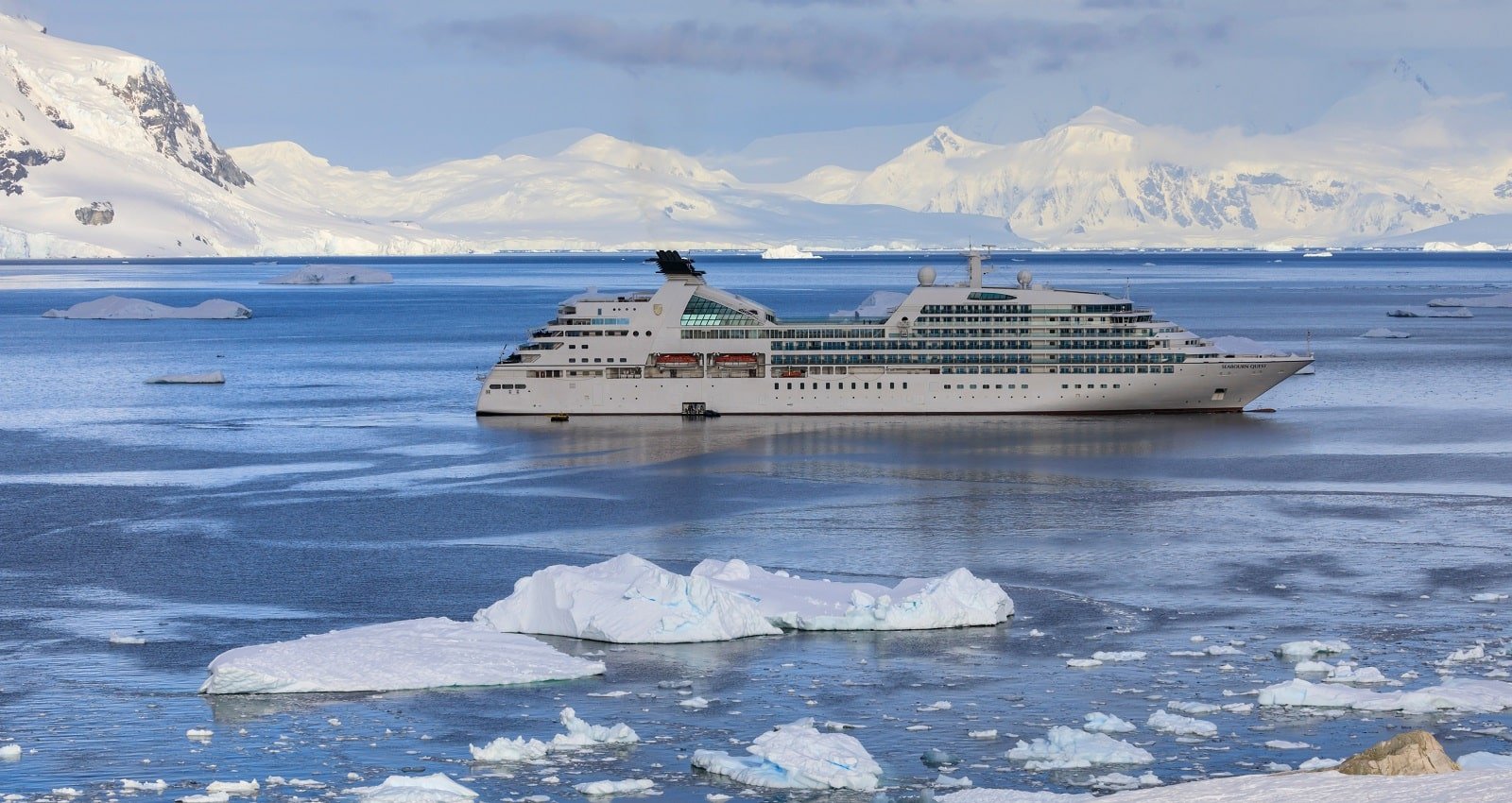
1. Seabourn Antarctica Cruises
For our journey’s first leg, we will be cruising the Antarctic Peninsula with 132 ocean-front suites, luxurious amenities, and custom-built submarines for underwater exploration. The Seabourn Antarctica Cruises represent the evolution of luxury expedition cruising, offering the perfect blend of adventure and opulence.
On this cruise, you will also find spectacular views of icebergs, glaciers, and marine wildlife. The best time to set out on this particular cruise is the austral summer months (November to March) for wildlife viewing and milder temperatures. Just ensure you don’t miss out on the once-in-a-lifetime opportunity to explore beneath the ocean’s surface in one of their state-of-the-art submarines.
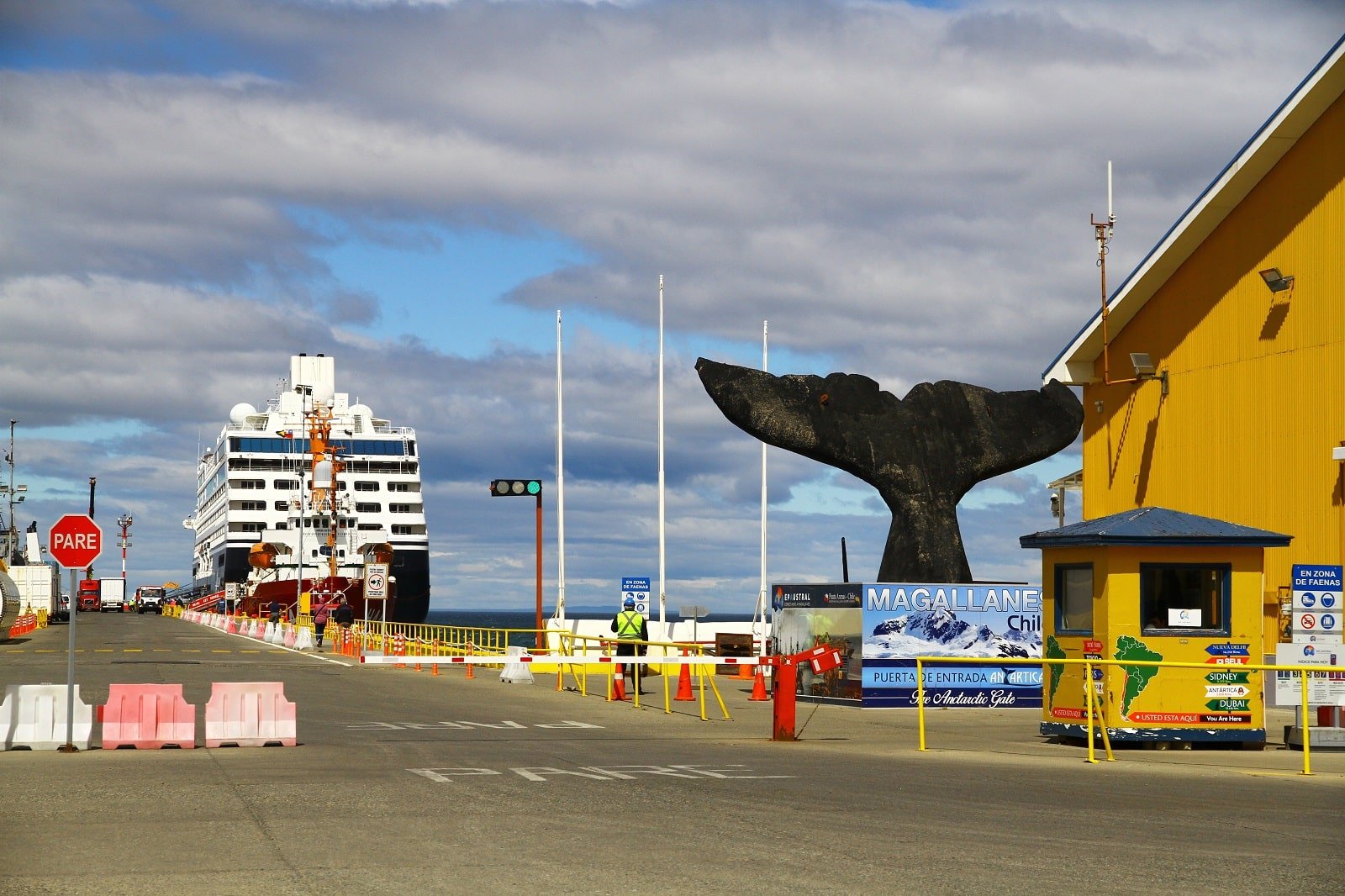
2. Magellan Explorer
Next, we’re off to the Magellan Explorer, which specializes in Antarctic air cruises, departing primarily from Punta Arenas, Chile. The Magellan Explorer is a modern expedition vessel with private balconies, a range of cabin categories, and state-of-the-art facilities. Explicitly designed for Antarctic air cruises, this experience provides a faster and more direct route to the continent than most of its competitors.
The Magellan Explorer offers an aerial view of the Arctic and a unique lens for Antarctic wildlife and dramatic landscapes. The peak season is during the austral summer months, especially December and January, for the 24-hour daylight provided. For the ultimate experience, opt for a cabin with a private balcony for unparalleled views of the Antarctic scenery.
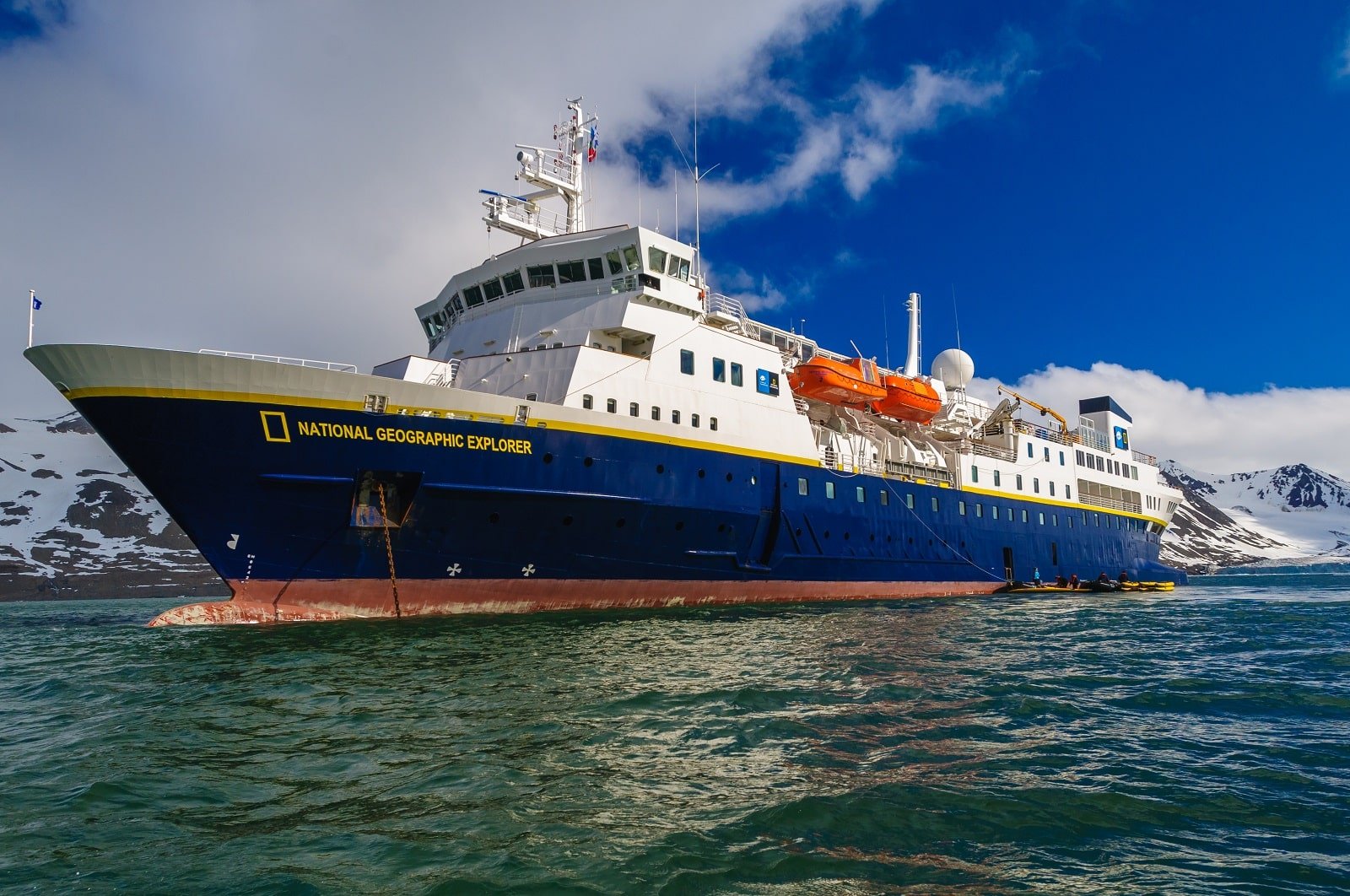
3. National Geographic Explorer
We’re off to National Geographic Explorer for their expedition cruises along the Antarctic Peninsula. Part of the National Geographic fleet, known for its focus on exploration and education for travelers looking to balance their arctic adventure with a proper understanding of this wild tundra. These expeditions offer a range of activities like kayaking, hiking, photography workshops, and expert-led educational programs.
The surroundings of your expedition will be rich in wildlife encounters, including whales and penguins and stunning ice formations. The best time to visit is from November to March, with each month offering different experiences, from icebergs in November to wildlife in December to January. Just don’t forget to participate in the photography workshops by National Geographic experts to capture stunning Antarctic images.
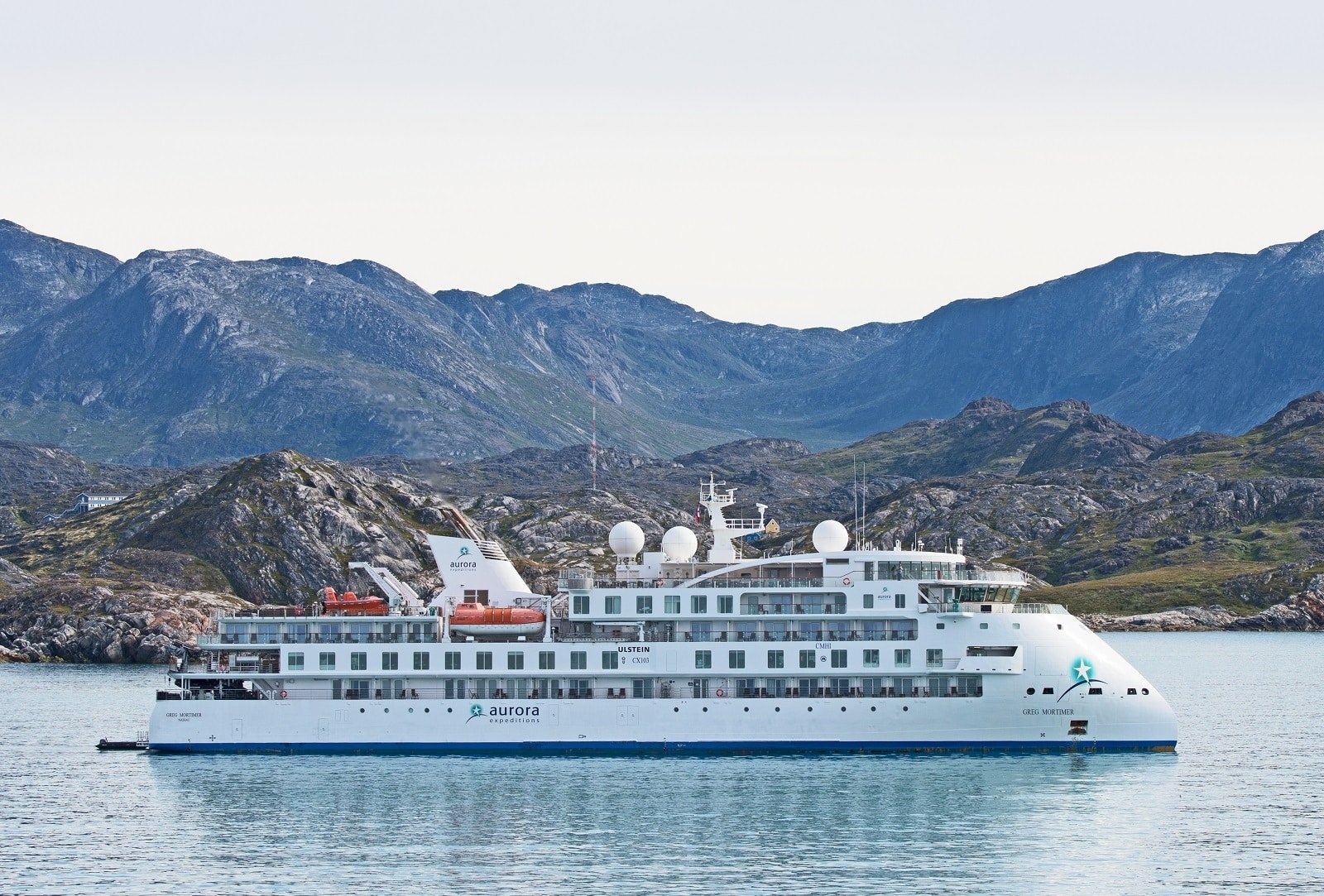
4. Greg Mortimer
Named after a renowned Australian mountaineer, our next ship embodies the spirit of adventure. The Greg Mortimer cruises the Antarctic Peninsula and beyond with a variety of activities like kayaking, camping, and even stand-up paddle boarding. On the journey, diverse experiences range from crossing South Georgia to observing glaciers and icebergs.
For the best experience, go in the Antarctic summer, with different wildlife sightings possible each month. Make sure to try the unique experience of camping on the Antarctic ice for an unforgettable night in one of the least explored regions of the Earth.

5. Sea Spirit
For our last destination, we’re headed to the Sea Spirit for its expeditions along the Antarctic Peninsula. The Sea Spirit is known for its intimate and luxurious atmosphere focused on providing a more personal and immersive Antarctic experience. With kayaking, camping, and wildlife photography facilities, you’ll experience close-up encounters with penguins, whales, and dramatic ice landscapes.
The best time to embark on this journey is from November to March, with the late season (February to March) being less crowded and offering unique wildlife sightings. For this trip, use the ship’s smaller size for more intimate and less crowded landings.
More Articles Like This…
Barcelona: Discover the Top 10 Beach Clubs
2024 Global City Travel Guide – Your Passport to the World’s Top Destination Cities
Exploring Khao Yai 2024 – A Hidden Gem of Thailand
The post Top 5 Luxury Expeditions to Antarctica 2024 republished on Passing Thru with permission from The Green Voyage .
Featured Image Credit: Shutterstock / Piotrek Golemo.
For transparency, this content was partly developed with AI assistance and carefully curated by an experienced editor to be informative and ensure accuracy.
More for You
Here's What Happens When You Keep a Car For Over a Decade
ESPN's Molly Qerim Sparks Outrage With Caitlin Clark Jab
17 McDonald's Menu Items From The 1980s You Probably Forgot About
50 delicious slow cooker recipes that will make your week so much easier
36-year-old brought in $77,000 in passive income from Etsy in 2023—she spends 5-10 minutes per day on it
How Long Does Rice Last in the Fridge?
Homeowner struggles with HOA over $1 million insurance requirement for EV charger: 'It has been impossible to get this'
Fact Check: The Truth About Claims That Mark Wahlberg and Mel Gibson Are Launching 'Non-Woke' Film Studio
6 Of The Worst Things To Order At Subway, According To Employees
Pop-Tarts Is Launching a First-Of-Its-Kind Crunchy Snack
I’m a Bank Teller: 8 Biggest Money Deposit Mistakes I See People Make Daily
71 Super Fresh and Easy Summer Recipes
Sergio Garcia’s 6-word Masters warning goes viral as LIV Golf ascends upon Augusta National
I bought 2 Airbnb tiny houses and put them in my yard. It started as an easy way to make extra cash — now it's my primary source of income.
19 American Foods that Are Not Allowed in Other Countries
Amid racist insults, ‘Bachelor’ contestant Rachel Nance won’t apologize for her culture
Illinois Hit by Mass Layoffs as Four Factories Close
Arby’s Is Giving Away Free Sandwiches All Month Long
Fox News rejects White House demands to retract Easter egg stories
Wyoming Governor Vetoes Concealed Carry Bill, Sparking Heated Debate

IMAGES
VIDEO
COMMENTS
March in Antarctica is a great time to watch penguin chicks swimming in shallow pools. They are also very curious at this age and many chicks will approach onlookers without fear. March is the best time to see king penguin colonies on South Georgia. Thousands upon thousands of the brightly colored penguins fill the large bays.
5 Reasons to Visit Antarctica in March. You are guaranteed great whale encounters - February and March are the best months for whale watching. The penguin chicks are very curious towards visitors and are often drawn to the colour yellow in particular. It's a popular month for photographers, with the sun now lower in the sky and wonderful ...
Dr. Roger Kirkwood. March is 'late-season' for voyages to Antarctica: night times grow out of the endless summer days; the air freshens; dustings of snow can cover the land, and the sea surface can freeze with a thin crust of ice. Most other ships have left the scene so all landing sites are available. It's fantastic - you have the real ...
Many would consider late December or early January to be the best months to visit Antarctica. Weather conditions are at their most favorable, with warm temperatures, low levels of pack ice, and long daylight hours. Wildlife is also very active, both in Antarctica and on neighbouring islands like South Georgia.
The best time to visit Antarctica is from mid-December through mid-February. The best month to take an Antarctic cruise is January. Of course, there is much more to it than that. The Antarctic travel season is short. Weather, wildlife, sunlight and sea conditions vary greatly between spring, summer and fall.
The brief summer season runs from November through to March, and this is the best time to visit Antarctica and the only time to visit! But within this travel window, your experience can vary from month to month. At the start and end of the season, you'll need to endure rough seas, but you'll have the chance to see enormous icebergs.
When the northern hemisphere is descending deeper into darkness, Antarctica is experiencing nearly 24 hours of sunlight — which means expeditions typically take place between late November and early to mid-March. Here are the best times to visit Antarctica for the activities likely to be on your bucket list. The best times to see wildlife
During autumn and winter much of Antarctica's coastline is impenetrable due to thick ice and temperatures that can drop to -60 degrees. The best time to cruise to Antarctica is during the Antarctic summer from November to March, when you'll see Antarctica's wildlife at its busiest and benefit from up to 24 hours of daylight.. Due to strong demand and the relatively modest number of ships ...
November - March is the short expedition season. This is not only the best time to visit Antarctica, it is the only time it's possible - as the ice breaks up allowing ships to pass. The continent is colder but at its most untouched, with pristine ice and snow, and wildflowers blooming on the islands.
December. December is arguably the best month to visit Antarctica, with temperatures approaching their warmest (by Antarctic standards), long hours of daylight and wildlife active everywhere. It's also the most expensive time to visit, particularly over Christmas and New Year, when flights between the UK and Argentina are at their dearest.
November. December. January. February. March. Deciding on the Best Time to Visit Antarctica. For a good chunk of the year—the roughly six months of the austral winter—Antarctica is utterly frigid, storm-wracked, and dark. Some hardy scientists tough out this most unforgiving global manifestation of wintertime, but this is (understandably ...
The best time to visit Antarctica to see wildlife is between November and March during the summer, which coincides with the expedition cruising season. Due to the extreme temperatures during the winter, most of the wildlife leaves Antarctica, except a few species, such as the Emperor and Adelie Penguins, due to its inhospitable climate.
February and March are the best months to see whales in Antarctica, as they enjoy a buffet feast on the abundant krill. Watch for leopard seals resting on the ice near penguin colonies. Like autumn in many destinations, fall brings bursts of colour with vibrant splashes of pink and green dotting the ice.
The Antarctic coasts - where you will most likely visit - hover around 0°C (32°F) from October to March. Therefore, any time after the first full sunrise in August until late March should be a great time to visit. With 24 hours of daylight and the arrival of penguin chicks, December is peak time for Antarctic cruises.
That said, if you want to visit Antarctica on a traditional cruise line, many major carriers can get you there — often on vessels that adhere to that fewer-than-200-guests rule of thumb. Some ...
The best time to visit Antarctica is during the summer months of November to March, when the weather is warmer, the days are longer, and the wildlife is most active. This is also the time when the ice conditions are most favorable and the continent is most accessible. However, if you are on a tight budget, you may want to consider visiting ...
The best time to visit Antarctica is during the summer. The season, locally known as the Austral summer, lasts six months, from October to March. It gives a large window for traveling to the continent. There are many things to expect during these months, and you may have preferences based on which month to visit.
December: December is excellent for warmer weather and seeing penguin chicks! Many would say that December is the best month to visit Antarctica. Temperatures are getting warm (by Antarctica standards, that is). The sun barely sets, so you get long days, and the wildlife is at its most active.
The Best Times to Visit Antarctica. Travelers hoping to visit Antarctica have a few months to do so, as cruise ships only operate during the summer months, which, in Antarctica, is from November to April. ... March and April are peak whale-watching months off the coast of Antarctica. During this time, you can spot fin, humpback, minke, orca ...
The best time to visit Antarctica is between December and March, due to milder temperatures of around 0ºC (32ºF), and greater likelihood of spotting wildlife like penguins and whales. The first journeys of the year begin in November and, if you're visiting the Falklands and South Georgia, can run until early April.
Experience the beauty of Antarctica cruises in March 2024 with Polar Holidays. Enjoy the White Continent's wonders. Book your adventure now! Facebook-f Instagram. 1-800-240-3648. ... March is an excellent time to visit Antarctica for those looking to experience the region's unique wildlife, landscapes, and science, without the crowds of the ...
The best time to visit Antarctica on an expedition cruise is between late October and late March — indeed, this is the only time when such travel is possible. These are the summer months in the Southern Hemisphere, with temperatures in Antarctica ranging from 39°F to 46°F. This is also the calmest time of year to take on the infamous Drake ...
There are two big obstacles to getting to Antarctica this year. One is the lack of cruises - most operators have cancelled their schedules for the remainder of the this year and early next year. If cruises can happen at all this season it will be towards the end of the usual period of operation. Hurtigruten has cancelled Antarctica departures ...
These expeditions provide unparalleled comfort and style, making the inaccessible accessible without compromising the spirit of adventure. Today, we will journey with the top luxury expedition ...
Sea-level rise originating from Antarctica will affect Australia and Oceania, but it will also disproportionately affect North America. ... or visit our climate-change hub ... Leaders March 30th 2024.
California's world-leading climate policies have led the state to exceed its 2020 emissions reduction target four years ahead of schedule and created partnerships across the U.S. and around the world. California currently has over 40 memorandums of understanding with countries on all continents except Antarctica. ###
KPMG LLP (KPMG) is pleased to invite you to a one-hour TaxWatch Webcast that will explore the IRS Advance Pricing and Mutual Agreement program, discuss the benefits of APAs for companies seeking cross-border tax certainty, and address major updates to APA programs globally. KPMG speakers Cameron Taheri, Tomotake Naka, Jessie Coleman, and Lillie ...
California's world-leading climate policies have led the state to exceed its 2020 emissions reduction target four years ahead of schedule and created partnerships across the U.S. and around the world. California currently has over 40 memorandums of understanding with countries on all continents except Antarctica. ###